- Analytics
- News and Tools
- Market News
CFD Markets News and Forecasts — 18-05-2023
- USD/JPY has shown a solid recovery above 138.60 despite higher-than-projected Japan inflation.
- Japan’s National headline CPI jumped to 3.5% while core CPI accelerated to 4.1%.
- Market sentiment is quite upbeat amid optimism for US debt-ceiling raise.
The USD/JPY pair has rebounded firmly to near 138.68 as the Statistics Bureau of Japan has reported higher-than-anticipated inflation numbers (April). National headline Consumer Price Index (CPI) jumped to 3.5% from the prior release of 3.2% while the street was anticipating a deceleration to 2.5%. Core CPI that excludes food and energy prices accelerated to 4.1% vs. the consensus of 3.4% and the former release of 3.8%.
Despite a jump in Japan’s inflation, the Bank of Japan (BoJ) would favor a continuation of ultra-dovish monetary policy to keep inflation steadily above 2% for a longer period.
Earlier this week, Japan’s Gross Domestic Product (GDP) showed a decent rise in Q1 numbers. Preliminary Q1 GDP accelerated by 0.4% vs. the estimates of 0.1%. In the last quarter, the GDP growth remained stagnant. Japan’s Economy Minister Shigeyuki Goto cited “Economy likely to continue moderate pickup ahead due to improving sentiment, wage hikes and strong corporate appetite for investment.
Meanwhile, S&P500 futures have continued their two-day winning performance in the Asian session, portraying a strong risk appetite of the market participants. The rationale behind the positive market sentiment is the optimism for the US debt-ceiling raise as related parties have admitted that there is no alternative to escalating the US borrowing cap to avoid a default by the US Treasury in addressing obligated payments.
The US Dollar Index (DXY) is struggling in extending its rally further above 103.63, however, the upside seems favored as investors are anticipating that more liquidity flush into the United States economy through an increase in the US borrowing limit could cause a rebound in inflation and might force the Federal Reserve (Fed) to raise interest rates further.
- Gold price grinds near seven-week low, bears take a breather after three-day downtrend.
- Optimism about United States debt ceiling talks, hawkish Federal Reserve comments underpin USD strength and weigh on XAU/USD.
- Recent challenges to US debt limit extension, US-Taiwan trade deal prod the Gold price.
- Fed Chair Powell’s speech, Sunday’s press conference of US President Biden will be crucial for the Gold price direction.
Gold price (XAU/USD) licks its wounds at the multi-day low amid Friday’s sluggish Asian morning as the market’s previous optimism fades amid recent challenges for the key risk catalysts. Even so, the optimism surrounding the United States debt ceiling passage and the hawkish Federal Reserve (Fed) bets are strong enough to prod the XAU/USD bulls ahead of Fed Chair Jerome Powell’s speech. That said, the Gold price steadied near $1,960 by the press time, after falling to the lowest levels since April 03 the previous day during its three-day downtrend.
Gold price nosedives on strong United States Treasury bond yields, US Dollar
Gold price bears the burden of the strong United States Treasury bond yields and the US Dollar as it stays near the multi-day low marked the previous day. That said, hawkish Fed bets and favorable US data join the concerns that the US policymakers will be able to extend the debt ceiling seem to underpin the recent run-up by the US T-bond yields and the USD, which in turn weigh on the XAU/USD.
Talking about the data, US Initial Jobless Claims for the week ended on May 12 dropped to 242K on Thursday, versus 254K expected and 264K prior whereas the Philadelphia Fed Manufacturing Survey gauge for May improved to -10.4 from -31.3 prior, versus -19.8 market forecasts. Further, US Existing Home Sales for April eased to 4.28M versus analysts’ estimations of 4.3M and 4.44M prior. It’s worth noting that the US Retail Sales and Industrial Production for April printed upbeat figures earlier in the week and inspired the Fed hawks to defend their “higher for longer rates” bias, which in turn allowed the US Dollar to regain its power and drown the Gold price.
In a case of the Federal Reserve officials’ comments, Dallas Federal Reserve President Lorie Logan said on Thursday, as reported by CNBC, that data at this time does not support skipping an interest rate hike at the next meeting in June. On the same line, Fed Governor Philip Jefferson said on Thursday that inflation remains too high whereas St Louis Fed President James Bullard reiterated his support for higher rates and exerting downside pressure on the XAU/USD price.
Due to the aforementioned catalysts, the market’s bets on the Fed rate cuts in 2023 drop heavily in recent days while the odds of a 0.25% rate hike in June gained acceptance, even with little speed. The same allows the US Dollar and yields to remain firmer and please the XAU/USD bears. That said, the US Dollar Index (DXY) jumped to the highest levels since March 20 while the US 10-year and two-year bond coupons jumped to the March 15 tops. Further, Wall Street closed on the positive side amid cautious optimism in the market.
Elsewhere, the latest speeches from US President Joe Biden and Republican US House Speaker Kevin McCarthy keep markets hopeful of witnessing no default of the US in paying its government debt. The same allows the Gold price to drop amid a firmer US Dollar.
Challenges for US President Biden, fears of Sino-American tensions prod Gold bears
Contrary to what’s mentioned above, the latest challenges for US President Biden in avoiding the US default and the likely escalation in the US-China tussles due to the trade deal between the US and Taiwan seem to put a floor under the Gold price. Adding strength to the XAU/USD recovery could be the market’s anxiety ahead of Federal Reserve Chairman Jerome Powell’s speech.
As markets turn optimistic about no US default, backed by the latest speeches from US President Joe Biden and Republican US House Speaker Kevin McCarthy, Reuters came out with a warning note while citing the powerful group of the US decision-makers, namely the House Freedom Caucus. “The small but powerful Republican faction warned this week that they could try to block any agreement to raise the $31.4 trillion debt ceiling from passing the House of Representatives, if the accord does not contain ‘robust’ federal spending cuts,” said the news.
On the other hand, the US Trade Representative's (USTR) office announced on Thursday that The US and Taiwan reached an agreement on the first part of their ‘21st Century’ trade initiative, covering customs and border procedures, regulatory practices, and small business. This comes ahead of planned meetings between China's Commerce Minister Wang Wentao and USTR Tai and US Commerce Secretary Gina Raimondo, which in turn can propel the Sino-American tension and prod the US Dollar advances, which in turn may favor the Gold price.
Amid these plays, S&P 500 Futures struggle to track Wall Street’s gains while posting a minor upside near 4,220 level.
XAU/USD eyes Fed’s Powell, US policymakers’ deal to avoid default
Looking forward, Federal Reserve (Fed) Chairman Jerome Powell’s speech and US debt ceiling negotiations will be the key as US President Joe Biden said to have the decision to avoid a default by Sunday. Should Fed Chair Powell manage to defend the latest hawkish bias about the US central bank, the Gold price may have a further downside to track. On the other hand, US President Joe Biden’s inability to seal the deal could fuel the XAU/USD price.
Gold price technical analysis
Gold price extends the downside break of a two-month-old ascending trend line and the 50-DMA as it prods the $1,950 support comprising the late January peak.
Adding strength to the seller’s dominance are the bearish signals from the Moving Average Convergence and Divergence (MACD) indicator. However, the Relative Strength Index (RSI) line, placed at 14, remains well below the 50 level and suggests bottom-picking of the Gold price.
As a result, the 100-DMA and an upward-sloping support line stretched from November 2022, respectively near $1,927 and $1,920, may restrict the XAU/USD’s further downside.
In a case where the Gold price remains bearish past $1,920, the odds of witnessing a slump to the $1,900 round figure can’t be ruled out.
On the contrary, the 50-DMA the previous support line, close to $1,984 and $1,995 in that order, will precede the $2,000 round figure to restrict short-term recovery of the Gold price.
Should the XAU/USD remains firmer beyond the $2,000 psychological magnet, highs marked in late March and early April, around $2,010 may act as an extra check ahead of fueling the quote towards the five-week-old horizontal resistance near $2,050.
To sum up, Gold price is likely to decline further but appears to have limited room towards the south.
Gold price: Daily chart
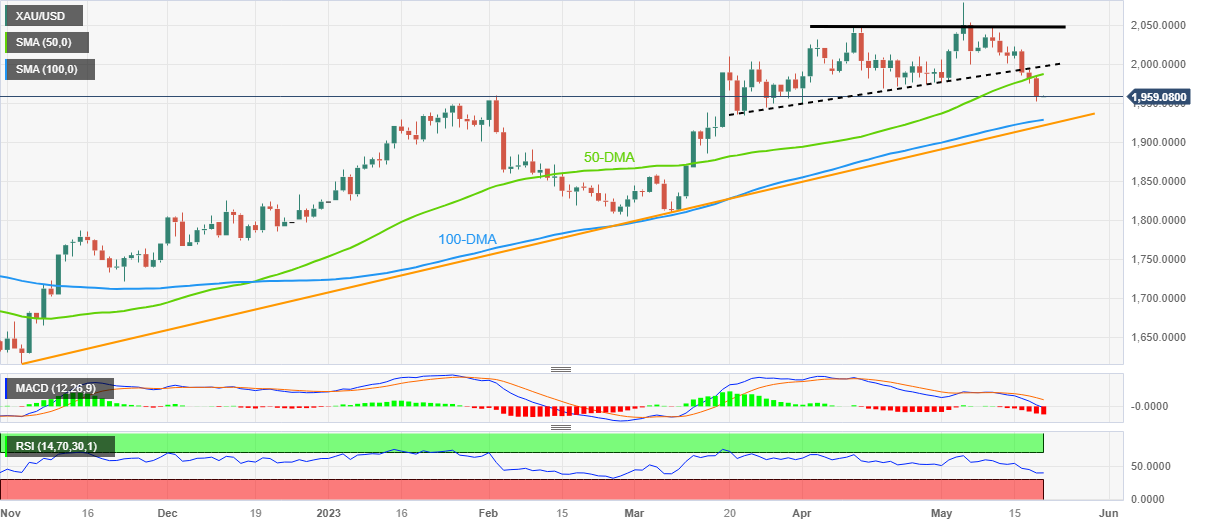
Trend: Further downside expected
- EUR/JPY sees steady gains, fueled by upbeat market sentiment due to advancements in US debt ceiling talks.
- Technical analysis suggests a potential break toward the 150.00 level; however, buyer hesitation may slow the upward momentum.
- In case of a decline, immediate supports sit at the daily pivot point of 149.19, and the S1 pivot at 148.94.
EUR/JPY advances as the Asian session begins, following Thursday’s gains of 0.14%, trades at 149.40, up by 0.02%. An upbeat market sentiment courtesy of an improvement on the US debt ceiling talks amidst a light economic calendar in the Eurozone (EU) was the main catalyst for EUR/JPY’s price action.
EUR/JPY Price Analysis: Technical outlook
As of writing, the EUR/JPY hovers around the weekly highs, which, once cleared, could pave the way for further upside, with buyers eyeing the psychological 150.00 figure. Oscillators like the Relative Strength Index (RSI) are in bullish territory but almost flat, suggesting buyers might pause before launching an assault on the year-to-date (YTD) high of 151.61.
On the flip side, an EUR/JPY drop below 149.00 could put into play the 2022 swing high of 148.40, ahead of falling toward the May 17 low of 148.06.
Short term, the EUR/JPY 1-Hour chart remains upward biased and is trending up in an ascending channel, diving towards the daily pivot point at 149.19. If EUR/JPY falls below 149.19, that will expose the confluence of the S1 pivot and the bottom-trendline of the ascending channel at 148.94. Once cleared, the EUR/JPY could fall to the S2 pivot at 148.52 before testing last year’s high of 148.40.
EUR/JPY Price Action – Hourly chart
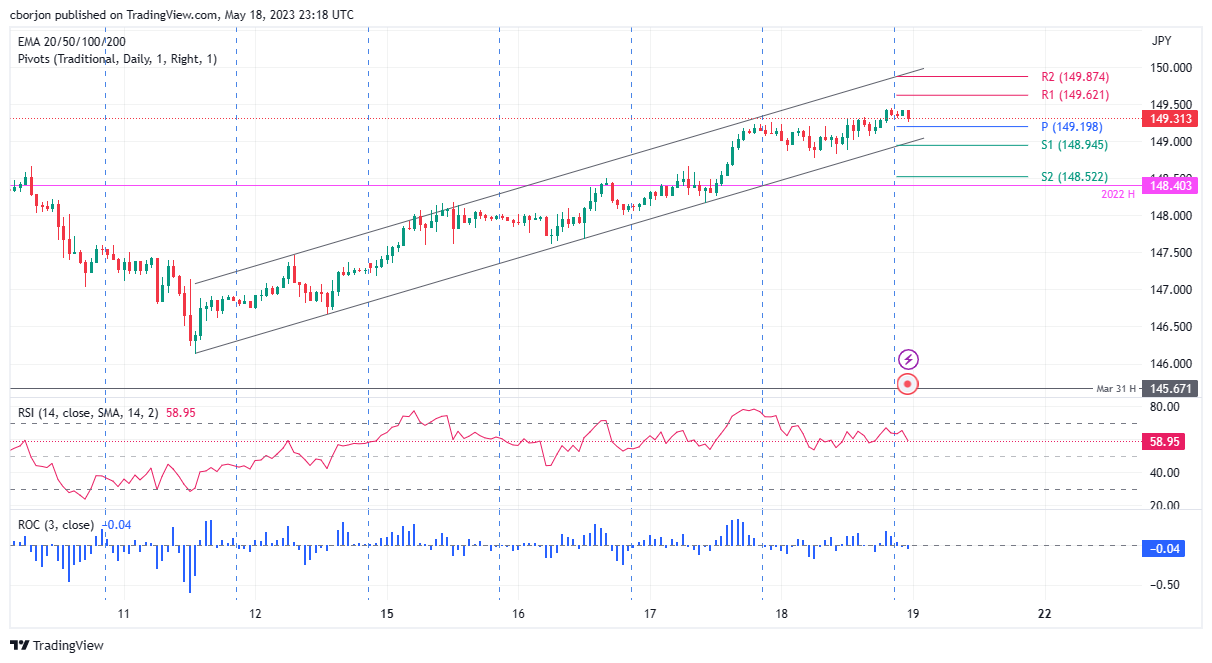
“The Reserve Bank of New Zealand (RBNZ) will hike interest rates by a final quarter point on Wednesday then end its most aggressive tightening cycle since adopting the cash rate in 1999,” according to a Reuters poll of 25 economists conducted during May 15-18 period.
The survey also shows that economists expect RBNZ to adopt a pause until year-end.
Key findings
Over 80% of economists, 21 of 25, polled on May 15-18, expected the RBNZ to raise its Official Cash Rate (OCR) y 25 bps to 5.50% at its May 24 meeting, on par with the central bank's projected peak rate.
The remaining four expected no change in the survey, conducted before the budget.
Among economists who had a long-term view, 14 of 21 forecast rates to stay at 5.50% next quarter. Of the others, four saw rates at 5.75% or higher and three at 5.25%.
Median forecasts showed rates at 5.50% until end-2023 but nearly 30% of respondents predicted at least one 25 bps cut by then.
Inflation was not expected to fall within the RBNZ's target range of 1-3% until the second half of 2024, a separate Reuters poll showed.
Also read: NZD/USD extends corrective bounce towards 0.6250 despite mixed NZ trade data, Fed’s Powell eyed
- AUD/NZD has dropped sharply to near 1.0620 amid the release of upbeat NZ Trade Balance data.
- The RBNZ is to end its most aggressive tightening cycle after raising interest rates one more time by a quarter point next week.
- Higher interest rates by the RBA have started impacting the Australian labor market.
The AUD/NZD pair has witnessed extreme selling pressure after the release of upbeat Trade Balance data (April). Monthly Trade Balance (in NZ terms) has reported a trade surplus of $427M vs. a trade deficit of -$1,586M. However, the annual trade deficit has landed at -$16.8M, remaining close to the former release.
Investors’ focus is majorly on the interest rate decision by the Reserve Bank of New Zealand (RBNZ), which is scheduled for May 24. According to a Reuters poll, RBNZ Governor Adrian Orr will hike interest rates by a final quarter point on Wednesday and then end its most aggressive tightening cycle since adopting the cash rate in 1999. Also, the RBNZ would keep its Official Cash Rate steady at 5.50% (after a quarter-point hike on May 24) till year-end.
New Zealand’s inflation is still hovering around 6.7% as recorded in March, three times more than the desired rate. And, now a budget with higher spending of 11.5 billion NZ dollars in comparison with tax receivables is going to fuel up the overall inflation ahead. Fiscal support to the overall inflation would keep the RBNZ on its toes to keep the monetary policy as restrictive as possible.
On the Australian Dollar front, investors anticipate that the Reserve Bank of Australia (RBA) would return to the neutral interest rate policy as higher interest rates have started impacting the Australian labor market. In April, the Australian labor market witnessed a decline of 4.3k employees while the street was anticipating a jump of 25K. The Unemployment Rate has also jumped firmly to 3.7%.
As per the latest announcement from the US Trade Representative's (USTR) office, published late Thursday by Reuters, “The US and Taiwan reached agreement on the first part of their ‘21st Century’ trade initiative, covering customs and border procedures, regulatory practices, and small business.”
The official announcements also accompany comments from USTR Katherine Tai who said, “The deal strengthens US-Taiwan relations and demonstrates that they can work together to advance trade priorities for their populations.”
Additional details
The pact is not expected to alter goods tariffs but proponents say it will strengthen the economic bonds between the U.S. and Taiwan, open the Chinese-claimed island to more U.S. exports, and increase Taiwan's ability to resist economic coercion from China.
China has reacted furiously to Taiwan's President Tsai Ing-wen's recent engagements with high-ranking US politicians, including an April meeting with US House of Representatives speaker Kevin McCarthy.
The announcement of the trade pact comes just ahead of planned meetings between China's Commerce Minister Wang Wentao and USTR Tai and US Commerce Secretary Gina Raimondo.
Market implications
The news challenges the market’s optimism amid fears of more US-China tension, which in turn may prod the US Dollar buyers, especially due to the latest concerns about the hardships for the US debt ceiling deal passage. Even so, the AUD/USD and NZD/USD fail to immediately react to the news.
Also read: US House hardliners could try to block debt-ceiling deal without 'robust' cuts
- NZD/USD picks up bids to extend late Thursday’s rebound despite mixed NZ trade numbers.
- New Zealand Trade Balance improves on MoM but eases on YoY, Imports drop while Exports grow in April.
- Hopes of no US default, hawkish Fed bets favor greenback bulls but upbeat NZ budget, RBNZ expectations favor Kiwi bulls.
- New Zealand Credit Card Spending, Fed Chair Powell’s speech will be important for intraday directions.
NZD/USD renews intraday high near 0.6240 as it stretches the late Thursday’s rebound despite mixed New Zealand trade numbers on early Friday. Even so, firmer US Dollar and hawkish hopes from the Fed, as well as cautious mood ahead of the key data/events, prod the pair Kiwi buyers.
That said, New Zealand’s headline Trade Balance improves to $427M MoM in April from $-1586M prior but eased on YoY to $-16.8B versus $-16.76B previous readings. That said, Imports dropped to $6.38B from $7.87B (revised) whereas Exports increased to $6.8B versus $6.28B prior (revised).
Apart from the mixed NZ trade numbers, the recently hawkish expectations from the Reserve Bank of New Zealand (RBNZ), mainly due to the previous day’s New Zealand (NZ) annual budget, also propel the NZD/USD prices of late.
In the no-frills budget for 2023, the New Zealand (NZ) Treasury expects the economy to avoid recession while also anticipating a return to budget surplus delayed one year to 2026. While announcing the annual budget, NZ Finance Minister Grant Robertson also said, “Recent widening of current account deficit expected to reverse.”
“Yesterday’s Budget announcement resulted in a significant lift in expected bond issuance in order to fund the additional spending,” said Analysts at the ANZ.
Moving on, New Zealand Credit Card Spending for April and Fed Chairman Jerome Powell’s speech will be important to watch for NZD/USD pair’s immediate directions. However, major attention will be given to the US debt ceiling negotiations as President Joe Biden said to have a decision to avoid a default by Sunday. Following that, the next week’s RBNZ decision will be the key for the Kiwi pair.
Technical analysis
Although the 21-DMA defends NZD/USD bulls around 0.6225, the Kiwi pair buyers need validation from the 100-DMA hurdle surrounding 0.6275.
As markets turn optimistic about no US default, backed by the latest speeches from US President Joe Biden and Republican US House Speaker Kevin McCarthy, Reuters came out with a warning note while citing the powerful group of the US decision-makers, namely the House Freedom Caucus.
“The small but powerful Republican faction warned this week that they could try to block any agreement to raise the $31.4 trillion debt ceiling from passing the House of Representatives, if the accord does not contain ‘robust’ federal spending cuts,” said the news.
Reuters adds that while there are many variables at play, opposition from the Freedom Caucus could, at a minimum, slow down passage of a bill at a time when the economy can ill afford it, given the Treasury Department's warning that the federal government could be unable to pay all its bills as soon as June 1.
Key quotes
The caucus issued its official position on Thursday, urging the Democratic-led Senate to enact the Republican debt-ceiling bill that passed the House in April, which would pare discretionary spending to fiscal year 2022 levels and cap future annual growth at 1%.
Freedom Caucus member Bob Good is one of several hardliners who say they stand ready to oppose bipartisan legislation that fails to meet their goals, despite the risk of a default that could cripple the U.S. economy and unsettle global financial markets.
While a bipartisan deal could still pass despite Freedom Caucus opposition, a split within the Democratic caucus over the right approach could give the faction greater sway in a debt-ceiling vote, especially if the group adopted a formal position that led members to vote en bloc.
FX implications
The news challenges the market’s latest optimism and allows the US Dollar bulls to take a breather amid fears of a delay in the US debt ceiling decision.
Also read: Forex Today: Not even risk appetite slows the Dollar
- USD/CAD has slipped sharply below 1.3500 amid a sharp recovery in the oil price upside exhaustion in the USD Index.
- Monthly Canadian Retail Sales data is seen contracting by 1.4% vs. a contraction of 0.2% recorded earlier.
- USD/CAD is auctioning in a Symmetrical Triangle chart pattern, which indicates a volatility contraction.
The USD/CAD pair has dropped below the psychological support of 1.3500 in the early Tokyo session. The Loonie asset has sensed selling pressure as the oil price has rebounded sharply above $72.00 amid optimism over the US borrowing cap raise and the US Dollar Index (DXY) has retreated after a less-confident pullback.
Investors should note that Canada is the leading exporter of oil to the United States and a recovery in the oil price supports the Canadian Dollar.
Going forward, investors will keep an eye on monthly Canadian Retail Sales data (March). Monthly Retail Sales data is seen contracting by 1.4% vs. a contraction of 0.2% recorded earlier. A decline in househoulds’ demand would allow the Bank of Canada (BoC) to keep its interest rate policy steady further.
USD/CAD is auctioning in a Symmetrical Triangle chart pattern on an hourly scale, which indicates a volatility contraction. The Loonie asset sensed selling pressure while attempting a breakout of the neutral triangle. The downward-sloping trendline from April 28 high at 1.3668 is acting as a major barricade for the US Dollar bulls.
The 20-period Exponential Moving Average (EMA) at 1.3492 is close to the asset price, indicating a lackluster performance.
Also, the Relative Strength Index (RSI) (14) has slipped back into the 40.00-60.00 range, which signals that investors await a potential trigger for a decisive move.
The upside bias will get strengthened if the Loonie asset manages to surpass the round-level resistance of 1.3600. This will expose the asset to May 21 low at 1.3644 followed by the round-level resistance at 1.3700.
On the flip side, a break below May 18 low at 1.3452 will fade the upside bias and will drag the asset toward April 04 low at 1.3406 and May 08 low at 1.3315.
USD/CAD hourly chart
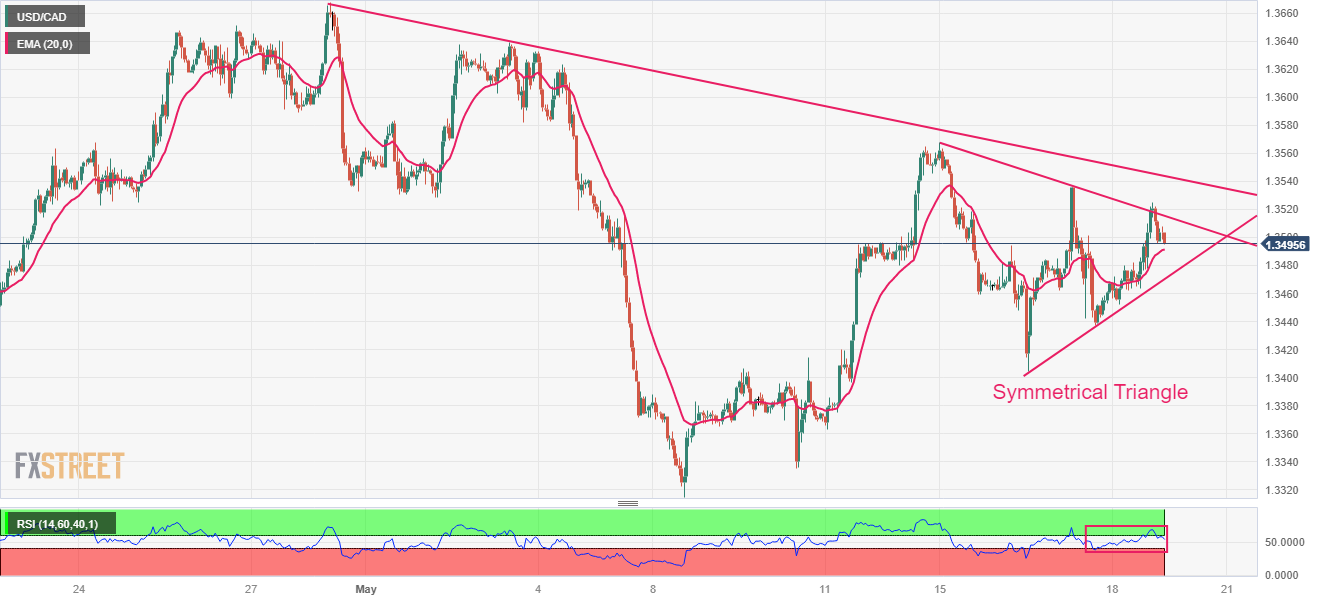
USD/CHF bulls take a breather at the highest levels since April 11 after rising the most in two months the previous day as it justifies the bullish options market bias for the Swiss Franc (CHF) pair amid a broad US Dollar rally ahead of the key data/events.
That said, the US Dollar traces upbeat Treasury bond yields amid hawkish Fed bets and favorable data at home. Adding strength to the greenback could be the hope that the US policymakers will be able to extend the debt ceiling after the latest positive comments from them.
Also read: Forex Today: Not even risk appetite slows the Dollar
At home, the one-month risk reversal (RR) of USD/CHF, a gauge of the spread between calls and puts, braces for the second weekly positive close with the 0.0895 latest figures. It’s worth noting that the daily RR also printed a two-day uptrend with the 0.005 number by the end of Thursday’s North American session, per Reuters options market data.
While the fundamentals are in favor of the USD/CHF bulls, the Swiss Franc (CHF) pair’s further upside hinges on Fed Chairman Jerome Powell’s speech and US debt ceiling negotiations.
Hence, USD/CHF buyers are in the driver’s seat but fresh long positions should be taken with care.
- GBP/JPY rises to a fresh weekly high of 172.16, supported by a breakout from a falling wedge pattern.
- Upside targets include resistance levels at 173.00 and the psychological barrier at 175.00, with 2016 high at 177.87 as the ultimate target.
- A potential double-top formation could be confirmed if GBP/JPY breaks the May 11 daily low of 167.84.
GBP/JPY rose to a fresh weekly high of 172.16 after a confirmed upbreak of a falling wedge, a bullish chart pattern, though it fell shy of achieving a new year-to-date (YTD) high of 172.33. At the time of writing, the GBP/JPY is trading at 172.07 as the Asian session begins.
GBP/JPY Price Analysis: Technical outlook
The daily chart shows that the GBP/JPY is upward biased, though it remains shy of testing the YTD high, which could pave the way for further upside. Noteworthy that the Relative Strength Index (RSI) indicator is registering lower peaks contrarily to GBP/JPY’s price action, achieving higher highs. That means a negative divergence is forming between price action and oscillators, warranting of further losses.
Additionally, the GBP/JPY could be forming a double-top, which could be confirmed once the pair cracks the May 11 daily low of 167.84.
If GBP/JPY cracks the YTD high, the next resistance would be 173.00, and the psychological barrier 175.00. A breach of the latter will clear the path to test the 2016 high at 177.87.
Conversely, a GBP/JPY’s fall below 172.00 could pave the way for a correction. Firstly, the GBP/JPY could dip toward the May 16 high at 170.83. Once cleared, the next demand area would be the 170.00 figure, followed by the confluence of the falling-wedge top trendline and the 20-day Exponential Moving Average (EMA) at the 169.50-70 area.
GBP/JPY Price Action – Daily chart
- EUR/USD licks its wounds after falling to nearly two-month low, marking the biggest slump in three weeks.
- US Dollar cheers upbeat data, hawkish Fed bets and strong yields to please bulls.
- ECB’s de Guindos appear less impressive as a hawk and fails to lift Euro amid absence of major data/events.
- ECB’s Monthly Economic Bulletin, speech from Fed’s Powell and US debt ceiling drama eyed for clear directions.
EUR/USD holds lower grounds near 1.0770 as bears take a breather at the lowest levels in nearly eight weeks amid early Friday morning in Asia, after falling the most since late April the previous day. In doing so, the Euro pair portrays the market’s cautious mood ahead of this week’s key event, namely Fed Chairman Jerome Powell’s speech. Also proding the Euro bears is the anxiety ahead of the US President Joe Biden’s promised announcement on Sunday to avoid the default, as well as concerns about the European Central Bank (ECB) Bulletin.
The major currency pair dropped the most in three weeks the previous day as the US Dollar jumped to a two-month high while tracing upbeat Treasury bond yields amid hawkish Fed bets and favorable data at home. Adding strength to the greenback could be the hopes that the US policymakers will be able extend the debt ceiling after the latest positive comments from them.
With this, the US Dollar Index (DXY) jumped to the highest levels since March 20 while the US 10-year and two-year bond coupons jumped to the March 15 tops. That said, Wall Street closed on the positive side amid cautious optimism in the market.
On Thursday, US Initial Jobless Claims for the week ended on May 12 dropped to 242K versus 254K expected and 264K prior whereas the Philadelphia Fed Manufacturing Survey gauge for May improved to -10.4 from -31.3 prior, versus -19.8 market forecasts. Further, US Existing Home Sales for April eased to 4.28M versus analysts’ estimations of 4.3M and 4.44M prior. Additionally, the US Conference Board Leading Index matches -0.6% market forecasts to print the 13th consecutive decline, indicating a worsening economic outlook, versus -1.5% prior. It’s worth noting that the US Retail Sales and Industrial Production for April printed upbeat figures earlier in the week and inspired the Fed hawks to defend their “higher for longer rates” bias, which in turn allowed the US Dollar to regain its power.
Following the data, Dallas Federal Reserve President Lorie Logan said on Thursday, as reported by CNBC, that data at this time does not support skipping an interest rate hike at the next meeting in June. On the same line, Fed Governor Philip Jefferson said on Thursday that inflation remains too high whereas St Louis Fed President James Bullard reiterated his support for higher rates.
On the other hand, European Central Bank (ECB) Vice President Luis de Guindos delivered a speech while saying, “Inflation in services is the most worrying for the ECB.” The policymaker also added that there is still scope to keep raising rates.
Looking ahead, the Euro bears are likely to keep the reins but their further dominance hinges on the European Central Bank’s (ECB) Monthly Economic Bulletin. More importantly, Fed Chairman Jerome Powell’s speech and US debt ceiling negotiations will be the key as US President Joe Biden said to have a decision to avoid a default by Sunday.
Technical analysis
A daily closing below the 100-DMA, around 1.0810 by the press time, directs EUR/USD toward the mid-March swing high of near 1.0760 while nearly oversold RSI (14) line may prod bears afterward.
- AUD/USD has sensed selling pressure around 0.6650 as investors are anticipating a neutral policy stance by the RBA.
- The appeal for US equities seems solid amid optimism over approval of the US debt-ceiling raise.
- Other US leaders have shown frustration for US Biden on his willingness to involve in a bipartisan deal to increase the US borrowing cap limit.
The AUD/USD pair has extended its reocvery above 0.6650 in the early Asian session. The Aussie asset has managed in extending its recovery further as the US Dollar Index (DXY) has witnessed an exhaustion in the upside momentum.
S&P500 continued its bullish performance, settled with significant gains on Thursday consecutively. The appeal for US equities seems solid amid optimism over approval of the US debt-ceiling raise by the White House and Republican leaders.
Meanwhile, other US congressional leaders have shown frustration for US President Joe Biden on his willingness to involve in a bipartisan deal to increase the US borrowing cap limit as lower spending initiatives in the budget would create tougher work requirements for food aid recipients, as reported by Reuters.
The demand for US government bonds has dropped dramatically as investors are anticipating that US debt-ceiling negotiations will get thumbs up from Republicans. The 10-year US Treasury yields have jumped strongly above 3.65%.
On the Australian Dollar front, weak Employment data released on Thursday is expected to reinforce the Reserve Bank of Australia (RBA) to return to a steady monetary policy stance. In April, the Australian labor market witnessed a decline in laborforce numbers by 4.3K. April’s Unemployment Rate has jumped to 3.8%.
Therefore, RBA Governor Philip Lowe might keep interest rates steady at 3.85% in its June monetary policy meeting as higher interest rates have started biting firms’ production levels due to the bleak economic outlook.
- GBP/USD slides in a meltdown from the topping pattern.
- GBP/USD could be on the verge of a correction to restest the prior area of support, 1.2420 and 1.2450 in the main.
In the prior analysis, GBP/USD Price Analysis: Bears are moving in on the risk rally, it was explained that the M-formation was explained to be a topping pattern that had formed as the potential for the final stage of the prior bullish rally:
GBP/SD prior analysis, daily chart
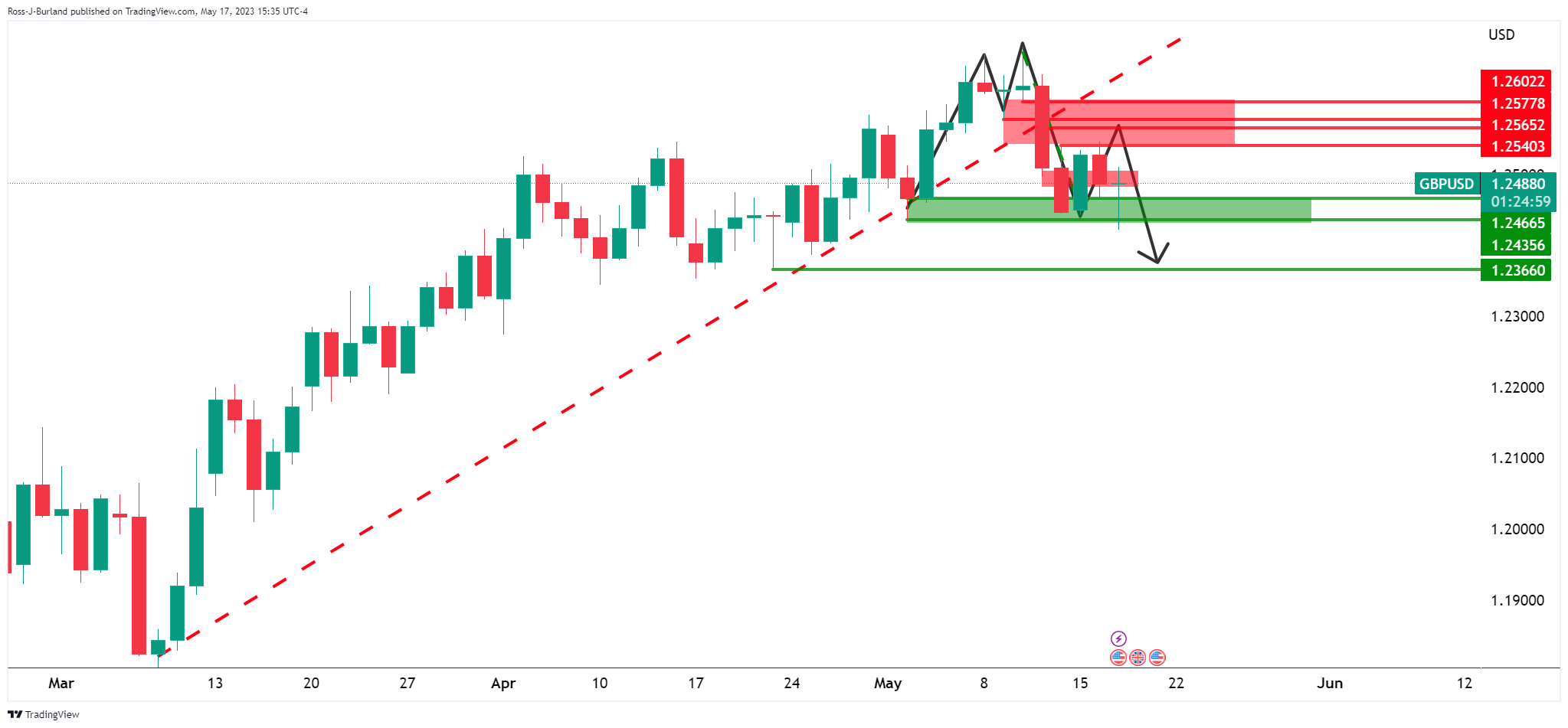
The price was on the backside of that trendline where traders were anticipated to trade on the short side.
GBP/USD prior analysis, H4 chart

The price has shot up to test resistance and while there are prospects of an onward continuation, the price can easily head lower as illustrated in the chart above.
GBPUSD live updates
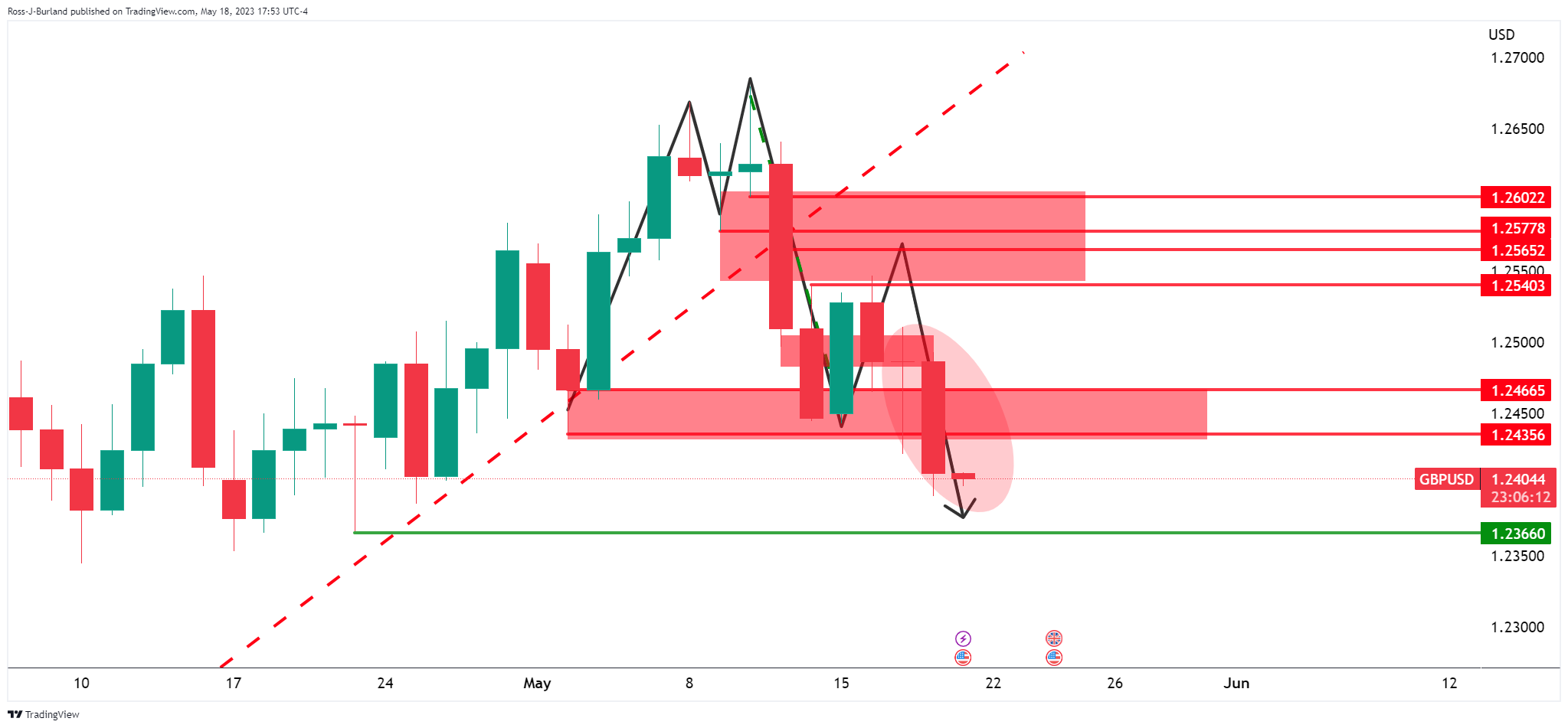
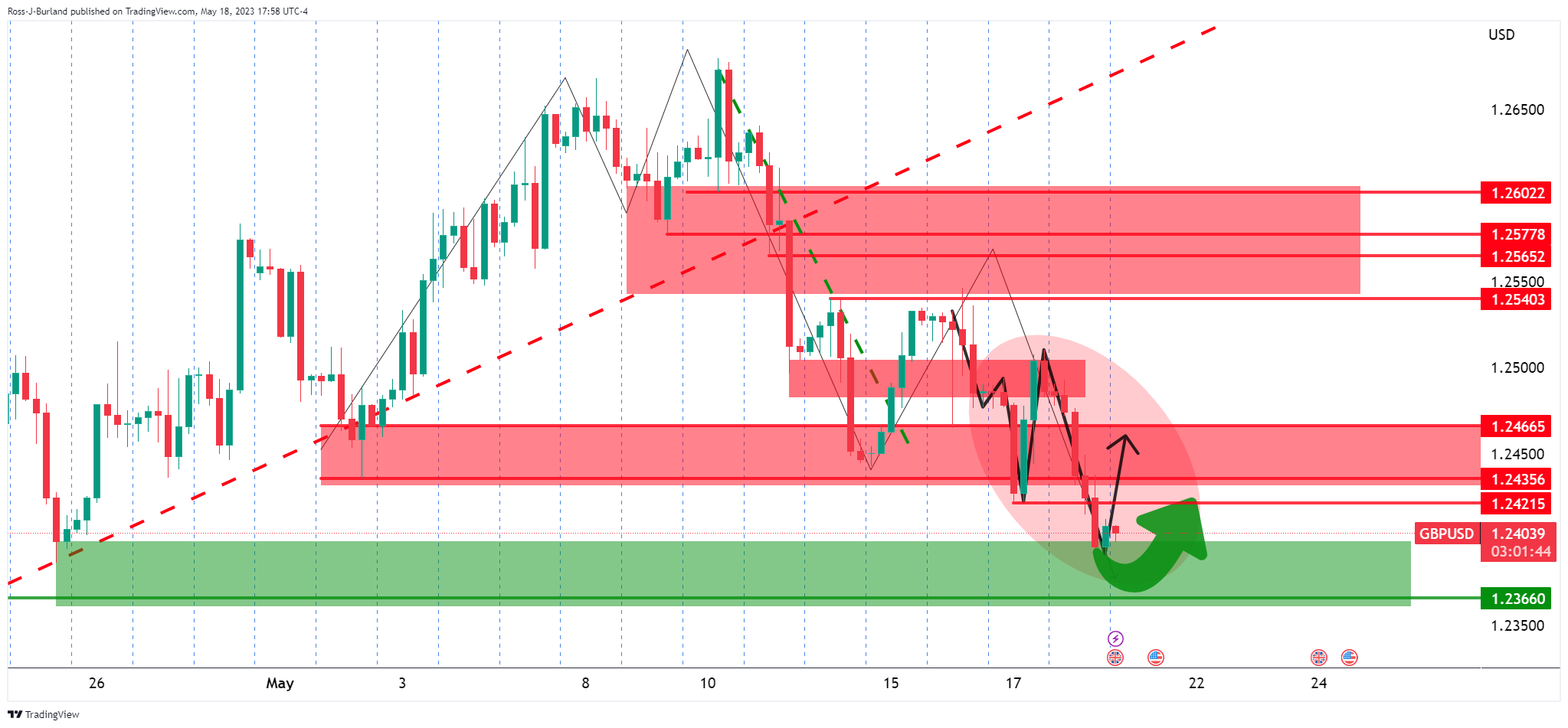
The price is now in an area where we could now see a correction to restest the prior area of support, 1.2420 and 1.2450 in the main.
- Gold price bears are eyeing a continuation to the daily support area.
- Gold price pressured by a resurgence in the US Dollar.
Gold price traded by over 1% lower for a third-straight session on Thursday as the US Dollar continues to strengthen and bond yields rise. The US Dollar index was last seen up 0.69 points to 103.55, making gold more expensive for international buyers, and is poised for the largest weekly percentage drop since October.
Gold price fell to a low of $1,957.50 from a high of $1,986.07. Bond yields also climbed, with the US two-year note last seen paying 4.241%, up 7.7 basis points, while the 10-year note was up 7.3 basis points to 3.642%.
The drop in the Gold price comes as the greenback rises with talks between the Whitehouse and Congress over raising the debt ceiling continue, with investors eyeing the possibility of a default on US debt should talks fail. President Joe Biden and Speaker of the House Kevin McCarthy reiterated their aim to strike a deal soon to raise the $31.4 trillion federal debt ceiling and agreed to talk as soon as Sunday. President Joe Biden on Wednesday said he was confident of reaching a deal to avoid defaulting on US debt. McCarthy said a debt-ceiling deal might be "doable" by Sunday. However, market experts cautioned that reaching a deal is merely the first step in what could be a fraught process.
The debt ceiling has drawn attention away from uncertainty about the Federal Reserve's stance on interest rates, but economic data showed the number of Americans filing new claims for jobless benefits fell more than expected last week, suggesting the labor market remains tight, giving the Fed more cushion to continue raising rates. In the week ended 13 May, Initial Claims fell 22k to 242k. That was 4k below the same week in April and points to another strong labour market report. ´´The current strength of the labour market does not support the Federal Reserve view that unemployment rate will lift to 4.5% by year-end,´´ analysts at ANZ Bank explained.
Meanwhile, Dallas Federal Reserve Bank President Lorie Logan and Fed Governor Philip Jefferson said on Thursday the economy does not appear to be softening fast enough for the central bank to pause its rate hike cycle.
´´Without an additional macro catalyst, we expect discretionary trader flow tied to market expectations for a deepening Fed cutting cycle over the next year to support gold towards new cycle highs over the coming months,´´ analysts at TD Securities said.
Gold technical analysis


The Gold price could be leveling out here but the bulls will need to get on the backside of the bearish trendline. In any case, the bears eye an eventual move toward the support area:
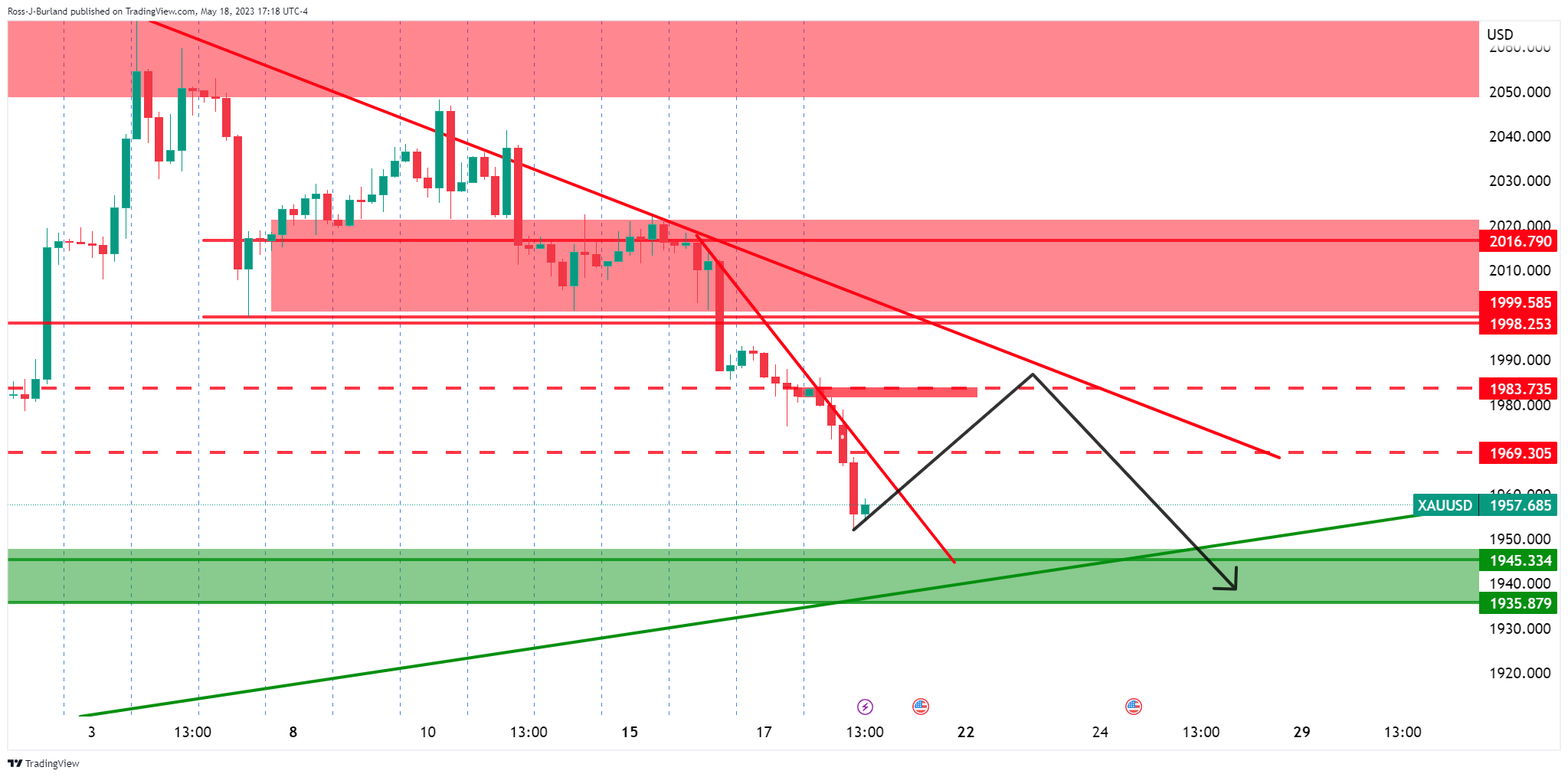
The economic calendar is light on Friday. During the Asian session, New Zealand will report on exports and imports, as well as Credit Card Spending. Japan will release inflation data and the Tertiary Industry Index. Later in Europe, the highlight will be German wholesale inflation. The rally of the US dollar is in focus, and the slide in Gold price also deserves attention.
Here is what you need to know on Friday, May 19:
US stocks had another positive day, with the Dow Jones gaining 0.34% and the Nasdaq jumping 1.51%. Optimism about a debt ceiling deal, as well as upbeat economic data, fueled risk appetite. The US dollar rose across the board, even against high-yielding currencies. The US Dollar Index rose 0.65% to settle at 103.50, its highest level in two months. The dollar looks firm, however, most currency pairs show extreme oversold readings.
Economic data from the US came in above expectations, with Jobless Claims and the Philly Fed. Hawkish comments from Federal Reserve officials, along with hopes of a resolution to the debt ceiling drama, triggered a selloff in Treasury bonds. The US 10-year yield rose to 3.65%, the highest in two months. Investors continue to pare bets of Fed rate cuts by year-end and consider the possibility of another rate hike in June. More Fed talk is scheduled for Friday, including Chair Powell.
EUR/USD dropped towards 1.0750, falling for the fifth time in the last six trading days. On Friday, Germany will report the Producer Price Index for April. The European Central Bank (ECB) will release its Economic Bulletin, and ECB officials Schanbel and Lagarde will speak.
GBP/USD tumbled, testing levels under 1.2500. EUR/GBP finished flat around 0.8680, holding weekly losses.
The Japanese Yen was the worst performer, affected by rising government bond yields. USD/JPY advanced for the sixth consecutive day, reaching levels above 138.50, the highest since November. Inflation data from Japan is due on Friday.
The Australian dollar lagged following the Australian employment data. AUD/USD dropped below 0.6640 and is looking at 0.6600.
NZD/USD held above 0.6200 and posted modest losses after the presentation of the Budget and wholesale inflation figures. Trade data and Credit Card Spending are due in New Zealand.
USD/CAD rose toward 1.3500 and remains in a familiar range. On Friday, March retail sales will be released in Canada.
Gold suffered heavy losses after breaking the $1,970 support area and fell to $1,950. The yellow metal remains under pressure. Silver also lost ground, extending weekly losses, with XAG/USD settling at $23.50, the weakest close since late March.
Like this article? Help us with some feedback by answering this survey:
- WTI sinks despite the upbeat mood on Wall Street.
- US oil is down by some 0.9% meeting a new low on the day of $71.47.
West Texas Intermediate crude oil is corecting and down by some 0.9% and has fallen from a high $72.83 to a low of $71.47. Oil sank despite an upbeat tone on Wall Street over the prospects of debt-ceiling negotiations that continue in Washington ending in a solution.
On Wednesday, President Joe Biden and McCarthy reiterated their aim to strike a deal soon to raise the $31.4 trillion federal debt ceiling and agreed to talk as soon as Sunday. President Joe Biden on Wednesday said he was confident of reaching a deal to avoid defaulting on US debt.
The debt ceiling has drawn attention away from uncertainty about the Federal Reserve's stance on interest rates, but economic data showed the number of Americans filing new claims for jobless benefits fell more than expected last week, suggesting the labor market remains tight, giving the Fed more cushion to continue raising rates. In the week ended 13 May, Initial Claims fell 22k to 242k. That was 4k below the same week in April and points to another strong labour market report. ´´The current strength of the labour market does not support the Federal Reserve view that unemployment rate will lift to 4.5% by year-end,´´ analysts at ANZ Bank explained.
Meanwhile, Dallas Federal Reserve Bank President Lorie Logan and Fed Governor Philip Jefferson said on Thursday the economy does not appear to be softening fast enough for the central bank to pause its rate hike cycle.
Elsewhere, the US also reported inventories unexpectedly rose last week, with the Energy Information Administration reported a five-million barrel rise in stocks, while most analysts expected a drop. Wednesday's EIA report showed that (1) U.S. crude oil inventories as of May 12 were -0.1% below the seasonal 5-year average, (2) gasoline inventories were -6.4% below the seasonal 5-year average, and (3) distillate inventories were -16.4% below the 5-year seasonal average. US crude oil production in the week ended May 12 fell -0.8% w/w to 12.2 million bpd, only 0.9 million bpd (-6.9%) below the Feb-2020 record-high of 13.1 million bpd.
Baker Hughes reported last Friday that active US oil rigs in the week ended May 12 fell by -2 to an 11-month low of 586 rigs, falling further below the 2-1/2 year high of 627 rigs posted on December 2. U.S. active oil rigs have more than tripled from the 17-year low of 172 rigs seen in Aug 2020, signaling an increase in U.S. crude oil production capacity.
- Banxico leaves interest rates unchanged at 11.25%, ending the hiking cycle initiated in June 2021, causing a muted reaction in the USD/MXN.
- Banxico’s statement indicates a disinflationary process underway, yet it acknowledges a complicated and uncertain inflationary outlook with potential upside risks.
- The USD/MXN exchange rate experiences limited reaction, maintaining a position above the 17.7000 figure, with the 18.0000 level eyed as the next key resistance.
The Mexican Peso (MXN) depreciates sharply after the Bank of Mexico’s (Banxico) decision to keep rates unchanged at 11.25%, ending its hiking cycle in June 2021 after 700 basis points of increases. At the time of writing, the USD/MXN is trading volatile at around the 17.70000 – 17.7500 area, with US Dollar (USD) buyers eyeing the 18.000 psychological barriers.
Summary of the monetary policy statement by Banxico
Bank of Mexico based its decision even though core inflation has shown some resistance to decline, but commented that several central banks halted their reference rates. Banxico assessed the global economic growth as tilted to the downside but commented that inflation in Mexico has decreased since the last monetary policy meeting, emphasizing that core inflation decreased more “markedly than in previous months.”
The Governing board evaluated the magnitude and diversity of the inflationary shocks and considered the economy has started to undergo a disinflationary process, given that many pressures have eased. The board will monitor inflationary pressures and “estimates that the inflationary outlook will be complicated and uncertain throughout the entire forecast horizon, with upward risks.”
The Governing Board finalized the statement saying they will maintain the reference rate at its current level for an extended period.
Must read: Mexico: After 15 consecutive hikes, central bank keeps key rate unchanged at 11.25%
USD/MXN Reaction
The USD/MXN reaction was muted, with the exchange rate holding above the 17.7000 figure after clashing earlier in the day with the 20-day Exponential Moving Average (EMA) at 17.7682, limiting the rally on the USD/MXN. Above that level, the psychological 18.0000 figure emerges, ahead of the 50-day EMA at 18.0332
On the downside, any drops below the May 17 high of 17.6914 could open the door to retesting lower levels, at around 17.6000, followed by the lows of July 2017 at 17.4500.
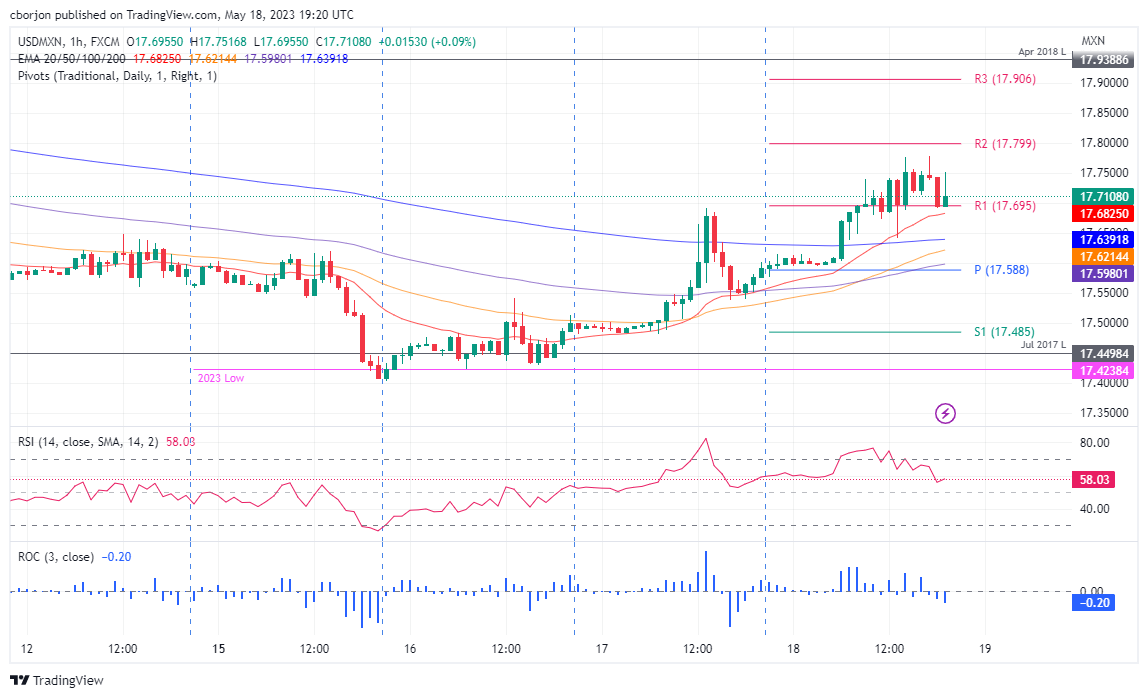
As expected, the Bank of Mexico held its key interest rate unchanged at 11.25%. The last time the bank left interest rates unchanged was in May 2021. Since then, it has raised the key rate from 4% to 11.25% in 15 consecutive meetings. The board stated that it "considers that it will be necessary to maintain the reference rate at its current level for an extended period," and the decision was unanimous.
Key takeaways from the statement:
“The Governing Board evaluated the magnitude and diversity of the inflationary shocks and their determinants, along with the evolution of medium- and long-term inflation expectations and the price formation process. It considered that the economy has started to undergo a disinflationary process given that many pressures have eased.”
“It deemed that these pressures continue having an incidence on inflation, as it remains high and the inflationary outlook is still very complex.”
“The Board will thoroughly monitor inflationary pressures as well as all factors that have an incidence on the foreseen path for inflation and its expectations. It estimates that the inflationary outlook will be complicated and uncertain throughout the entire forecast horizon, with upward risks.”
“In order to achieve an orderly and sustained convergence of headline inflation to the 3% target, it considers that it will be necessary to maintain the reference rate at its current level for an extended period. “
- NZD/USD bears are moving in and eye a downside extension.
- NZD/USD´s M-formation could stall the momentum.
As per the prior analysis from earlier this week, NZD/USD bulls in the market and eye a firm correction, the pair moved up into the 38.2% Fibonacci resistance and came close to a 50% mean reversion before starting to melt to the downside:
Prior analysis:
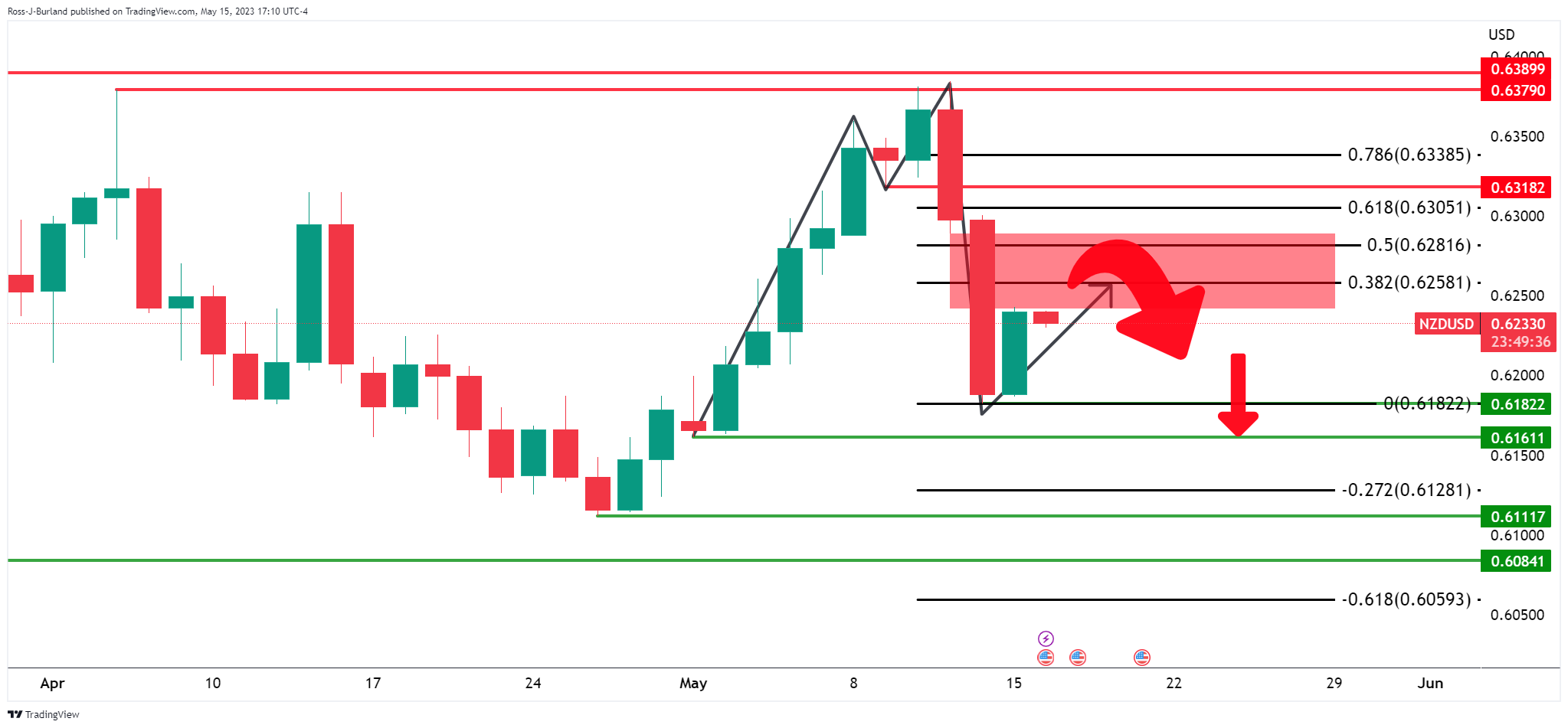
Update 1:
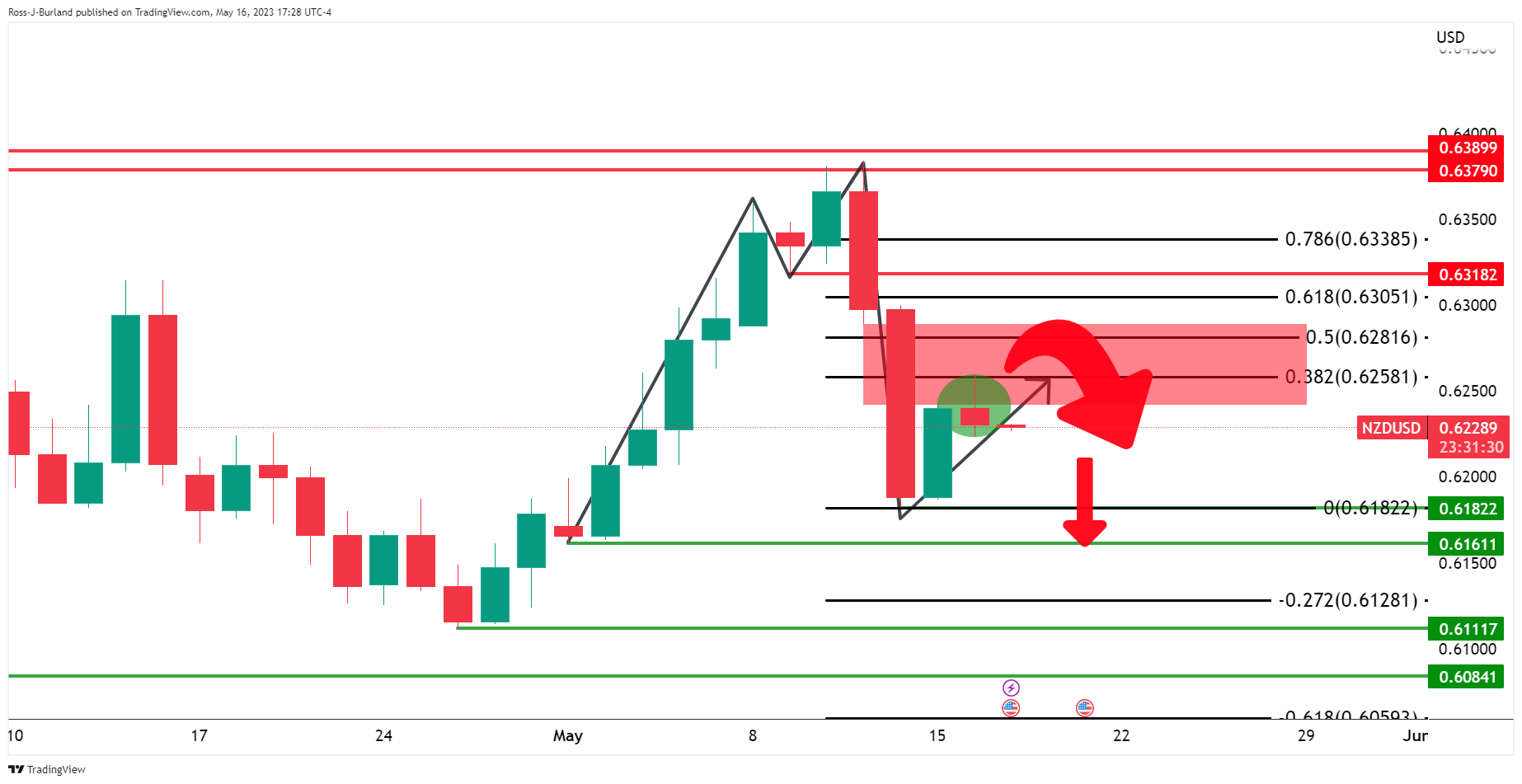
Update 2
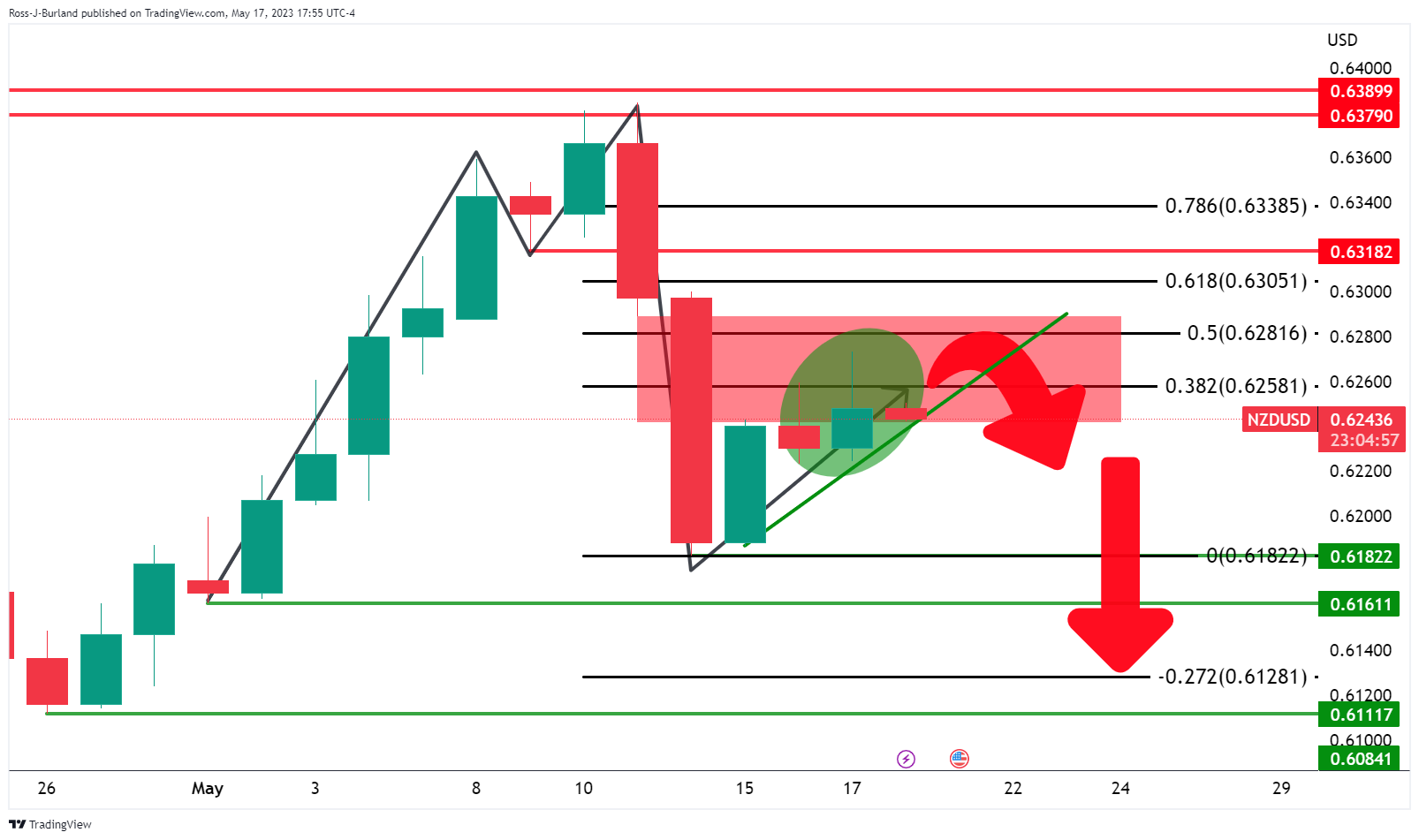
There are still prospects of a move lower although the 4-hour and 1-hour charts can be used to gauge as to whether there is going to be a deceleration in the bullish correction and so far, it is early days still. After all, the price is still on the front side of the bullish dynamic trendline support.
NZD/USD update, live market:

NZD/USD H4 chart

NZD/USD has fallen below the trendline support which now turns to the counter trendline. The M-formation is a compelling feature on the chart as it is a reversion pattern. A pullback could be an opportunity for the bears to sell at a premium in the pursuit of lower grounds longer-term.
- A robust US jobs report supports bullish sentiment for the greenback, suggesting a potential pause in Federal Reserve’s tightening cycle is less likely.
- Progress in US debt ceiling negotiations drives positive sentiment, with an agreement anticipated within the week to prevent potential default.
- Canadian housing data disappoints as the New Housing Price Index contracts in April, adding to downside pressures for CAD.
USD/CAD rises sharply and reclaims the 1.3500 figure after hitting a daily low of 1.3442. US political issues regarding the debt ceiling had taken center stage, and progress on the theme triggered an upbeat sentiment. Additionally, a solid US jobs report could deter the US Federal Reserve (Fed) from pausing its tightening cycle. At the time of writing, the USD/CAD is trading at 1.3516.
Solid US data and positive sentiment drive USD/CAD, overcoming Canadian housing market headwinds
Fundamental news from the United States (US) bolstered the appetite for the greenback. A goodish US jobs report showed the tight labor market, with Initial Jobless Claims rising below estimates. Meanwhile, the Philadelphia Fed Manufacturing production for May was negative, though it showed some improvement amidst several headwinds like sticky inflation and higher interest rates. Given the backdrop, it might deter Federal Reserve officials from pausing due to the tightness of the labor market.
Meanwhile, US equities got bid as negotiations about an increase of the US debt ceiling. Recent remarks from House Speaker Kevin McCarthy underlined the urgency for an agreement to be finalized this week and for Congress to vote next week ahead of the US default deadline.
Of late, remarks from US Senate Majority Leader Schumer commented that debt limit talks are making progress. Biden’s economic adviser Lael Brainard said that Congress’s most significant risk is failing to prevent a default.
On the Canadian front, housing data pointed to further deterioration. The New Housing Price Index for April plunged -0.1% MoM, below the prior’s month report, and annually based, dropped -0.2%, below March’s 0.2% gain.
On the central bank note, Federal Reserve officials sounded hawkish, with Dallas Fed President Lorie Logan saying that data this time does not support skipping rate hikes at the next meeting, adding that the Fed has not made the progress we need on inflation.
Bank of Canada’s Governor Tiff Macklem and Deputy Governor Rogers said financial institutions should adjust to higher rates. Macklem added that April CPI data was stronger than expected and economic data will guide June’s rate decision.
USD/CAD Technical Level
- EUR/USD bears are in the market but bulls are showing up.
- The bulls need to get above the 1.080s and trendline resistance.
EUR/USD is attempting to correct the heavy selling that has taken place over the course of several days. EUR/USD is currently trading at 1.0766 and is down some 0.66%, traveling between a low of 1.0762 and 1.0848 the high.
The Euro has been pressured by a firmer US Dollar that again enjoyed another round of solid economic data amid market optimism about a US debt ceiling deal to avert a potential default. Technically, however, the offer in EUR/USD is decelerating as the following charts will illustrate, raising prospects of a correction. With that being said, the bulls have their work cut out:
EUR/USD daily charts
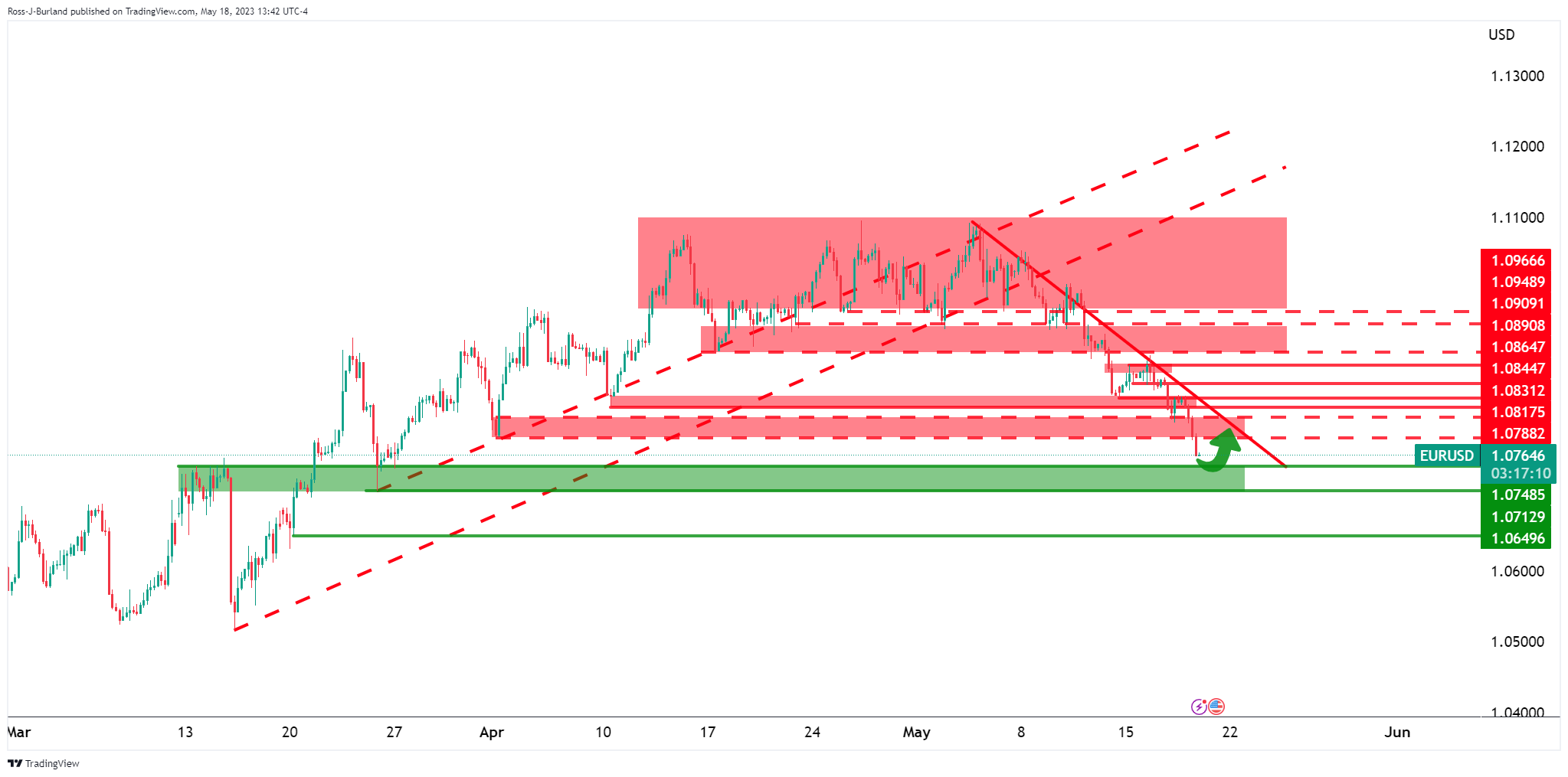

EUR/USD remains heavily offered and has broken the 1.0780s prior support. This gives way to prospects of a continuation to the potential support area between the 1.0750s and 1.0700
EUR/USD H4 chart
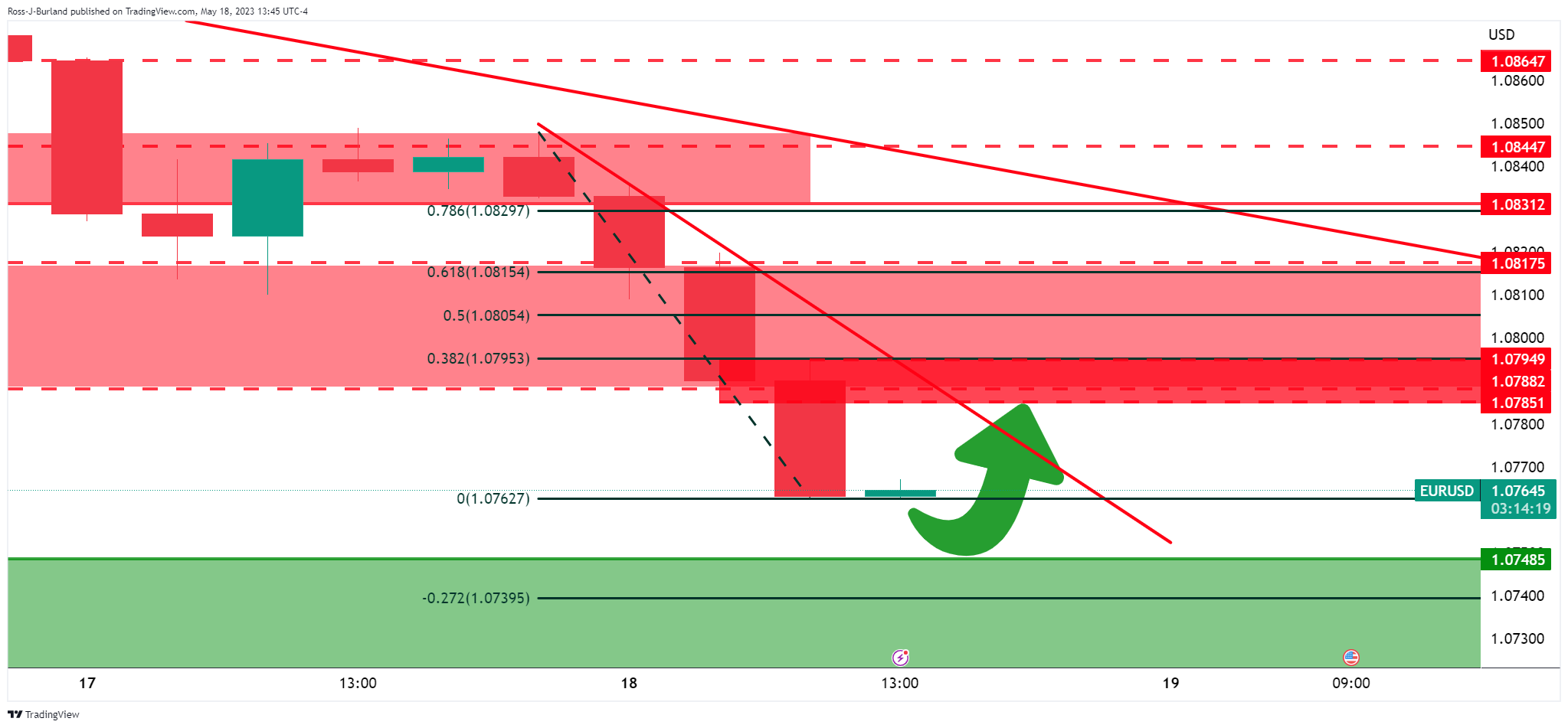
However, the bulls can start to monitor for signs of deceleration and a potential correction. The 4-hour trendline and horizontal resistance will be key in this regard. A failure to break above these will leave the bears in control.
EUR/USD H1 charts

The hourly chart is also showing signs that the bears are not done yet although if the bulls commit, then there will be prospects of a move to test 1.0780s and 1.0790s and then 1.0800 and the 1.0820s.
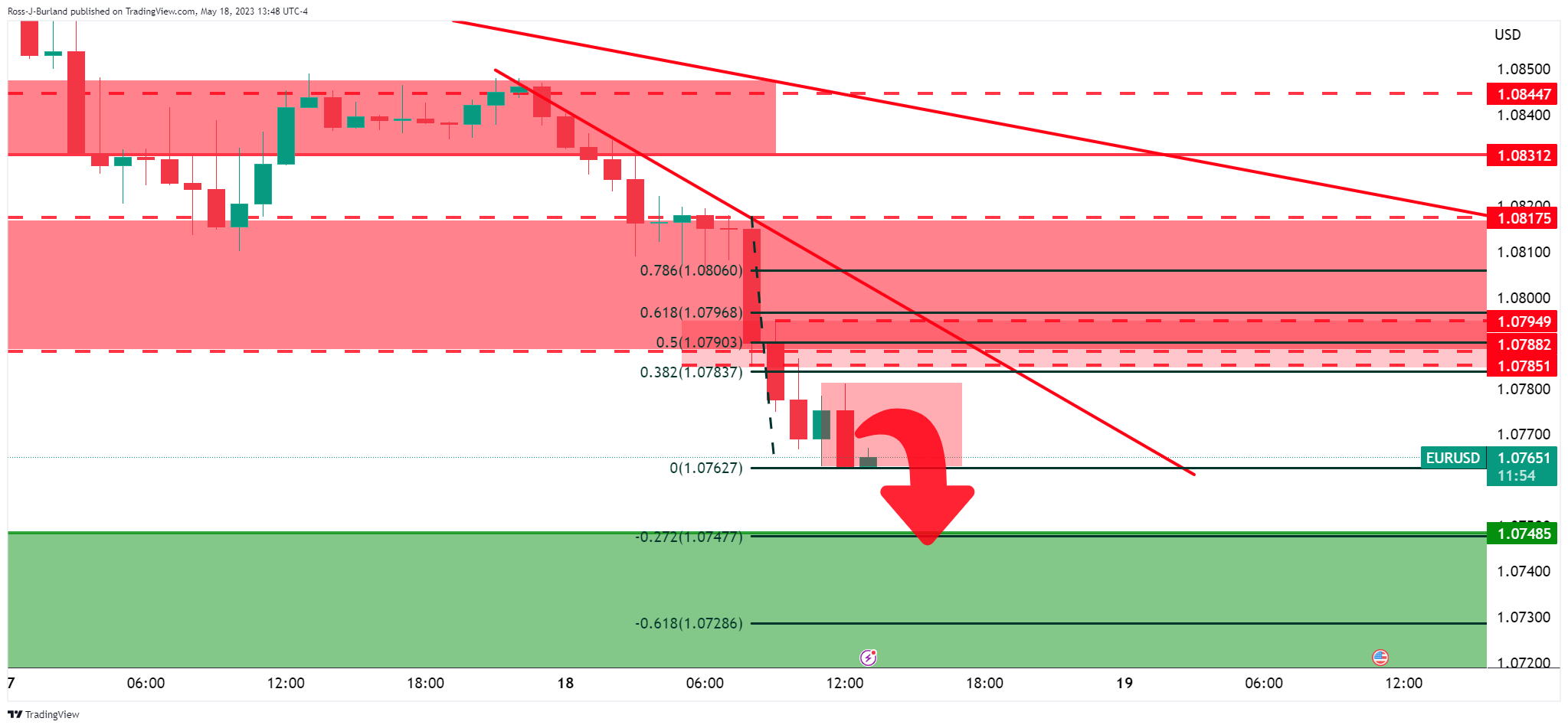
On the other hand, we could easily see a continuation from below the 1.0770s.
- USD/JPY rally driven by positive sentiment around US debt ceiling talks, solid US job data, and upbeat retail and industrial figures.
- Despite breaching the resistance at 138.00, potential resistance levels at 139.00 and 139.89 might cap gains, with the psychological 140.00 mark as the next target.
- While signs of overbought conditions emerge, suggesting potential for a downward correction, the overall bullish trend remains solid.
USD/JPY climbs to new year-to-date (YTD) highs of 138.67, bolstered by higher US Treasury bond yields, amidst an upbeat sentiment sponsored by improvement in the US debt ceiling talks. In addition, solid US jobs data, alongside strong Retail Sales, Industrial Production, and a surprising hawkish comment by Dallas Fed President Lorie Logan, propelled the USD/JPY. At the time of writing, the USD/JPY is trading at 138.57 after hitting a low of 137.28.
USD/JPY Price Analysis: Technical outlook
The USD/JPY daily chart shows the pair remains in a solid uptrend after breaking a resistance trendline alongside the 138.00 figure. On the upside, the USD/JPY will clash with solid resistance levels like the 139.00 figure, followed by the November 30 daily high of 139.89. A decisive break will expose the 140.00 psychological figure. On the other hand, if USD/JPY drops below 138.00, it will exacerbate a correction toward the 20-day Exponential Moving Average (EMA) at 135.52.
In the short term, the USD/JPY 1-hour chart, the pair peaked around the R2 daily pivot, with two subsequent attempts to clear the latter, as buyers are eyeing the 139.00 figure. If USD/JPY fails to crack the R2 daily pivot level, a pullback toward the R1 pivot at 138.15 is on the cards before reaching the 20-EMA at 137.98.
The Relative Strength Index (RSI) indicators at overbought territory register lower peaks as price action reaches higher highs. That means negative divergence forms, opening the door for a downward correction. In addition, the 3-period Rate of Change (RoC) shows buyers losing momentum.
USD/JPY Price Action – 1-Hour chart
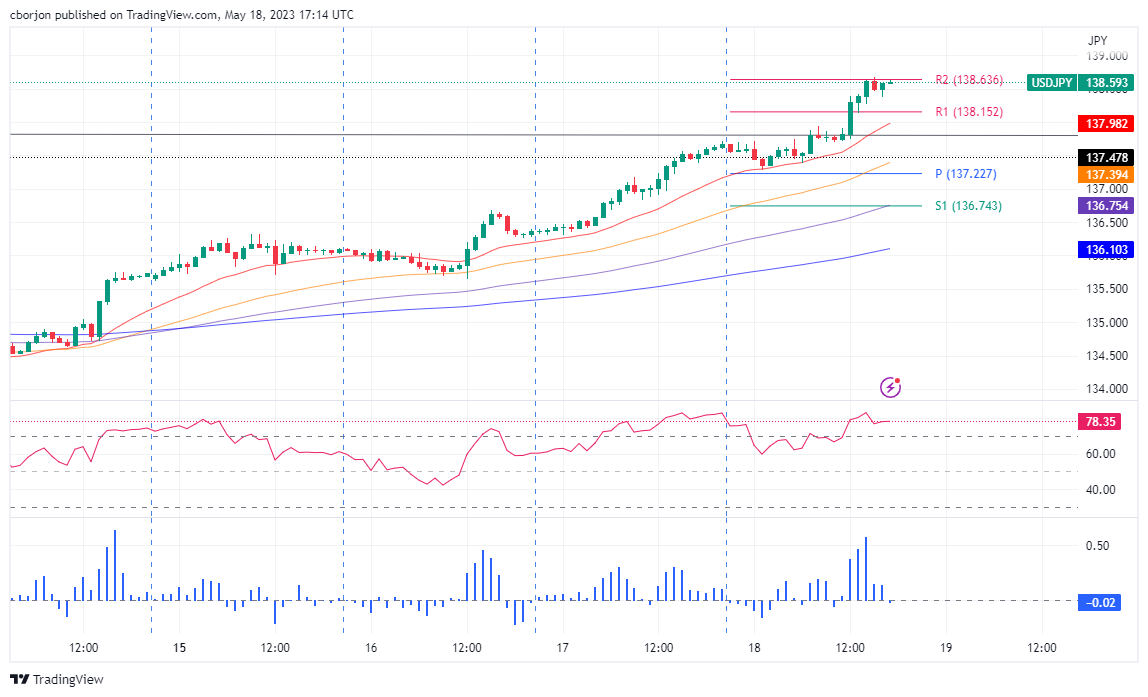
- GBP/USD extends its fall, hitting a three-week low of around 1.2397 amid the fading fear of a possible US default and buoyant market sentiment.
- The robust US labor market report from the Bureau of Labor Statistics and an unexpected Philadelphia Fed Manufacturing Index recovery apply downward pressure on the pair.
- Bank of England speakers suggest a gradual and predictable approach to Quantitative Tightening, providing little support for the Pound.
GBP/USD prolongs its falls past the 1.2400 figure, reaching a new three-week low at around 1.2397, as the Pound Sterling takes a hit, taking advantage of a light economic calendar in the United Kingdom (UK). Fears of a possible default in the United States (US) are fading, as talks between US Congress leaders and the White House showed hope that an agreement would emerge before June 1. The GBP/USD is trading at 1.2423 after hitting a daily high of 1.2492.
Positive US labor market and fading default fears weighed on the GBP
US equities are trading mixed, though earlier it rode a wave of optimism, posting gains due to a buoyant market atmosphere. Discussions regarding the US debt ceiling remain ongoing, underscored by recent statements from US House Speaker Kevin McCarthy. McCarthy stressed the critical need for an agreement this week, reiterating the urgency for Congress to vote to avert a potential default in the forthcoming week.
The US Bureau of Labor Statistics (BLS) released a robust labor market report. Initial Jobless Claims for the week ending May 13 recorded a lower-than-expected rise of 242K, a noticeable drop from the previous week’s 254K. It’s noteworthy, however, that the prior week’s figures were somewhat distorted due to fraudulent claims reported in Massachusetts.
In the meantime, although negative, the Philadelphia Fed Manufacturing Index outperformed expectations, with the index dropping to -10.4, better than the anticipated fall of -19.8, and showed a significant recovery from April’s dismal -31.3. This upturn primarily stems from a rebound in new orders, despite a decline in the employment component and a rise in the price gauge. The increase in producer prices might discourage the Federal Reserve (Fed) from putting its tightening cycle on hold.
Following the release of the data, the GBP/USD dropped from around 1.2440s. The pair fell sharply toward its weekly low before reclaiming the 1.2400 figure. The greenback continued to rise in the day, as shown by the US Dollar Index, which measures the buck’s performance against a basket of six currencies; it is up 0.66%, at 103.541, eyeing a test of the 2017 high oat 103.820.
Regarding the central bank speakers, Dallas Fed President Lorie Logan said that data this time does not support skipping rate hikes at the next meeting, adding that the Fed has not made the progress we need on inflation.
Meanwhile, the UK economic docket featured Bank of England’s (BoE) speakers, who commented that Quantitative Tightening (QT) would be gradual, predictable, and not an active policy instrument. They added that it has some economic effects but is fairly small. BoE’s Michael Ramsden said, “We’re probably going to have several years to go for QT.”
GBP/USD Technical Levels
- AUD/USD continues to tumble for the second day in the week, currently trading at 0.6606.
- US debt ceiling discussions, strong labor market data, and Fed speakers boost USD strength.
- Australia’s jobs report shows the economy lost 27,100 jobs, pushing the unemployment rate from 3.5% to 3.7% in April.
AUD/USD tumbles for the second day in the week after Wednesday’s pause formed a doji, but a break of an upslope support trendline, opened the door for further losses. Reasons like a positive sentiment due to debt ceiling negotiations, solid economic data from the United States (US ), and Fed speakers were the main drivers of the US Dollar (USD) appreciation against the Australian Dollar (AUD). At the time of writing, the AUD/USD Is trading at 0.6606.
AUD weakens on disappointing jobs report, while USD got bolstered by positive US economic data
Wall Street continues to print gains amidst an upbeat market sentiment. The US debt ceiling discussions would continue through the latest comments by US House Speaker Kevin McCarthy, who said it’s essential to have an agreement principle this week and emphasized that the US Congress must vote next week to meet the “default” deadline.
Aside from these comments, a strong labor market report by the US Bureau of Labor Statistics (BLS) showed that unemployment claims continued to downtrend. Initial Jobless Claims for the last week ending on May 13 rose by 242K below estimates and the prior’s week figures of 254K, though it should be said that figures from the last’s week were “inflated” by fraud in a claims report in Massachusets.
Meantime, the Philadelphia Fed Manufacturing Index plunged to -10.4, less than the estimated fall of -19.8, and improved compared to April’s -31.3. The improvement is mainly attributed to a recovery in new orders, though the employment subcomponent deteriorated while a price gauge rose. Although hiring moderated, higher prices paid by producers would deter the Federal Reserve (Fed) from pausing its tightening cycle.
Therefore, the AUD/USD continued its downtrend and hit a daily low of 0.6604 as US data hit the screens. The US Dollar Index is soaring sharply more than 0.50%, up at 103.574, about to test the 2017 high of 103.820. A breach of the latter could weigh on the AUD/USD, which is about to dive below the 0.6600 figure, with the following support area found at the April 28 low of 0.6573.
The AUD/USD weakened during Thursday’s Asian session; the latest Australian jobs report showed the economy lost 27,100 jobs, and the unemployment rate rose from 3.5% to 3.7% in April. Even though it remains at historically low levels, the report could help the Reserve Bank of Australia (RBA) to hit its inflation target of 2%-3%. The market expects the RBA to hold rates unchanged at its June 7 meeting.
AUD/USD Price Analysis: Technical outlook

The AUD/USD pair remains downward biased and might accelerate its fall toward the April 18 low of 0.6573, followed by a test of the year-to-date (YTD) low of 0.6564. The Relative Strength Index (RSI) indicator is in bearish territory, suggesting selling pressure remains in charge, while the 3-day Rate of Change (RoC) shifted to negative readings, supporting a continuation of the downtrend.
Economists at ANZ Bank retain a bullish view and forecast Gold at $2,120 by the first quarter of the next year.
Risk could stem from divergence between Fed’s actions and market expectations
“Prolonged geopolitical tensions, such as that between the US and China, will lend support to investment demand as well as central bank buying. Therefore, we continue to be bullish, expecting prices to reach $2,120 by Q1 2024.”
“The risk to our bullish view could stem from a divergence between the US Fed’s actions and market expectations. Consensus estimates are for a rate cut in 2023, but our baseline forecast is for no cuts in 2023. Any unexpected policy action could trigger price corrections, but such dips should be perceived as buying opportunities.”
The Bank of Canada (BoC) has released its Financial System Review, which expresses increased concern compared to last year about the ability of households to pay their debts. In the document, the BoC noted that the spillover effects on Canada from recent stress in the global banking sector have been limited.
Key takeaways from the Financial System Review—2023:
“Bank funding is becoming scarcer and more expensive.”
“Overall, the banking system in Canada remains robust.”
“A severe recession could lead to credit losses for banks.”
“To date, spillover effects in Canada from the recent stresses in the global banking sector have been limited.”
“Higher global interest rates are increasing funding costs for Canadian banks, both in wholesale markets and through a reduction in demand deposits.”
“Future episodes of market stress—if they last long enough—could put additional upward pressure on the cost of funding and reduce banks’ capacity to provide liquidity to market participants.”
“Canadian banks remain robust, but they are not immune to international developments. The reliance of Canada’s large banks on wholesale funding makes them vulnerable to deteriorating conditions in global financial markets.”
“If the cost of wholesale funding were to rise significantly due to a persistent period of global financial stress, it could lead to Canadian banks tightening lending conditions, making it more difficult and expensive for Canadian households and businesses to access credit.”
“In light of higher borrowing costs, the Bank of Canada is more concerned than it was last year about the ability of households to service their debt. More households are expected to face financial pressure in the coming years as their mortgages are renewed. The decline in house prices has also reduced homeowner equity, and some signs of financial stress—particularly among recent homebuyers—are beginning to appear.”
"To date, spillover effects in Canada from the recent stresses in the global banking sector have been limited.”
The market is nibbling away at pricing for H2 Fed rate cuts and Dollar shorts are feeling the squeeze. It is “just a correction” but it is painful all the same, according to Kit Juckes, Chief Global FX Strategist at Société Générale.
Dollar and end-year Fed expectations edging higher together
“As the regional banking crisis erupted, the market briefly priced end-year rates below 4% but that’s back above 4 ½% now and the Dollar is grinding higher in the process. I doubt we can get back to where we were in early March, but the market’s short Dollars and this kind of grinding uptrend can be painful.”
“As for EUR/USD, the long-term rate trends suggest that there’s still considerable upside potential. The current correction is just that, even if it does last several more weeks and cause further pain.”
- Oil price trades with modest losses as the US Dollar strengthens on hawkish Federal Reserve speeches, US debt-ceiling uncertainty.
- Data showing a greater-than-expected rise in inventories weighs but is balanced by competing data showing rising global demand.
- Oil price is technically in a downtrend – but signs are building for a potential recovery.
Oil price edges lower on Thursday, trading about a fifth of a percentage point down at the time of writing, after the US Dollar – which Oil is primarily priced and traded in – makes gains and data from the Energy Information Administration (EIA) showed a larger-than-expected rise in inventories.
WTI Crude Oil is trading around $72.60 and Brent Crude Oil near $76.60 at the time of writing. The commodity is finding some support after data from the Joint Organizations Data Initiative (JODI) showed a surge in global demand for Oil in March, on Thursday.
Oil news and market movers
- EIA Crude Oil Stocks Change (May 12) data released late Wednesday shows a 5.04M barrel rise versus estimates of a 0.92M barrel fall, indicating robust supply and putting downward pressure on Oil price.
- The US Dollar gains putting downside pressure on Oil after hawkish comments on Tuesday from Loretta Mester, Federal Reserve’s President for Cleveland. Mester upset expectations that the Fed would not need to raise rates any further after she said that given how stubborn inflation was she couldn’t say for sure that the Fed Funds Rate was at a level “where it’s equally probable that the next move could be an increase or a decrease.”
- Uncertainty over US debt-ceiling talks is a win-win for the US Dollar because of its safe-haven status. Growing fears are thus supportive – as is optimism for a resolution, which would provide more proxy stimulus for the economy, raising US Treasury yields in the process, making further rate hikes more likely and thus supporting USD.
- Data from the Joint Organizations Data Initiative (JODI) showed a surge in global demand for Oil in March, on Thursday, putting a floor under Oil price losses.
- The JODI report showed a surge in global demand of 3M barrels per day (bpd) in March.
- Demand was especially strong in China, according to the report by the Riyadh-based agency, where total product demand jumped by 1.6M barrels per day (bpd) month-on-month to 16.79M bpd in March. It was the third-highest ever increase in demand from the country.
- The US also showed an increase in total product demand of 1.77M bpd month-on-month, to a total of 21.77M bpd, whilst at the same time Oil production in the US declined by a quarter of a million bpd.
Crude Oil Technical Analysis: Downtrend showing signs of ending
WTI Oil is in a long-term downtrend, making lower lows. Given the old adage that the trend is your friend this favors short positions over long positions. It is trading below all the major daily Simple Moving Averages (SMA) and all the weekly SMAs except the 200-week at $66.89.

WTI US Oil: Daily Chart
A break below the year-to-date (YTD) lows of $64.31 would be required to reignite and reconfirm the downtrending, however, with the next target at around $62.00 where trough lows from 2021 will come into play as archaic supports.
Despite the dominant downtrend, there are signs that it might be reaching a conclusion. There is mild bullish convergence between price and the Relative Strength Index (RSI) at the March and May 2023 lows, with price making a lower low in May that is not matched by a lower low in RSI. This is a sign bearish pressure is easing.
The long hammer Japanese candlestick pattern that formed at the May 4 (and year-to-date) lows is a further sign this may have been a key strategic bottom.
Oil price bulls, however, would need to break above the $76.85 lower high of April 28 to bring the dominant bear trend into doubt.
WTI Oil FAQs
What is WTI Oil?
WTI Oil is a type of Crude Oil sold on international markets. The WTI stands for West Texas Intermediate, one of three major types including Brent and Dubai Crude. WTI is also referred to as “light” and “sweet” because of its relatively low gravity and sulfur content respectively. It is considered a high quality Oil that is easily refined. It is sourced in the United States and distributed via the Cushing hub, which is considered “The Pipeline Crossroads of the World”. It is a benchmark for the Oil market and WTI price is frequently quoted in the media.
What factors drive the price of WTI Oil?
Like all assets, supply and demand are the key drivers of WTI Oil price. As such, global growth can be a driver of increased demand and vice versa for weak global growth. Political instability, wars, and sanctions can disrupt supply and impact prices. The decisions of OPEC, a group of major Oil-producing countries, is another key driver of price. The value of the US Dollar influences the price of WTI Crude Oil, since Oil is predominantly traded in US Dollars, thus a weaker US Dollar can make Oil more affordable and vice versa.
How does inventory data impact the price of WTI Oil
The weekly Oil inventory reports published by the American Petroleum Institute (API) and the Energy Information Agency (EIA) impact the price of WTI Oil. Changes in inventories reflect fluctuating supply and demand. If the data shows a drop in inventories it can indicate increased demand, pushing up Oil price. Higher inventories can reflect increased supply, pushing down prices. API’s report is published every Tuesday and EIA’s the day after. Their results are usually similar, falling within 1% of each other 75% of the time. The EIA data is considered more reliable, since it is a government agency.
How does OPEC influence the price of WTI Oil?
OPEC (Organization of the Petroleum Exporting Countries) is a group of 13 Oil-producing nations who collectively decide production quotas for member countries at twice-yearly meetings. Their decisions often impact WTI Oil prices. When OPEC decides to lower quotas, it can tighten supply, pushing up Oil prices. When OPEC increases production, it has the opposite effect. OPEC+ refers to an expanded group that includes ten extra non-OPEC members, the most notable of which is Russia.
Economists at Rabobank share their USD/JPY forecasts for the coming months.
Adjust in YCC key to the forecasts
“While technically it is possible that the BoJ could be tightening policy when the Fed is easing, we would consider the odds of this scenario to be very small. If the BoJ cannot find the justification to adjust YCC this summer, it may find that the boat has sailed. Japan’s April CPI release could thus be instrumental in deciding whether July is in play for a policy adjustment or not.”
“We currently forecast USD/JPY at 135 in 3 months and 128 in 12 months. These forecasts assume a change in YCC this cycle.”
Economists at TD Securities have materially upgraded their euro-area inflation forecasts. Jointly, they have upgraded their expectations of the ECB's terminal policy rate.
Cuts to begin in June 2024
“We have materially upgraded our inflation forecast for the euro-area through 2023. We now expect headline inflation to be 3.6% YoY in 23Q4 (ECB: 2.8%) and core inflation to be 4.3% that quarter (we had previously been below 4%).”
“We've flagged upside risks to our call of a 3.50% terminal, and the totality of ECB communication at and since its May decision, coupled with continued strong momentum in economic data, to our eyes suggest that the ECB will continue hiking into the summer, reaching a terminal rate of 4.00% by September.”
“We look for cuts to begin in June 2024 at regular 25 bps increments until 2025 when a neutral 2.00% rate is reached.”
- Existing Home Sales in the US fell unexpectedly sharply in April.
- US Dollar Index holds near daily highs after the data.
Existing Home Sales in the US dropped by 3.4% in April to an adjusted annual rate of 4.28 million, the National Association of Realtors (NAR) reported on Thursday. This reading followed March's contraction of 2.6% (revised from -2.4%) and came in below the market expectation of 0.1%. Salles are down 23% from one year ago.
“The median existing-home sales price slipped 1.7% from one year ago to $388,800. The inventory of unsold existing homes increased 7.2% from the previous month to 1.04 million at the end of April, or the equivalent of 2.9 months' supply at the current monthly sales pace,” the NAR further noted.
"Home sales are bouncing back and forth but remain above recent cyclical lows," said NAR Chief Economist Lawrence Yun. "The combination of job gains, limited inventory and fluctuating mortgage rates over the last several months have created an environment of push-pull housing demand."
Market reaction
The US Dollar Index is up by 0.55% on Thursday, supported by comments from Federal Reserve’s Logan. The Dollar trades at monthly highs versus the Euro and the Yen. Other economic reports released earlier showed numbers above expectations (Jobless Claims and Philly Fed).
- EUR/USD intensifies the leg lower to 1.0780 on Thursday.
- ECB’s A. Müller ruled out rate cuts in early 2024.
- US Philly Fed index, weekly Claims surprise to the upside.
EUR/USD accelerates losses and breaks below the key support at 1.0800 the figure to print new multi-week lows on Thursday.
EUR/USD debilitates to 2-month lows
EUR/USD offers additionally ground and withdraws for the third consecutive meeting on Thursday, breaching at a similar energy the 1.0800 key support to record new lows near 1.0780 against the backdrop of the intense rebound in the buck.
As seen in past days, the persisting risk aversion appears propped up by uncertainty around the US debt ceiling issue, while now dwindling speculation of a potential pause by the Fed in June also adds to the dollar’s upside bias.
Additionally burdening the euro emerges the now milder tone from ECB's rate setters, after VP L. De Guindos contended before in the session that the bank has proactively done the vast majority of the tightening cycle, while his colleague A. Müller discarded the idea of interest rate cuts as soon as early in 2024.
No data releases in the euro docket leaves the attention to the US data space, where Initial Jobless Claims rose by 242K in the week to May 13 and the Philly Fed Manufacturing index improved to -10.4 in May. In addition, Existing Home Sales dropped 3.4% MoM in April (4.28M units) and the CB Leading Index contracted 0.6% MoM in April.
What to look for around EUR
EUR/USD extends the weekly decline and breaks below the key 1.0800 neighbourhood to print new multi-week lows around 1.0780 on Thursday.
The movement of the euro's value is expected to closely mirror the behaviour of the US Dollar and will likely be impacted by any differences in approach between the Fed and the ECB with regards to their plans for adjusting interest rates.
Moving forward, hawkish ECB-speak continue to favour further rate hikes, although this view appears in contrast to some loss of momentum in economic fundamentals in the region.
Eminent issues on the back boiler: Continuation of the ECB hiking cycle in June and July (September?). Impact of the Russia-Ukraine war on the growth prospects and inflation outlook in the region. Risks of inflation becoming entrenched.
EUR/USD levels to watch
So far, the pair is retreating 0.52% at 1.0782 and faces immediate contention at 1.0775 (monthly low May 18) seconded by 1.0712 (low March 24) and finally 1.0516 (monthly low March 15). On the flip side, the breakout of 1.1095 (2023 high April 26) would target 1.1100 (round level) en route to 1.1184 (weekly high March 21 2022).
Federal Reserve Governor Philip Jefferson said on Thursday that inflation remains too high. A the same time, he mentioned the lagged effects of monetary policy.
Key takeaways from the speech:
“Despite heightened uncertainty, due to banking-sector stress, geopolitical instability, and the aftermath of the pandemic, I expect the economy to grow in the second quarter. The pace of growth, however, will be slower than what we observed in the first quarter, when real GDP increased at an annual rate of 1.1 percent.”
“I acknowledge that there are downside risks, among them the possibility that the degree of bank lending restraint and uncertainty could weigh on economic activity more than I expect.”
“My expectation is that the slowing economy will soon begin to reduce job growth, with labor supply and labor demand coming into better balance.”
it is hard to tell how much of this tightening was in train already, after continued increases in interest rates, and it is likewise difficult to say how much the stress in midsized banks will ultimately curtail credit in the coming year.”
“So what factors will I consider in the coming weeks as I contemplate the appropriate stance of monetary policy going forward? Over the next few weeks, we will receive a considerable amount of data on economic activity for April and May, including the employment report for May and a report on May CPI inflation.”
“On the one hand, inflation is too high, and we have not yet made sufficient progress on reducing it. On the other hand, GDP has slowed considerably this year, and even though the effect has been muted in the labor market so far, demand clearly has begun to feel the effects of interest rates that are 5 percentage points higher than they were a little over a year ago.”
“History shows that monetary policy works with long and variable lags, and that a year is not a long enough period for demand to feel the full effect of higher interest rates.”
Market reaction
The US Dollar is rising across the board boosted by Fed’s Logan comments and US data. The DXY is up by 0.55%, trading near 103.50, at the highest level since mid-March.
- GBP/USD dives to over a three-week low and is pressured by strong follow-through USD buying.
- The technical setup favours bearish traders and supports prospects for a further near-term fall.
- A move above the ascending channel support breakpoint is needed to negate the bearish bias.
The GBP/USD pair comes under intense selling pressure on Thursday and drops to over a three-week low, around the 1.2415-1.2410 region during the early North American session.
A combination of supporting factors pushes the US Dollar (USD) to a nearly two-month high, which, in turn, is seen exerting heavy downward pressure on the GBP/USD pair. Against the backdrop of expectations that the Federal Reserve (Fed) will keep interest rates higher for longer, the latest optimism over the US debt ceiling remains supportive of elevated US Treasury bond yields. This, along with a softer tone around the equity markets, lends additional support to the safe-haven Greenback.
From a technical perspective, the emergence of fresh selling around the GBP/USD pair on Thursday reaffirms the recent break through the lower end of over a one-month-old ascending trend channel. Moreover, oscillators on the daily chart have started drifting in the bearish territory and add credence to the negative outlook. That said, it will be prudent to wait for some follow-through weakness below the 1.2400 mark, or the 50-day Simple Moving Average (SMA), before placing fresh bearish bets.
The GBP/USD pair might then accelerate the downfall towards the next relevant support near the 1.2375-1.2370 region before eventually dropping to the 1.2300 mark. A convincing break below the latter will set the stage for an extension of the recent sharp retracement slide from over a one-year high, around the 1.2680 region touched earlier this month.
On the flip side, any meaningful recovery attempt might now attract fresh sellers ahead of the 1.2500 psychological mark and remain capped near the 1.2530 support-turned-resistance. That said, a sustained strength beyond could trigger a fresh bout of a short-covering and allow the GBP/USD pair to reclaim the 1.2600 round figure. The momentum could get extended further towards the 1.2625-1.2630 intermediate hurdle, above which bulls might aim to retest the YTD peak, around the 1.2680 area.
GBP/USD daily chart
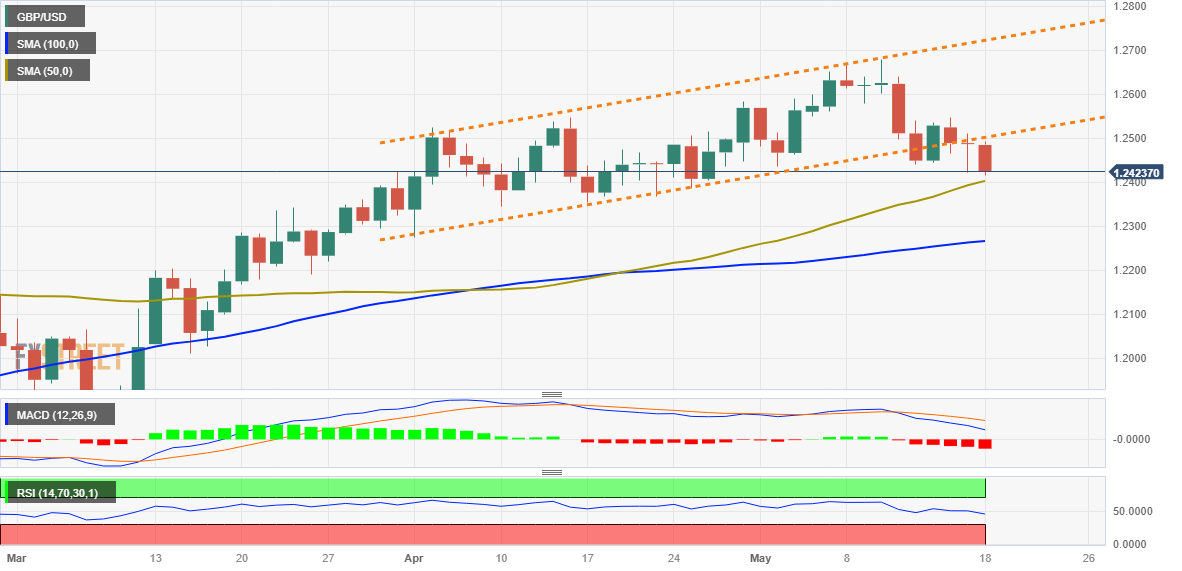
Key levels to watch
- Gold price remains under heavy selling pressure on Thursday and drops to its lowest level since April.
- The USD jumps to a nearly two-month top and turns out to be a key factor weighing on the XAU/USD.
- The optimism over the US debt ceiling contributes to driving flows away from the safe-haven metal.
Gold price continues drifting lower for the third successive day on Thursday - also marking the sixth day of a negative move in the previous seven - and dives to its highest level since April 03 during the early North American session. The XAU/USD is currently placed around the $1,960-$1,961 region, down over 1% for the day, and seems poised to prolong its recent sharp retracement slide from the all-time high touched earlier this month.
A combination of supporting factors pushes the US Dollar (USD) to a nearly two-month high, which, in turn, is seen weighing heavily on the Gold price. Against the backdrop of the recent hawkish signals from several Federal Reserve (Fed) officials, the optimism over the potential lifting of the US debt ceiling remains supportive of the elevated US Treasury bond yields and acts as a tailwind for the Greenback. The intraday USD buying picks up pace following the release of the mostly upbeat US macro data, which showed that Initial Jobless Claims fell to 242K last week and the Philly Fed Manufacturing Index improved to -10.4 in May from -31.3 previous.
Adding to this, Dallas Fed President Lorie Logan said that the economic data points so far don’t justify skipping a rate increase at the central bank’s next meeting in June. This, in turn, reaffirms expectations that the US central bank will keep rates higher for longer and contributes to driving flows away from the non-yielding Gold price. Meanwhile, US President Joe Biden and top US congressional Republican Kevin McCarthy on Wednesday underscored their determination to reach an agreement soon to raise the federal government’s $31.4 trillion debt ceiling. This helps calm market fears of an unprecedented American debt default and undermines the safe-haven metal.
Apart from this, the downfall could further be attributed to some technical selling following the overnight breakdown through the $1,980 horizontal support. A subsequent slide below the $1,970 level could be seen as a fresh trigger for bearish traders and might have already set the stage for a further near-term depreciating move. Hence, some follow-through decline towards the $1,950-$1,948 intermediate support, en route to the 100-day Simple Moving Average (SMA), currently pegged near the $1,925 area, looks like a distinct possibility.
Technical levels to watch
Dallas Federal Reserve President Lorie Logan said on Thursday, as reported by CNBC, on a speech due later at the Texas Bankers Association 138th Annual Convention, that data at this time does not support skipping an interest rate hike at the next meeting in June.
Logan mentioned that the Federal Reserve still has work to do to achieve its goal of price stability, which she considers a critical priority. She has an open mind ahead of the next Federal Open Market Committee (FOMC) meeting. According to her, the effects of banking stress on tightening are comparable to a 25-50 basis point increase.
The CME FedWatch Tool shows the odds of a rate hike at the June meeting at 35.6%, up from 28% yesterday and 10% a week ago.
Market reaction
The US dollar is rising across the board, supported by Logan’s comments and recent US economic data. The DXY trades at 103.34, up 0.45% for the day, at the highest level since mid-March.
Strategists at Société Générale analyze Copper’s technical outlook.
Risk of a deeper pullback towards 7945 on failure to defend 8070
“Copper has revisited the potential support near 8090/8070 representing confluence of a multi-month trend line, the lower band of a steep channel and projections for the decline since January.” “Formation of a daily bullish engulfing denotes possibility of a rebound towards the channel upper limit near 8450. A cross above this is essential for denoting an extended bounce.”
“In the event Copper fails to defend 8070, there is risk of a deeper pullback towards 7945, the 61.8% retracement from July 2022 and 7810.”
- USD/JPY turns positive for the sixth straight day and refreshes the YTD top on Thursday.
- The prevalent bullish sentiment surrounding the USD remains supportive of the move.
- The Fed-BoJ policy divergence and a breakout through 138.00 favour bullish traders.
The USD/JPY pair attracts fresh buying following an intraday dip to the 137.30-137.25 region on Thursday and turns positive for the sixth successive day. Spot prices build on the previous day's breakout momentum beyond a technically significant 200-day Simple Moving Average (SMA) and climb to a fresh YTD peak, around the 138.25 region during the early North American session.
The US Dollar (USD) buying remains unabated amid the latest optimism over the potential lifting of the potential lifting of the US debt ceiling, which, in turn, is seen as a key factor acting as a tailwind for the USD/JPY pair. In fact, US President Joe Biden and top U.S. congressional Republican Kevin McCarthy underscored their determination to reach an agreement soon to raise the federal government’s $31.4 trillion debt ceiling.
This helps calm fears of an unprecedented American debt default, which boosts investors' confidence and dents demand for safe-haven assets, including the Japanese Yen (JPY). Apart from this, expectations that the Federal Reserve will keep interest rates higher for longer, remain supportive of elevated US Treasury bond yields. The aforementioned fundamental factors continue to underpin the buck and push the USD/JPY pair higher.
The USD sticks to its intraday gains following the release of better-than-expected US macro data, showing that the Initial Jobless Claims fell to 242K last week and the Philly Fed Manufacturing Index improved to -10.4 in May from -31.3 previous. The JPY, on the other hand, is further weighed down by a dovish stance adopted by the Bank of Japan (BoJ) and a deceleration in Japan's export growth to its weakest pace in more than two years in April.
This, in turn, suggests that the path of least resistance for the USD/JPY pair is to the upside. Even from a technical perspective, a sustained move beyond the 138.00 round-figure mark could be seen as a fresh trigger for bullish traders and supports prospects for a further near-term appreciating move. Hence, some follow-through strength towards the next relevant hurdle, near the 138.70-138.75 region, looks like a distinct possibility.
Technical levels to watch
- Initial Jobless Claims in the US decline by 22,000 in the week ending May 13.
- Continuing Jobless Claims decrease by 8,000 in the week ending May 6.
- US Dollar Index resumes rally after Jobless Claims and Philly Fed.
Initial Jobless claims totaled 242,000 in the week ending May 13, the weekly data published by the US Department of Labor (DOL) showed on Thursday. The print follows the previous week's 264,000 and came in below market expectations of 254,000. "The 4-week moving average was 244,250, a decrease of 1,000 from the previous week's unrevised average of 245,250."
Continuing Claims decreased by 8,000 in the week ended May 6 to 1.799 million, below the 1.818 million of market consensus. It is the lowest reading in nine weeks. "The 4-week moving average was 1,812,500, a decrease of 15,500 from the previous week's revised average."
Market reaction
The US Dollar (USD) rose following the release of Jobless Claims and the Philly Fed. The US Dollar Index jumped to the highest level since late March above 103.20. Later on Thursday, the April Existing Home Sales report is due.
- Philadelphia Fed Manufacturing Index came in better than expected in May.
- US Dollar Index rises to fresh monthly highs above 103.20.
The diffusion index for current general activity of the Federal Reserve Bank of Philadelphia's Manufacturing Survey rose to -10.4 in May from the three-year low of -31.3 reported in April and was above the market expectation of -19.8.
Key takeaways from the report:
Manufacturing activity in the region continued to decline overall, according to the firms responding to the May Manufacturing Business Outlook Survey. The survey’s indicators for general activity, new orders, and shipments rose from last month but remained negative.
The indexes for new orders and shipments both increased for the second consecutive month but remained negative. The index for current new orders rose 14 points to -8.9, and the current shipments index edged up 3 points to -4.7.
On balance, the firms also reported a decline in employment. The price indexes remained below long-run averages, with the prices received index declining further. The survey’s future indexes continued to reflect muted expectations for growth over the next six months.
The employment index fell from -0.2 to -8.6, the index’s third consecutive negative reading. Over 15 percent of the firms reported a decrease in employment, and 7 percent reported an increase; most firms (76 percent) reported no change. The average workweek index was little changed at ‑7.7.
The prices paid diffusion index ticked up 3 points to 10.9, after reaching a near three-year low last month. Over one-quarter of the firms reported increases in input prices, and 15 percent reported decreases; 59 percent reported no change. The current prices received index fell 4 points to -7.0, its fourth consecutive decline and lowest reading since April 2020.
The diffusion index for future general activity declined 9 points to -10.3, the index’s third consecutive negative reading.
Market reaction
The Greenback gained momentum after the release of Jobless Claims and the Philly Fed, hitting fresh daily highs versus its main rivals. The DXY trades at monthly highs above 103.20. The April Existing Home Sales report is scheduled to be released later on Thursday.
- EUR/USD extends the bearish move and challenges 1.0800.
- The loss of the round level puts the April low at 1.0788 on the radar.
EUR/USD accentuates the selling bias and trades just pips away from the key support at 1.0800 on Thursday.
The 1.0800 area appears supported by the temporary 100-day SMA (1.0804) and the loss of this region could trigger a deeper retracement to, initially, the April low at 1.0788 (April 3). Further south emerges the March bottom of 1.0516 (March 15).
Looking at the longer run, the constructive view remains unchanged while above the 200-day SMA, today at 1.0462.
EUR/USD daily chart
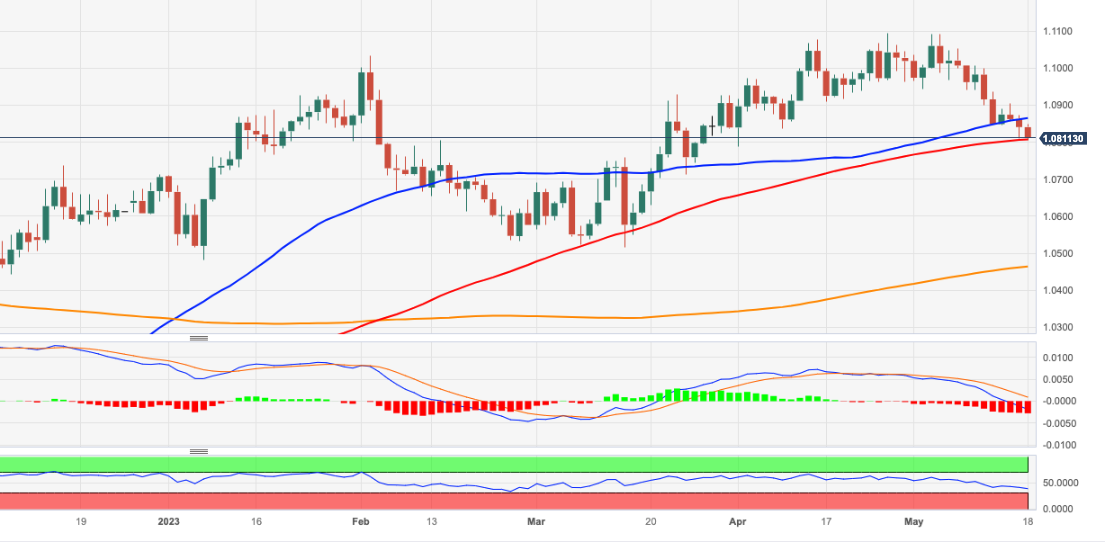
Economists at Credit discuss Suisse FX market outlook amid debt ceiling fears.
If taking a short USD view is seen as essential, CHF and JPY are the obvious counterparts
“As far as the debt ceiling is concerned, markets, in general, continue to show very little imminent sense of danger.”
“The problem is that picking USD direction in the event of a debt default is not easy. While in theory, the currency should suffer due to self-inflicted problems, in practice a USD funding shock could arise too that actually boosts the greenback in the first instance. This suggests FX hedges that play for higher FX volatility are probably a better option than those that look for clear and consistent directionality.”
“If taking a short USD view is seen as essential, we would stick to the likes of CHF and JPY as the obvious counterparts as more pro-cyclical currencies could easily falter in a US default environment.”
- DXY needs to consolidate the breakout of the 103.00 barrier.
- Further north emerges the 200-day SMA near 105.80.
DXY extends the march north for the third session in a row and clinches fresh 6-week highs near 103.20 on Thursday.
Further upside seems like the most probable scenario for the index so far. Against that, a sustained move further north of the 103.00 hurdle should alleviate the downside pressure and encourage DXY to set sail to the key 200-day SMA near 105.80 just ahead of the YTD peak at 105.88 (March 8).
The index is seen facing the next resistance level of significance not before the 2023 top of 105.79 (March 8).
Looking at the broader picture, while below the 200-day SMA today at 105.80, the outlook for the index is expected to remain negative.
DXY daily chart
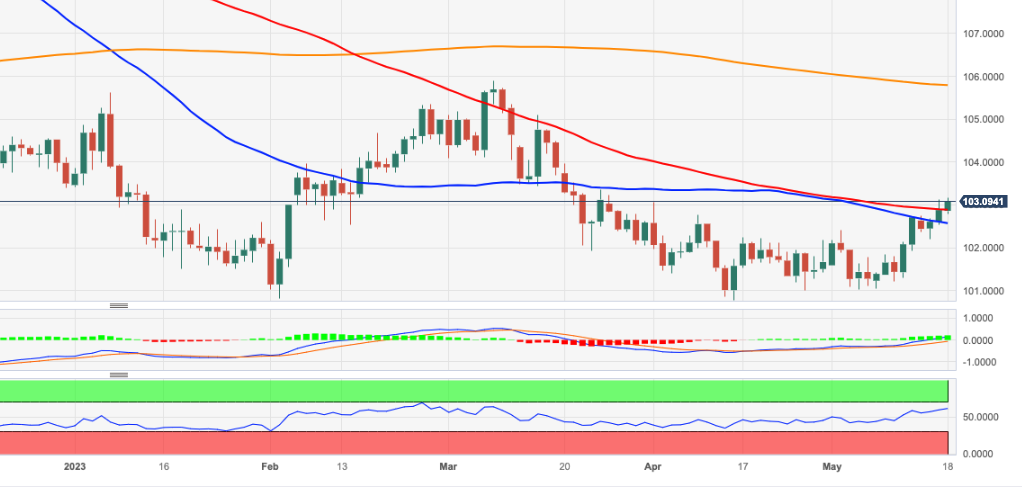
Economist at UOB Group Ho Woei Chen, CFA, reviews the latest set of data releases in the Chinese economy.
Key Takeaways
“China’s Apr data largely missed expectations which increased concerns that its economic recovery momentum has failed to sustain. The year-on-year growth rates of industrial production and retail sales were bumped up by the low comparison base from Shanghai lockdown last year but were slower than expected, particularly for industrial production.”
“The labour market recovery is still uneven while new entrants and fresh graduates are still facing hiring difficulties as seen in the surge in youth unemployment to record high.”
“Market’s expectations of the rebound in China may need to be toned down as the slowdown in external demand is exerting a far greater downside pressure on China. Furthermore, the latest data showed that China is still undergoing a property market downturn which continued to hamper investment and keep the consumer sentiment soft.”
“PBOC kept the 1Y medium-term lending facility (MLF) rate unchanged at 2.75% in May, the 9th consecutive month that it has been held steady. The central bank continued to maintain ample liquidity with net liquidity injection of CNY25 bn via MLF this month, bringing total net injection to CNY604 bn in the first five months via the MLF tool.”
“We maintain our call for another RRR cut this year but see less chance of a resumption in interest rate cut.”
- EUR/JPY’s weekly recovery meets initial hurdle near 149.30.
- Extra upside seems on the cards once 149.30 is cleared.
EUR/JPY struggles to advance further north of the 149.25/30 band on Thursday.
Once the cross surpasses the weekly high at 149.26 (May 8, 18) with some conviction, it could then embark on a probable move to the key round level at 150.00 prior to the 2023 top at 151.61 (May 2).
So far, further upside looks favoured while the cross trades above the 200-day SMA, today at 143.23.
EUR/JPY daily chart
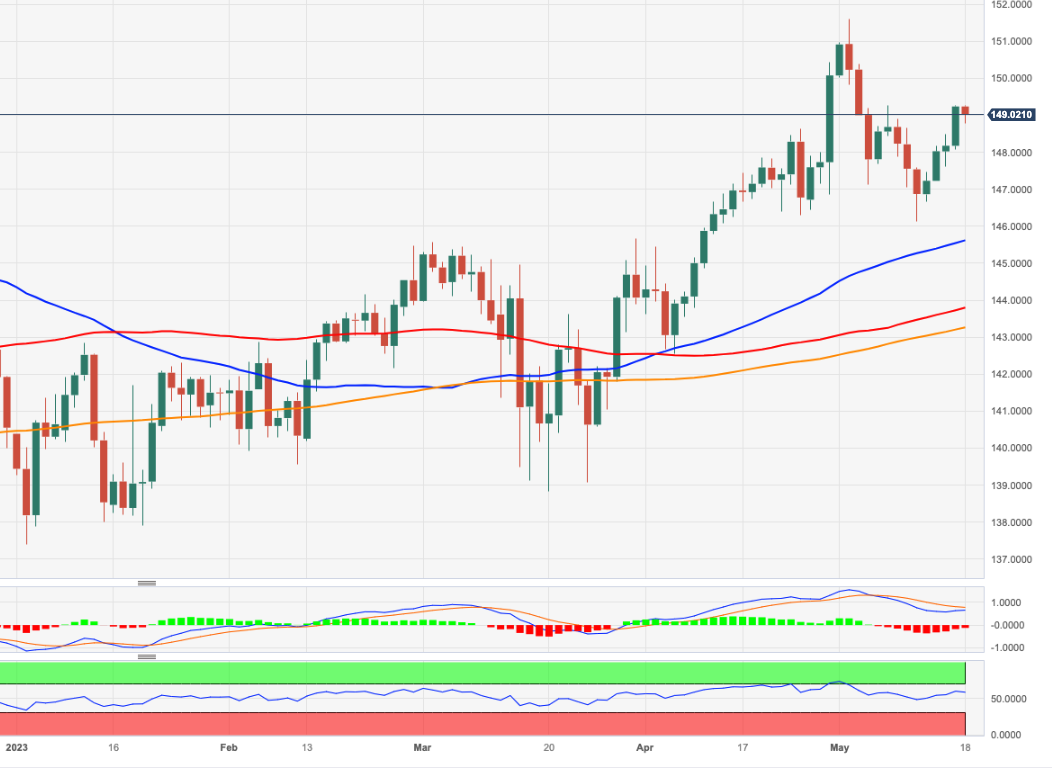
Soft Australian jobs data have dragged the Aussie lower. AUD/USD is on track to challenge the 0.6560 mark, Kit Juckes, Chief Global FX Strategist at Société Générale report.
Gloom surrounds the AUD
“Employment fell by -4.3K after 113K in gains over the two previous months, but I’d rather look at the underlying trend which is a 28K monthly average gain in the first four months of the year, and a 32K average gain over the last 12 months.”
“Underlying employment growth is slowing slowly to just under 3% per annum, a rate most countries would love to see. Still, with the chances of further RBA hikes receding, AUD is set to test the bottom of the current range, around 0.6560.”
Further upside appears in store for USD/CNH in the short-term horizon, note UOB Group’s Economist Lee Sue Ann and Markets Strategist Quek Ser Leang.
Key Quotes
24-hour view: “We held the view yesterday that USD ‘could strengthen further but the next major resistance at 7.0500 is unlikely to come into view’. We added, ‘there is a minor resistance at 7.0200’. Our view was not wrong USD soared to 7.0225 before ending the day at 7.0110. While the sharp and swift rally appears to be overdone, there is room for the rally to extend to 7.0300 before easing. The major resistance at 7.0500 is still unlikely to come into view for now. Support is at 7.0020, followed by 6.9900.”
Next 1-3 weeks: “There is no change in our view from yesterday (17 May, spot at 7.0005). As highlighted, after breaking above 7.0000, the outlook for USD remains positive. The next level to watch is 7.0500. We will hold a positive USD view as long as it stays above 6.9750 (‘strong support’ level was at 6.9560 yesterday). A break below 6.9750 would indicate the USD strength that started last Friday has eased.”
Economists at MUFG Bank expect USD/JPY to benefit as debt ceiling fears ease.
USD/JPY takes the lead
“With monetary easing priced in at a relatively early stage of the curve, improved risk can come to support the Dollar. When the source of the improved risk is US-specific, the catalyst for USD strength is more compelling. That source of course is the improved optimism over the potential for a debt ceiling deal being reached soon after President Biden returns from the G7 in Japan. Rhetoric from both Biden and Kevin McCarthy suggests progress.”
“USD/JPY would in our view be the currency that would fall most in a scenario of debt ceiling related turmoil and in that sense it is not a surprise to see it as the biggest mover higher within G10.”
“137.77 and 137.91, the May and March highs respectively, are the key levels and an imminent breach of these highs look more likely now.”
Economists at Société Générale analyze the USD/MXN outlook ahead of the Banxico meeting.
Break below 17.45 can lead USD/MXN towards next projections at 17.10/16.95
“Banxico is likely to pause monetary tightening today and leave the key rate at 11.25%. Another hike would be a surprise, but would not be guaranteed to be welcomed by the Peso if investors view the move through a negative lens for economic growth.”
“An initial bounce is not ruled out however 17.90 must be overcome for affirming a meaningful up move. Failure could mean persistence in down move.”
“Break below 17.45 can lead the pair towards next projections at 17.10/16.95 which is also the low formed in 2016.”
Upside in Oil remains amid an undersupplied market, according to strategists at UBS.
Several main reasons to expect the Oil market to be under supplied in coming months
“We now see the Brent price reaching $95 a barrel by the end of this year, down from our previous forecast of $105/bbl, as we expect Russian oil output to stay at around 9.6 million barrels per day (mbpd) instead of 9 mbpd in the second half of this year. However, this means an upside of over 25% from current levels.”
“We still see several main reasons to expect the Oil market to be under supplied in coming months: The International Energy Agency sees robust global Oil demand. Inventory draws are set to be more visible in the months ahead. OPEC+ cuts should tighten the market further amid other supply constraints.”
- Gold price continues losing ground for the third straight day and drops to a nearly one-month low.
- A combination of factors continues to boost the US Dollar and drive flows away from the XAU/USD.
- Worries about a global economic slowdown could lend some support to the safe-haven commodity.
Gold price drifts lower for the third successive day - also marking the sixth day of a negative move in the previous seven - and drops to a nearly one-month low during the first half of the European session. The XAU/USD currently trades just above the $1,970 level, down nearly 0.50% for the day, and is pressured by a combination of factors.
Sustained US Dollar buying continues to weigh on Gold price
The US Dollar (USD) prolongs its recent uptrend witnessed over the past two weeks or so and touches a fresh high since March 24, which, in turn, is seen driving flows away from the US Dollar-denominated Gold price. Against the backdrop of speculations that the Federal Reserve (Fed) will keep interest rates higher for longer, the optimism over the potential lifting of the debt ceiling in the United States (US) remains supportive of elevated US Treasury bond yields and underpins the USD.
US debt ceiling optimism further undermines the safe-haven XAU/USD
It is worth recalling that the recent hawkish comments by several Fed officials pushed back against market expectations for rate cuts later this year. Furthermore, US President Joe Biden and top congressional Republican Kevin McCarthy underscored their determination to strike a deal soon to raise the government's $31.4 trillion debt ceiling. This helps calm fears of an unprecedented American debt default and boosts investors' confidence, which further weighs on the safe-haven Gold price.
Looming recession fears could lend some support to Gold price
Market participants, however, remain worried about slowing global growth, particularly in China, which could lend support to the XAU/USD and help limit deeper losses, at least for the time being. Traders might also refrain from placing aggressive bets ahead of Fed Chair Jerome Powell's appearance on Friday. Investors will look for fresh clues about the US central bank's near-term policy outlook, which should help determine the next leg of a directional move for the Gold price.
Thursday’s US macro data and Fed speaks eyed for fresh impetus
In the meantime, traders will look to Thursday's US economic docket, featuring the release of the usual Weekly Initial Jobless Claims, the Philly Fed Manufacturing Index and Existing Home Sales, for some impetus. Apart from this, scheduled speeches by Fed members, the US bond yields and the US debt-limit negotiations will influence the USD price dynamics. This, along with the broader risk sentiment, could produce short-term trading opportunities around the Gold price.
Gold price technical outlook
From a technical perspective, some follow-through selling below the $1,970 horizontal support might be seen as a fresh trigger for bearish traders. This could make the Gold price vulnerable to prolonging its recent corrective pullback from the all-time high, around the $2,078-$2,079 area touched earlier this month. The XAU/USD might then accelerate the fall towards testing the 100-day Simple Moving Average (SMA), currently pegged near the $1,925 region, with some intermediate support near the $1,950-$1,948 region.
On the flip side, any attempted recovery above the $1,980 level is likely to confront stiff resistance and remain capped near the $2,000 psychological mark. That said, a sustained strength beyond might trigger a short-covering rally and lift the Gold price to the $2,020-$2,021 hurdle en route to the $2,035-$2,040 region. Some follow-through buying should allow the XAU/USD to climb back towards the all-time high and extend the momentum further towards conquering the $2,100 round-figure mark.
Key levels to watch
Bank of England (BoE) Deputy Governor Ben Broadbent testifies before the UK parliament's Treasury Select Committee (TSC) about the central bank's sales of bonds bought under its quantitative easing programme.
Key quotes
Received reports that GBP100 billion/ year of QT might disturb market liquidity, so decided on GBP80 billion.
more to come ...
Bank of England (BoE) Deputy Governor Dave Ramsden testifies before the UK parliament's Treasury Select Committee (TSC) about the central bank's sales of bonds bought under its quantitative easing programme.
Key quotes
QT has some effect on economy, but fairly small.
QT will be gradual and predictable; we are not flying blind.
We won't definitely go for 80 bln stg of QT for next year, as would mean slower active sales.
There's potential for us to go up in QT sales, don't see us going down.
Related reads
-
BoE’s Bailey: I don't envisage balance sheet returning to where it was before financial crisis
Bank of England (BoE) Governor Andrew Bailey faces questions by the UK parliament's Treasury Select Committee (TSC) about the central bank's sales of bonds bought under its quantitative easing programme.
Key quotes
I don't envisage the balance sheet returning to where it was before financial crisis.
It's important to provide headroom in balance sheet.
QT is not an active policy tightening instrument.
We have not seen market reaction to our qt announcements.
more to come ....
Market reaction
GBP/USD is little changed by Bailey’s words, currently trading at 1.2437, down 0.40% on the day.
EUR/GBP maintains its break of key support from the series of lows for the year at 0.8729/18. Economists at Credit Suisse expect the pair to suffer further losses.
Resistance at 0.8770 set to cap
“We continue to look for a more concerted downturn, with support seen initially at 0.8648/40, ahead of the uptrend from early 2022, now at 0.8605. Whilst we would look for this to hold initially, we look for a break in due course for the ‘measured top objective’ at 0.8455.”
“Resistance at 0.8770 ideally caps.”
The continuation of the upside momentum could lift USD/JPY to the 139.00 region in the next few weeks, comment UOB Group’s Economist Lee Sue Ann and Markets Strategist Quek Ser Leang.
Key Quotes
24-hour view: “While we expected USD to rise further yesterday, we held the view that ‘a clear break above 136.80 is unlikely’. We did not anticipate the sharp rally as USD surged to a high of 137.71. Today, USD could break above the month-to-date high near 137.80 but in view of the severely overbought conditions, it might not be able to maintain a foothold above this level. The next major resistance at 139.00 is unlikely to come under threat. Support is at 137.10, followed by 136.70.”
Next 1-3 weeks: “Three days ago on Monday (15 May, spot at 135.80), we indicated that the risk for USD ‘has shifted to the upside’. We noted, there is solid resistance at 136.80 ahead of the early May high near 137.80. USD rose for the past few days and yesterday (17 May), it soared to a high of 137.71. While 137.80 remains solid resistance, a break of this level is not ruled out and would shift the focus to 139.00. In view of the severely overbought conditions, we expect the pace of any further advance to be slower. All in all, only a breach of 136.00 (‘strong support’ level previously at 135.30) would indicate the current upward pressure has eased.”
- EUR/USD adds to the weekly decline near 1.0800.
- ECB’s De Guindos leaves the door open to extra rate hikes.
- President C. Lagarde speaks later in the session.
Further selling pressure continues to hurt the European currency and forces EUR/USD to recede further and trade at shouting distance from the key barrier at 1.0800 the figure on Thursday.
EUR/USD weaker on USD-buying, risk-off trade
EUR/USD gives away further ground and retreats for the third straight session on Thursday, putting at the same time the 1.0800 key support to the test amidst the intense march north in the greenback.
As usual in past sessions, the persevering risk-off mood remains propped up by lingering jitters around the US debt ceiling issue, which in turn lends support to the renewed upside bias in the buck.
Also weighing on the single currency appears the now milder tone from ECB’s rate setters, after Vice-President L. De Guindos argued earlier in the session that the bank has already done most of the tightening despite hinting at the probability of extra hikes in the next periods. His colleague A. Müller (usual hawk), instead, ruled out the possibility of rate cuts early next year.
In the euro docket, President C. Lagarde will speak later on Thursday in what will be the sole event this side of the Atlantic. In the NA session, Initial Jobless Claims are due in the first turn followed by the Philly Fed Manufacturing index, Existing Home Sales and the CB Leading Index. Additionally, FOMC’s P. Jefferson, L. Logan and M. Barr are all due to speak.
What to look for around EUR
EUR/USD extends the weekly decline and gradually approaches the key 1.0800 neighbourhood as the trading week draws to a close.
The movement of the euro's value is expected to closely mirror the behaviour of the US Dollar and will likely be impacted by any differences in approach between the Fed and the ECB with regards to their plans for adjusting interest rates.
Moving forward, hawkish ECB-speak continue to favour further rate hikes, although this view appears in contrast to some loss of momentum in economic fundamentals in the region.
Key events in the euro area this week: ECB Lagarde (Thursday).
Eminent issues on the back boiler: Continuation of the ECB hiking cycle in June and July (September?). Impact of the Russia-Ukraine war on the growth prospects and inflation outlook in the region. Risks of inflation becoming entrenched.
EUR/USD levels to watch
So far, the pair is retreating 0.19% at 1.0817 and faces immediate contention at 1.0809 (monthly low May 18) seconded by 1.0805 (100-day SMA) and finally 1.0788 (monthly low April 3). On the flip side, the breakout of 1.1095 (2023 high April 26) would target 1.1100 (round level) en route to 1.1184 (weekly high March 21 2022).
- USD/CAD regains positive traction on Thursday and draws support from sustained USD buying.
- A modest downtick in Oil prices undermines the Loonie and contributes to the intraday uptick.
- The fundamental backdrop favours bullish traders and supports prospects for additional gains.
The USD/CAD pair attracts fresh buying on Thursday and maintains its bid tone through the first half of the European session, reversing a major part of the previous day's modest losses. The pair currently trades around the 1.3470-1.3475 region, up less than 0.15% for the day, and is influenced by a combination of diverging forces.
The US Dollar (USD) scales higher for the third successive day, also marking the fifth day of a positive move in the previous six, and climbs to a fresh high since March 24, which, in turn, lends some support to the USD/CAD pair. The recent hawkish comments by several Federal Reserve (Fed) officials fueled speculations that the US central bank will keep interest rates higher for longer. This, along with the US debt ceiling optimism, remains supportive of elevated US Treasury bond yields and continues to push the USD higher.
In fact, US President Joe Biden and top congressional Republican Kevin McCarthy underscored their determination to strike a deal soon to raise the government's $31.4 trillion debt ceiling. This helps calm fears of an unprecedented American debt default and boosts investors' confidence, which is evident from a generally positive tone around the equity markets and might cap the safe-haven Greenback. Apart from this, the overnight rally in Crude Oil prices underpins the commodity-linked Loonie and keeps a lid on the USD/CAD pair.
A sharp drop in US gasoline inventories pointed to some improvement in demand and helped the black liquid to register strong gains of more than $2 on Wednesday. Market participants remain worried that a global economic slowdown, particularly in China, will dent fuel demand. This, in turn, acts as a headwind for Oil prices and supports prospects for a further appreciating move for the USD/CAD pair. That said, the overnight failure to find acceptance above the 100-day Simple Moving Average (SMA) warrants caution for bulls.
Market participants now look to the US economic docket, featuring the release of the usual Weekly Initial Jobless Claims, the Philly Fed Manufacturing Index and Existing Home Sales later during the early North American session. Traders will further take cues from speeches by influential FOMC members. Apart from this, the US bond yields, the US debt-limit negotiations and the broader risk sentiment will drive the USD demand. This, along with Oil price dynamics, might contribute to producing short-term trading opportunities around the USD/CAD pair.
Technical levels to watch
Time for the Dollar to pause? We could see a pause in the Dollar appreciation today, economists at ING report.
Jobless claims might deliver another bad surprise to the greenback
“With EUR/USD close to the pivotal 1.0800 support level and the news coming from Washington admittedly more encouraging, we could see a stabilisation, or a small correction in the Dollar, rather than further appreciation today.”
“Data will also be in focus in the US with jobless claims, which surprised on the upside recently, expected to decline from 264K to 252K, possibly carrying some downside risk to the greenback.”
The likelihood that NZD/USD could retreat to the 0.6150 region in the short term appears to have dwindled according to UOB Group’s Economist Lee Sue Ann and Markets Strategist Quek Ser Leang.
Key Quotes
24-hour view: “Yesterday, we expected NZD to trade in a range of 0.6215/0.6260. However, NZD traded in a higher range of 0.6228/0.6273. There is no clear directional bias for now and today, we expect NZD to trade sideways between 0.6230 and 0.6280.”
Next 1-3 weeks: “Our latest narrative was from Monday (15 May, spot at 0.6295) wherein NZD could continue to decline, albeit likely at a slower pace. We indicated that the next level to watch is 0.6155. Since then, NZD has not been able to make any headway to the downside and as downward momentum is beginning to ease, the likelihood of NZD dropping to 0.6155 has decreased. However, only a break of 0.6280 (no change in ‘strong resistance’ level) would indicate that NZD is likely to trade sideways instead of declining further.”
In light of advanced prints from CME Group for natural gas futures markets, open interest reversed two consecutive daily pullbacks and rose slightly by just 186 contracts on Wednesday. On the other hand, volume extended the downtrend for the third session in a row, this time by around 14.1K contracts.
Natural Gas remains supported around $2.00
Prices of the natural gas charted an inconclusive session on Wednesday. The daily price action was on the back of a small uptick in open interest and declining volume, exposing further consolidation for the time being. In the meantime, bouts of weakness appear so far contained by the $2.00 region per MMBtu.
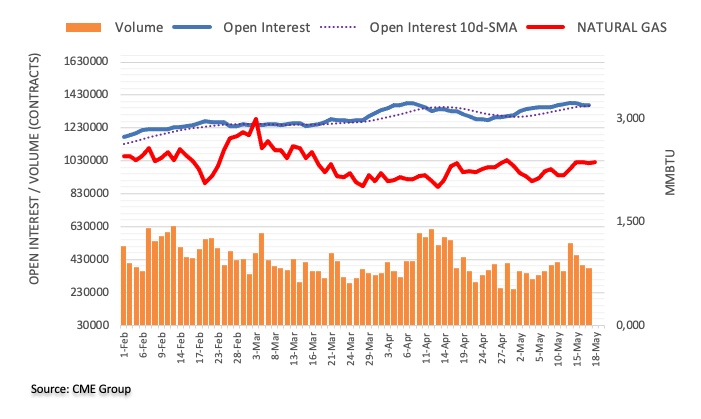
GBP/USD has been capped as looked for at 1.2668/1.2758 long-held target. Analysts at Credit Suisse expect Cable to suffer further falls.
Resistance at 1.2681 set to cap fresh strength if see
“GBP/USD has been capped as looked for at our core target at 1.2668/1.2758 and our bias remains to look for an important top here. Below support at 1.2435 can add weight to our view for a fall to the 55-DMA and price support at 1.2353/44, but with this ideally holding at first. Below 1.2344 in due course can confirm a larger top with support then seen next at 1.2130.”
“Resistance at 1.2681 ideally caps fresh strength if seen. Above 1.2758 though stays seen needed to suggest strength can extend further to 1.3000 next, although this is not our base case.”
In the opinion of UOB Group’s Economist Lee Sue Ann and Markets Strategist Quek Ser Leang, GBP/USD could retreat further and break below the 1.2400 support in the near term.
Key Quotes
24-hour view: “Yesterday, we held the view that GBP ‘is under mild downward pressure’ and ‘could edge lower but a sustained drop below 1.2440 is unlikely’. In London trade, GBP dropped to 1.2422 but the decline was brief as it rebounded to end the day unchanged at 1.2487. The price movements are likely part of a consolidation phase and today, we expect GBP to trade in a range of 1.2440 and 1.2525.”
Next 1-3 weeks: “Our most recent narrative was from Monday (15 May, spot at 1.2455) wherein GBP is likely to weaken further to 1.2390 but oversold short-term conditions could slow the pace of any further decline. Yesterday (17 May), GBP dropped to 1.2422 and then rebounded. We continue to hold the same view. Only a breach of 1.2560 (no change in ‘strong resistance’ level) would indicate that 1.2390 is not coming into view.”
CME Group’s flash data for crude oil futures markets noted traders reduced further their open interest positions on Wednesday, this time by around 18.5K contracts. Volume, instead, remained erratic and went up by around 250.4K contracts.
WTI: Upside remains limited near $74.00
Wednesday’s marked advance in prices of the WTI was on the back of shrinking open interest, which is suggestive that extra gains appear not favoured for the time being. In the meantime, occasional bullish attempts in the commodity should meet initial hurdle around the $74.00 mark per barrel.

EUR/USD is trading on the defensive below 1.0850 but chances of a break lower have declined, economists at ING report.
We could see a stabilisation in EUR/USD today
“The improvement in the rhetoric by Biden and McCarthy and the positive reaction in US equity markets suggests we could see a stabilisation in EUR/USD today.”
“The chances of 1.0800 being tested remain tangible, but those of a decisive break lower have likely declined.”
See – EUR/USD: Not minded to buy this dip below 1.0900 – Credit Suisse
- USD/CHF struggles to gain any meaningful traction and remains below the 0.9000 mark.
- The downside remains cushioned amid the underlying bullish sentiment around the USD.
- Worries about a global economic slowdown benefit the safe-haven CHF and cap the upside.
The USD/CHF pair attracts some dip-buying on Thursday, albeit struggles to capitalize on the intraday uptick beyond the 0.9000 psychological mark. Spot prices, however, stick to a mildly positive bias through the early European session and remain well within the striking distance of a nearly five-week high touched on Wednesday.
The US Dollar (USD) edges higher for the third successive day and stands tall near its highest level since March 24, which, in turn, is seen as a key factor acting as a tailwind for the USD/CHF pair. The recent hawkish remarks by several Federal Reserve (Fed) officials fueled speculations that the US central bank will keep interest rates higher for longer. This, along with the latest optimism that the US debt ceiling will be raised, remains supportive of elevated US Treasury bond yields and continues to underpin the Greenback.
In fact, US President Joe Biden and top congressional Republican Kevin McCarthy underscored their determination to strike a deal soon to raise the government's $31.4 trillion debt ceiling. This, in turn, suggests that the path of least resistance for the USD/CHF pair is to the upside. That said, worries over slowing global growth lend some support to the safe-haven Swiss Franc (CHF) and cap any further gains. Furthermore, the lack of strong follow-through buying warrants some caution before placing fresh bullish bets.
Market participants now look to the US economic docket, featuring the release of the usual Weekly Initial Jobless Claims, the Philly Fed Manufacturing Index and Existing Home Sales later during the early North American session. Traders will further take cues from speeches by influential FOMC members, which, along with the US bond yields, will drive the USD demand. Apart from this, developments surrounding the US debt-limit negotiations and the broader risk sentiment might provide some impetus to the USD/CHF pair.
Technical levels to watch
Economists at ING discuss BoE outlook and its implications for Sterling.
EUR/GBP to climb from these levels
“Some comments from Bank of England Governor Andrew Bailey yesterday did not add much to the recent BoE rhetoric. Expectations are for a rapid decline in inflation, but policymakers remain ready to react to signs of persistence in price pressures and will be closely monitoring wages, services and labour tightness.”
“Given the Sonia curve currently prices in around 19 bps of tightening for June and 40 bps in total before the peak, we think there is plenty of dovish repricing to be passed through to Sterling, and we expect EUR/GBP to climb from these levels: we target 0.88-0.89 this summer.”
- The index extends the weekly recovery around the 103.00 zone.
- The still unsolved debt ceiling remains in centre stage.
- Weekly Claims, Philly Fed index, Fedspeak next on tap.
The USD Index (DXY), which tracks the greenback vs. a basket of its main competitors, keeps the buying interest well and sound near the 103.00 region on Thursday.
USD Index looks at data, debt ceiling
The index so far advances for the third session in a row on the back of persistent uncertainty surrounding the debt ceiling discussion despite the spark of optimism around the issue emerged on Wednesday.
The current march north in the index comes pari passu with further upside in US yields across the curve, where the short end regained the area above the key 4.0% threshold to return to levels last seen in mid-April.
In the US data space, usual weekly Claims are due seconded by the Philly Fed Manufacturing gauge, Existing Home Sales and the CB Leading Index. In addition, FOMC’s P. Jefferson (permanent voter, centrist) and Dallas Fed L. Logan (voter, centrist) are due to speak along with the testimony by FOMC’s M. Barr (permanent voter, centrist) before the US Senate.
What to look for around USD
The index keeps the optimism well in place for yet another session and looks to consolidate the recent breakout of the 103.00 barrier.
The index manages well to leave behind the recent multi-week consolidation theme, setting aside at the same time initial weakness following the recent indication that the Fed will probably pause its normalization process in the near future. That said, the future direction of monetary policy will be determined by the performance of key fundamentals (employment and prices mainly).
Favouring an impasse by the Fed appears the persevering disinflation – despite consumer prices remain well above the target – incipient cracks in the labour market, the loss of momentum in the economy and persevering uncertainty surrounding the US banking sector.
Key events in the US this week: MBA Mortgage Applications, Building Permits, Housing Starts (Wednesday) – Philly Fed Index, Initial Jobless Claims, CB Leading Index, Existing Home Sales (Thursday) – Fed J. Powel (Friday).
Eminent issues on the back boiler: Persistent debate over a soft/hard landing of the US economy. Terminal Interest rate near the peak vs. speculation of rate cuts in late 20223. Fed’s pivot. Geopolitical effervescence vs. Russia and China. US-China trade conflict.
USD Index relevant levels
Now, the index is up 0.10% at 102.96 and the break above 103.11 (monthly high May 17) could open the door to 105.79 (200-day SMA) and then 105.88 (2023 high March 8). On the downside, the next support emerges at 101.01 (weekly low April 26) prior to 100.78 (2023 low April 14) and finally 100.00 (psychological level).
European Central Bank (ECB) Vice President Luis de Guindos is delivering a scheduled speech on Thursday, noting that “inflation in services is the most worrying for the ECB.”
“We see investment funds as the biggest risk for EU finance,” he added.
Market reaction
EUR/USD was last seen trading at 1.0827, down 0.12% on the day.
Economists at Credit Suisse discuss EUR/USD, USD/JPY and GBP/USD outlook.
Risk-reward for chasing GBP/USD even after its pullback since last week’s BoE meeting is not attractive
“EUR/USD came somewhat close to our Q2 1.1250 target when it hit 1.1092 in early May. We are not minded to buy this dip below 1.0900 until there is a significant reason to do so, such as a deeper decline in US data that validates current rates pricing.”
“Similarly with USD/JPY, as in recent weeks, we still see no reason to look for a move to emerge towards our original 125.00 Q2 target, with the BoJ’s ongoing dovishness signaled at its late-April meeting suggesting only levels above the 200-DMA at 137.05 offer decent trade location. Even then, like with EUR/USD, negative carry means a trigger is needed to re-engage with USD shorts.”
“Turning to GBP/USD, the pair briefly exceeded our 1.2650 target on 10 May. But with EUR/GBP already at the low end of our long-held 0.8700-0.8900 expected range, the risk-reward for chasing GBP/USD even after its pullback since last week’s BoE meeting is not attractive.”
- NZD/USD remains on the front foot around intraday high inside weekly rising wedge.
- Gradually improving RSI conditions suggest further grinding of Kiwi pair towards the north.
- 200-HMA, fortnight-old horizontal hurdle challenge NZD/USD bulls.
- Clear break of 0.6240 can recall sellers targeting monthly low.
NZD/USD remains firmer around the weekly top as it prints mild gains near 0.6265 during the second consecutive positive day heading into Thursday’s European session. In doing so, the Kiwi pair stays within a bearish chart formation called a rising wedge comprising multiple levels marked since the last Friday.
However, the gradual uplift of the RSI (14) line, not overbought, keeps the NZD/USD buyers hopeful of defying the stated bearish chart formation by crossing the 0.6275 upside hurdle.
Even so, the 200-HMA and a fortnight-old horizontal resistance area, respectively near 0.6285 and 0.6315, can prod the NZD/USD bulls before directing them to the monthly peak of 0.6385.
It’s worth noting that tops marked in February and April highlight the 0.6385-90 area as a short-term key hurdle for the pair to cross. Also acting as an important upside barrier is the 0.6400 round figure.
On the contrary, a downside break of the 0.6240 mark comprising the stated wedge’s lower line can confirm the bearish chart pattern, which theoretically suggests a fall towards the monthly of near 0.6160.
However, the latest swing low and the previous monthly bottom, close to 0.6180 and 0.6110, act as additional downside filters for the NZD/USD pair traders to watch during the quote’s further declines.
Overall, NZD/USD is likely to grind higher but the bearish chart formation and the key Hourly Moving Average (HMA) prod the bulls.
NZD/USD: Hourly chart
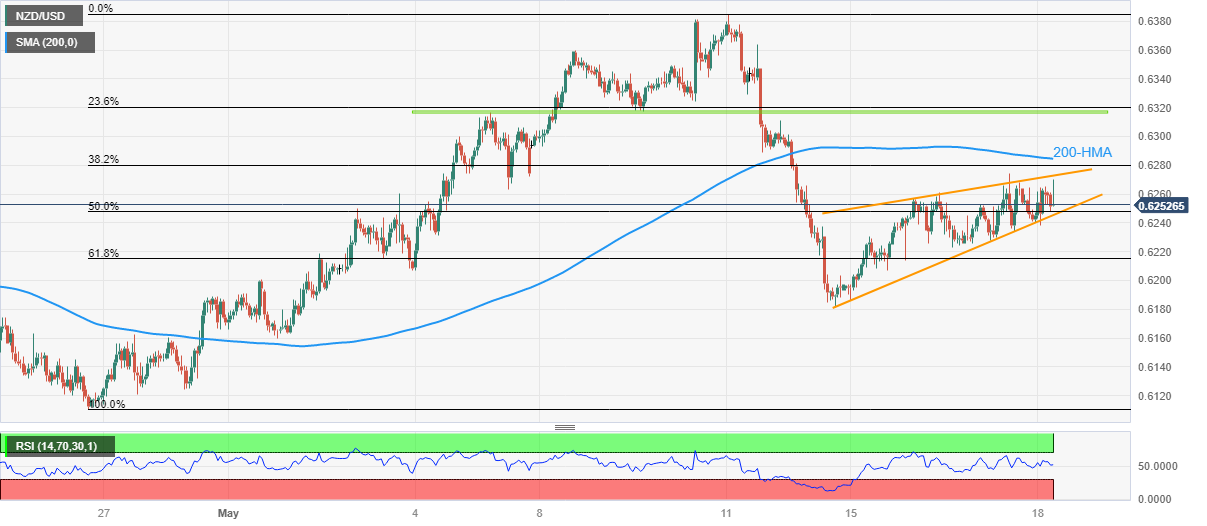
Trend: Limited upside expected
- USD/JPY retreats from over a two-week high touched on Thursday amid some profit-taking.
- The downside remains cushioned amid the prevalent bullish sentiment surrounding the USD.
- The Fed-BoJ policy divergence favours bullish traders and supports prospects for further gains.
The USD/JPY pair pulls back from over a two-week high touched this Thursday and maintains its offered tone through the early European session. Spot prices, for now, seem to have snapped a five-day winning streak and currently trade around mid-137.00s, down nearly 0.15% for the day.
The intraday downtick lacks any obvious fundamental catalyst and could be solely attributed to some profit-taking against the backdrop of the recent rally of around 400 pips witnessed over the past week or so. That said, a combination of factors continues to act as a tailwind for the USD/JPY pair and limit the downside, warranting some caution for aggressive bearish traders.
The US Dollar (USD) stands tall near its highest level since March 24 touched on Wednesday amid speculations that the Federal Reserve (Fed) will keep interest rates higher for longer. The expectations were fueled by the recent hawkish comments by several Fed policymakers, which forced investors to scale back their bets for interest rate cuts during the second half of the year.
This, along with the latest optimism that the US debt ceiling will be raised, remains supportive of elevated US Treasury bond yields and continues to underpin the Greenback. In fact, US President Joe Biden and top congressional Republican Kevin McCarthy underscored their determination to strike a deal soon to raise the government's $31.4 trillion debt ceiling.
The Japanese Yen (JPY), on the other hand, is likely to be undermined by a more dovish stance adopted by the Bank of Japan (BoJ).
Apart from this, a sharp deceleration in Japan's export growth, to its weakest pace in more than two years in April, might contribute to limiting losses for the USD/JPY pair and supports prospects for the emergence of some dip-buying.
The aforementioned fundamental backdrop suggests that the path of least resistance for spot prices is to the upside. Market participants now look forward to the US economic docket, featuring the release of the usual Weekly Initial Jobless Claims, the Philly Fed Manufacturing Index and Existing Home Sales data later during the early North American session.
Traders will further take cues from speeches by influential FOMC members, which, along with the US bond yields, will drive the USD demand and provide some impetus to the USD/JPY pair. Apart from this, developments surrounding the US debt-limit negotiations and the broader risk sentiment should produce short-term trading opportunities around the major.
Technical levels to watch
Here is what you need to know on Thursday, May 18:
The financial markets trade with caution early Thursday, as the haggling over the US debt ceiling continues to underscore default fears. The Asian stocks witnessed limited gains, despite a solid upsurge in Wall Street indices.
On Wednesday, risk sentiment improved and limited the US Dollar’s upbeat momentum after President Biden expressed confidence there’ll be no US default while a rally in regional banks stocks also lifted the overall mood. Regional banks rally was led by Western Alliance Bancorp a day after the lender said its deposits grew by more than $2 billion in the quarter ended May 12.
At the time of writing, the US S&P 500 futures are down 0.11% on the day, hinting at a sense of caution, as investors weigh the latest developments surrounding the US debt ceiling issue. Citing a draft letter written by senators to President Biden, CNBC News reported early Thursday, “we write to urgently request that you prepare to exercise your authority under the 14th Amendment of the Constitution, which clearly states: 'the validity of the public debt of the United States...shall not be questioned.'"
"Using this authority would allow the United States to continue to pay its bills on-time, without delay, preventing a global economic catastrophe,” the letter appealed to Biden.
Meanwhile, the US Dollar Index struggles to extend its recovery momentum following the late pullback on Wednesday. The retreat in the US Treasury bond yields seems to be capping the upside in the US Dollar, for now.
Heading into a data-quiet European calendar, choppy trading is likely to extend within the G10 currencies, with the market sentiment set to the key driver. Later in American trading, attention will be on a bunch of mid-tier US economic data releases, including weekly Jobless Claims, Philly Fed Manufacturing Index and the Existing Home Sales data.
Speeches from the European Central Bank (ECB) and Federal Reserve (Fed) officials will also entertain traders in the sessions ahead.
EUR/USD is trading on the defensive below 1.0850, as the US Dollar holds the previous gains. Financial markets in Germany, Switzerland and France are closed in observance of Ascension Day, leaving the pair gyrating in a familiar range amid thin liquidity.
GBP/USD is holding losses after facing rejection just below 1.2500. The pair stays on the back foot in the European morning ahead of Bank of England (BoE) Governor Andrew Bailey’s testimony on Quantitative Tightening before the UK Parliament’s Treasury Select Committee (TSC) at 09:15 GMT. BoE policymakers Dave Ramsden and Ben Broadbent will also testify.
USD/JPY is consolidating losses near 137.50 after retreating from daily highs of 137.75 to 137.29, tracking the weakness in the US Treasury bond yields. The pair is in the red despite the mixed Japanese Trade data, which showed the country’s exports and imports data fell short of market expectations.
AUD/USD was a big mover in Asia, initially rebounding toward 0.6700 before reversing sharply to near 0.6630 on the back of disappointing Australian employment data. The latest data from the Australian Bureau of Statistics (ABS) showed on Thursday, net employment fell by 4,300 in April from March, when it rebounded by a revised 61,100. Meanwhile, the Unemployment Rate unexpectedly rose to 3.7% during the same period. Currently, the pair is trading at around 0.6650, digesting upbeat comments from China’s Ambassador to Australia.
NZD/USD is regaining ground above 0.6250 as New Zealand’s yields spiked after the NZ Treasury called for a no recession in its Budget release.
USD/CAD is paring back gains toward 1.3450 amid a steady US Dollar and a minor pullback in WTI prices after Wednesday’s nearly 4% rally.
Gold price remains vulnerable while below the 50-Daily Moving Average (DMA), looking to extend the previous declines toward the $1,970 round figure.
Risk-averse trading is also witnessed across the crypto board, with Bitcoin edging lower toward $27,000 while Ethereum defends the $1,800 mark so far.
Open interest in gold futures markets decreased for the second session in a row on Wednesday, this time by around 22.4K contracts according to preliminary readings from CME Group. Volume followed suit and shrank by nearly 13K contracts, leaving behind the previous daily builds.
Gold: Decent support emerges around $1970
Prices of gold extended the corrective decline on Wednesday amidst shrinking open interest and volume, indicating that extra weakness appears not favoured for the time being. So far, the yellow metal is expected to face a solid contention area around $1970 per ounce troy.
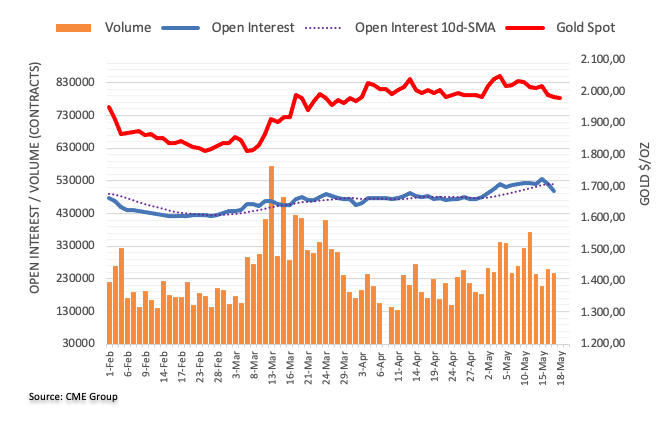
EUR/GBP has recently breached the 0.87 level, the lowest level since December 2022.
Range bound
“EUR/GBP is stuck between opposing forces. On the one hand, we expect relative rates and near-term broad EUR optimism to act as a tailwind for the cross. On the other hand, we see the global growth slowdown and the relative appeal of UK assets acts as a headwind.”
“At present, we do not see the relative growth outlook or global investment environment to create significant divergence between EUR and GBP. We thus expect the cross to remain range bound around 0.87-88.”
- WTI crude oil consolidates the biggest daily gains in two weeks around $72.50.
- Nearly overbought RSI, failure to remain firmer past $73.30 lures Oil bears.
- 100-SMA, resistance-turned-support and bullish MACD signals challenge WTI bears.
- 200-SMA appears the key upside hurdle, Oil bears need validation from $64.30.
WTI crude oil renews intraday low near $72.50 as it pares the biggest daily jump in a fortnight as the highest levels in three weeks amid early Thursday morning in Europe.
In doing so, the black gold traces the RSI (14) line’s retreat as it drops back to the 100-SMA level surrounding $72.35 at the latest. However, bullish MACD signals and the quote’s stability beyond the previous resistance line stretched from April 28, now immediate support near $71.60, challenge the Oil bears.
Following that, a quick fall towards the two-week-old ascending support line, near $70.30, and then towards the $70.00 round figure can’t be ruled out.
In a case where the WTI crude oil remains bearish past $70.00, the odds of witnessing a slump toward the double bottoms marked around $64.40-30 can’t be ruled out.
On the flip side, WTI’s recovery moves need to cross the latest peak of around $73.30 to recall the Oil buyers.
Even so, the 50% Fibonacci retracement level of its April-May fall, near $73.85, can’t be ruled out.
Though, a convergence of the 200-SMA and 61.8% Fibonacci retracement level of around $76.20-30 appears a tough nut to crack for Oil buyers.
WTI: Four-hour chart
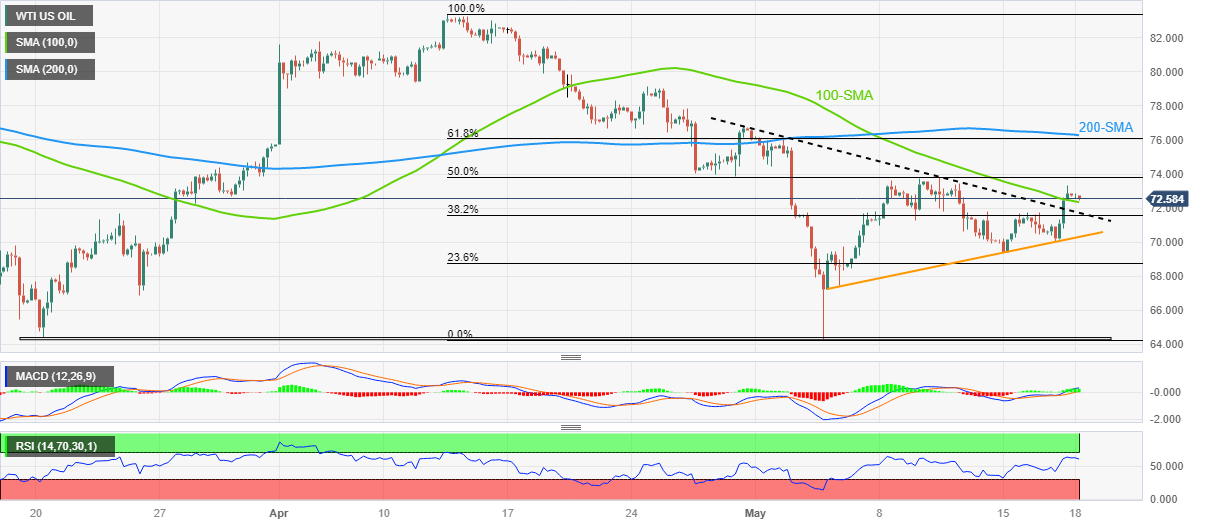
Trend: Further upside expected
- Gold price has shown a perpendicular downfall after retreating from $1,985.00 amid a solid recovery in the USD index.
- Plenty of US economic indicators are strengthening the need of pausing interest rates by the Fed.
- Gold price has shown a vertical fall after delivering a breakdown of the Rising Channel pattern.
Gold price (XAU/USD) has witnessed immense selling pressure after retreating from $1,985.00 in the early European session. The precious metal is expected to deliver more weakness on a slippage below the immediate support of $1,970.00 as soaring optimism for the US debt-ceiling raise approval is weighing heavily on bullions.
S&P500 futures have also sensed selling pressure after some recovery, portraying a rebound in the risk-aversion theme. The US Dollar Index (DXY) is all set to recapture the critical resistance of 103.00 on expectations that the US debt-ceiling raise proposal would get approval by compromising President’s spending initiatives.
House of Representatives Speaker Joseph McCarthy has got ready to hike the US borrowing cap over the compromise of further budget deficit as the duo could be a disaster for the US economy.
The US Dollar Index is managing to defend its downside despite higher anticipation for a pause in the policy-tightening spell by the Federal Reserve (Fed). According to a poll by Reuters current interest rate at 5.00-5.25% will stay by the end of 2023.
Right from consistent decline in United States inflation, easing labor market conditions to contracting retail demand and deepening fears of economic recession, plenty of economic indicators are strengthening the need of pausing interest rates.
Gold technical analysis
Gold price has shown a perpendicular fall after delivering a breakdown of the Rising Channel chart pattern formed on a four-hour scale. Potential supports are placed from April 19 and March 21 low at $1,969.26 and $1,935.68 respectively. Downward-sloping 20-period Exponential Moving Average (EMA) at $1,994.56 is barricading the Gold bulls.
The Relative Strength Index (RSI) (14) has slipped into the bearish range of 20.00-40.00, which indicates more downside ahead.
Gold four-hour chart
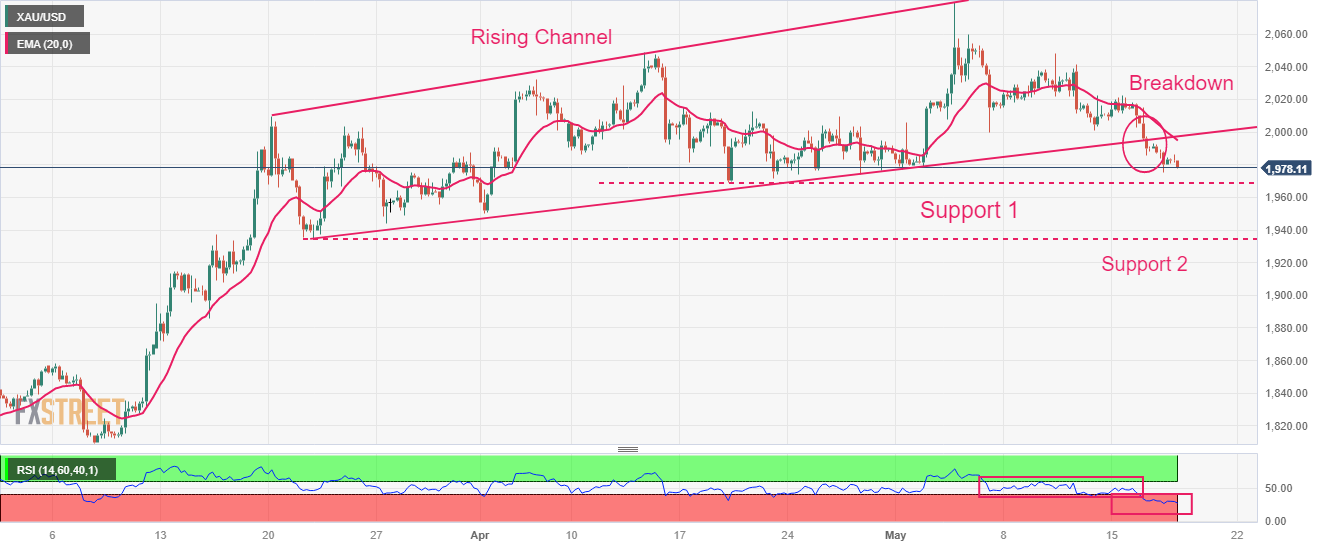
UOB Group’s Economist Lee Sue Ann and Markets Strategist Quek Ser Leang suggest EUR/USD could slip back to the 1.0800 region in the next weeks.
Key Quotes
24-hour view: “We highlighted yesterday that ‘the underlying tone has softened somewhat and EUR is likely to edge lower’. We added, ‘any decline is likely part of a lower range of 1.0835/1.0890’. While our view of a lower EUR was correct, it weakened more than expected as it dropped to a low of 1.0808 before recovering slightly to end the day at 1.0839 (-0.20%). Downward momentum has improved, albeit not much. Today, as long as EUR stays below 1.0870 (minor resistance is at 1.0855), it could test the major support at 1.0800 before stabilizing. The next support at 1.0750 is unlikely to come under threat.”
Next 1-3 weeks: “Three days ago (15 May, spot at 1.0850), we indicated that ‘the outlook for EUR remains negative and the level to watch is 1.0800’. Yesterday (17 May), EUR fell to a low of 1.0808. While downward momentum has not increased much, the risk for EUR remains on the downside. However, it has to break clearly below 1.0800 before further decline to 1.0750 is likely. On the upside, a breach of 1.0900 (‘strong resistance’ level was at 1.0935 yesterday) indicates that the weakness in EUR that started a week ago has stabilized.”
- Equities in Asia-Pacific zone grinds higher while tracing Wall Street’s moves, ignoring S&P500 futures.
- Stocks in Australia, New Zealand benefit from easing hawkish RBA bets and upbeat NZ budget.
- China’s trade news, hopes of no US default jostle with fears emanating from US retail giants to tame optimism.
- Risk catalysts are the key amid light calendar for the rest of the day.
Risk appetite remains firmer in Asia, tracking Western moves, as traders seem optimistic about the US debt ceiling extension. Adding strength to the risk-on mood could be the Aussie jobs report and New Zealand budget, as well as China trade news.
Amid these plays, MSCI’s index of Asia-Pacific shares ex-Japan rises 0.70% whereas Japan’s Nikkei 225 prints 1.60% intraday gains at the highest levels since late 2021.
Australia’s headline Employment Change marked a surprise figure of -4.3K in April versus 25K expected and 53K prior whereas the Unemployment Rate jumps to 3.7% from 3.5% prior. With this, the hawkish bias surrounding the Reserve Bank of Australia (RBA) fades and allows the Aussie shares to remain firmer. On the same line, New Zealand (NZ) reports a no-frills budget and propels the NZX50 by nearly 1.20% on a day at the latest.
Furthermore, China China’s ambassador to Australia, Xiao Qian, recently hints at resuming imports of Australian timber as talks are underway about a visit by Australian Prime Minister Anthony Albanese to Beijing, per the South China Morning Post (SCMP). With this, stocks in China, Hong Kong and Taiwan are all firmer.
It’s worth noting, however, that Indonesia’s IDX Composite bucks the bullish trend in the Asia-Pacific markets while Indian equities remain mildly bid by the press time.
On a broader front, comments from US President Joe Biden and House Speaker Kevin McCarthy managed to convince the markets that they can unite to avoid the ‘catastrophic’ default, which in turn underpinned the market’s risk-on mood. Even so, doubts about US President Joe Biden’s assurance to have a budget solution by Sunday’s end seem to prod the upbeat sentiment. Also poking the market’s upbeat mood are fears of easing US statistics as Reuters said that US retail sales have remained resilient despite higher prices but consumers have been careful about their spending, hurting companies such as Target and Home Depot, whose merchandise largely consists of discretionary products.
Against this backdrop, S&P500 Futures print mild losses despite the upbeat Wall Street close whereas the US Treasury bond yields remain sidelined at the multi-day top. That said, the US 10-year and two-year Treasury bond yields rose to the highest levels since May 01 and April 24 while portraying a four-day uptrend near 3.57% and 4.16% respectively, easing to 3.56% and 4.14% by the press time.
Also read: Forex Today: Dollar weakens amid risk appetite; eyes turn to Australian jobs data
FX option expiries for May 18 NY cut at 10:00 Eastern Time, via DTCC, can be found below.
- EUR/USD: EUR amounts
- 1.0775 591m
- 1.0805 2.5b
- 1.0860 879m
- 1.0900 1.4b
- 1.0935 570m
- 1.0945 1.4b
- USD/JPY: USD amounts
- 136.00-05 1.1b
- 137.00 442m
- 138.00 591m
- USD/CAD: USD amounts
- 1.3500 498m
- 1.3700 1.1b
- AUD/USD: AUD amounts
- 0.6500 500m
- 0.6665 371m
- 0.6680 331m
- 0.6700 496m
- 0.6715 447m
- 0.6750 706m
- USD/MXN has shifted its auction comfortable above 17.60 amid a recovery in the USD Index.
- A failure in the raise of US debt-ceiling could provide catastrophic effects on the US economy.
- Banxico is expected to keep the interest rate policy unchanged.
The USD/MXN pair has built a cushion around 17.60 as the US Dollar Index (DXY) has extended its upside further to near 102.96 in the early European session. The asset is expected to remain on the tenterhooks as investors are awaiting the announcement of the interest rate decision by the Bank of Mexico (Banxico).
A solid recovery of losses generated in Asia by the S&P500 futures is indicating further strengthening of the risk appetite of the market participants. The US Dollar Index (DXY) has recovered sharply and is looking to recapture the immediate resistance of 103.00. It seems that investors have ignored positive commentaries from US President Joe Biden and Republican Speaker Joseph McCarthy.
Republican House of Representatives McCarthy said that each member who attended negotiations associated with raising the US debt-ceiling limit cited the approval of a higher US borrowing cap and widening budget deficit as a disaster.
Investors should note that there is no alternative to approving the raise in the US debt-ceiling limit as a failure in the same could provide catastrophic effects for the United States economy. The US economy will be out of funds by June 01 and it would lead to the loss of millions of jobs and a sharp decline in Gross Domestic Product (GDP) numbers.
On the Mexican Peso front, investors are awaiting the release of the interest rate policy by Banxico. The majority of analysts surveyed by Bloomberg and Reuters expect a pause in the rate-hiking spell. This could put some pressure on the Peso, as a minority still seems to expect another rate hike.” Investors should note that Banxico’s current interest rates are at 11.25%.
- Natural Gas remains indecisive within fortnight-old bullish channel.
- 50-EMA, descending resistance line from mid-March restrict immediate XNG/USD moves.
- Gradually rising RSI line, recently upbeat MACD signals favor Natural Gas buyers.
Natural Gas Price (XNG/USD) treads water around $2.51 heading into Thursday’s European session. In doing so, the XNG/USD remains defensive between the 50-day Exponential Moving Average (EMA) and a two-month-long falling resistance line.
That said, the energy instrument portrays sluggish moves after it rose to the highest level since March 17 on Tuesday. However, the XNG/USD stays within a two-week-old ascending trend channel and hence keeps the Natural Gas buyers hopeful.
It’s worth noting that the recently firmer MACD signals join the gradually rising RSI (14) line, not overbought, to underpin the bullish bias surrounding the Natural Gas price.
As a result, the XNG/USD quote is likely to cross the immediate resistance line, around $2.52 by the press time, which in turn could help the bulls to prod the latest multi-day high of near $2.60.
Though, the aforementioned channel’s top line, close to $2.68 at the latest, may challenge the Natural Gas buyers afterward.
Meanwhile, pullback moves need validation from the 50-EMA support of near $2.48, a break of which could quickly drag the XNG/USD towards the stated channel’s bottom line surrounding $2.43.
In a case where the Natural Gas price remains weaker past $2.43, a quick fall to the early month top of $2.40 can’t be ruled out.
Overall, XNG/USD remains on the bull’s radar despite the latest inaction.
Natural Gas Price: Daily chart
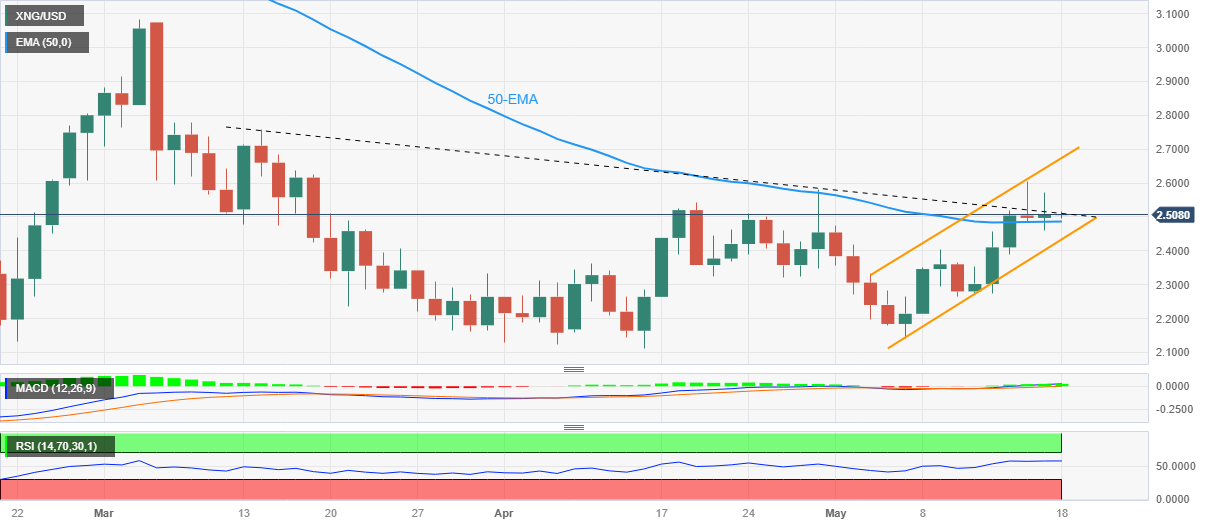
Trend: Further upside expected
China’s ambassador to Australia, Xiao Qian, said that China is on track to resume imports of Australian timber from Thursday and that talks are underway about a visit by Australian Prime Minister Anthony Albanese to Beijing, per the South China Morning Post (SCMP).
Key quotes
“[On Wednesday], the Chinese customs has formally notified the Australian minister of agriculture that starting from [Thursday] China will resume import of Australian timbers.”
“Discussions about a visit by Albanese were underway and he hoped it would happen “as early as possible”.
“The Chinese side, the Australian side we are keeping in touch with each other through diplomatic channels so we can find out the time that will be convenient for both sides.”
Australian timber imports to China have been largely suspended since late 2020 after Beijing said it had found pests in shipments.
Market reaction
AUD/USD is failing to find any inspiration from the upbeat news, trading 0.17% lower on the day at 0.6650, as of writing.
- AUD/USD has witnessed selling pressure after a recovery move to near 0.6650 as the USD Index has rebounded.
- The catastrophic impact of the US Treasury default could dampen the leadership position and the credibility of the United States economy.
- Cooling down Australian tight labor market conditions are expected to force the Reserve Bank of Australia (RBA) to return to an unchanged policy stance.
- AUD/USD’s upside is capped from April 03 high around 0.6793 while the downside is restricted from March 07 low around 0.6580.
AUD/USD has shown some selling pressure after a recovery move to near 0.6650 in the Asian session. The Aussie asset witnessed an extreme sell-off in early Asia after the release of the downbeat Australian Employment data. A sheer slowdown has been witnessed in Australian Employment generation as firms are facing pressure due to higher interest rates from the Reserve Bank of Australia (RBA).
S&P500 futures have recovered the majority of losses posted in early Asia, portraying a recovery in the risk appetite of the market participants. US equities were heavily bought on Wednesday after US President Joe Biden remained confident about the approval of raising the US debt-ceiling limit. Expectations for a US borrowing cap increase surged after House of Representatives Joseph McCarthy cited that the deal with the White House is doable.
The US Dollar Index (DXY) is making efforts for climbing above the immediate resistance of 102.90 despite receding fears of a catastrophic US default case. While the 10-year US Treasury yields have dropped sharply below 3.57%.
US debt-ceiling issues to resolve by the weekend
After fresh commentary from US President Joe Biden and House of Representatives Joseph McCarthy, one thing is clear the US debt-ceiling issue will get resolved as it could force US Treasury a default on obligated payments. The catastrophic impact of the US Treasury default could dampen the leadership position and the credibility of the United States economy.
However, the important fact out of commentaries is that the default deal is completely off the table. Each member attended US debt-ceiling negotiations and admitted that a raise in US debt-ceiling along with a higher budget deficit due to increased President’s spending initiatives cited it as a disaster. The USD Index would also get under pressure as plenty of US Dollars flush into the economy would trim its appeal firmly.
Downbeat Australian Employment supports steady Reserve Bank of Australia policy
The Australian Dollar was heavily beaten in early Asia after the Australian Bureau of Statistics came with downbeat Employment numbers. As per the report, the Australian labor market reported a decline in the number of payrolls by 4.3K while the street was anticipating an additional fresh 25K jobs. The Unemployment Rate jumped sharply to 3.7% vs. the consensus and the former release of 3.5%.
Cooling down tight labor market conditions is expected to force the Reserve Bank of Australia (RBA) to return to an unchanged policy stance. Investors should note that RBA Governor Philip Lowe surprisingly raised interest rates by 25 basis points (bps) to 3.85% in May monetary policy.
On Wednesday, the Australian agency reported stubborn Wage Price Index data. The labor cost data is expected to soften ahead as lower job openings would trim bargaining power in favor of job-seekers.
AUD/USD technical outlook
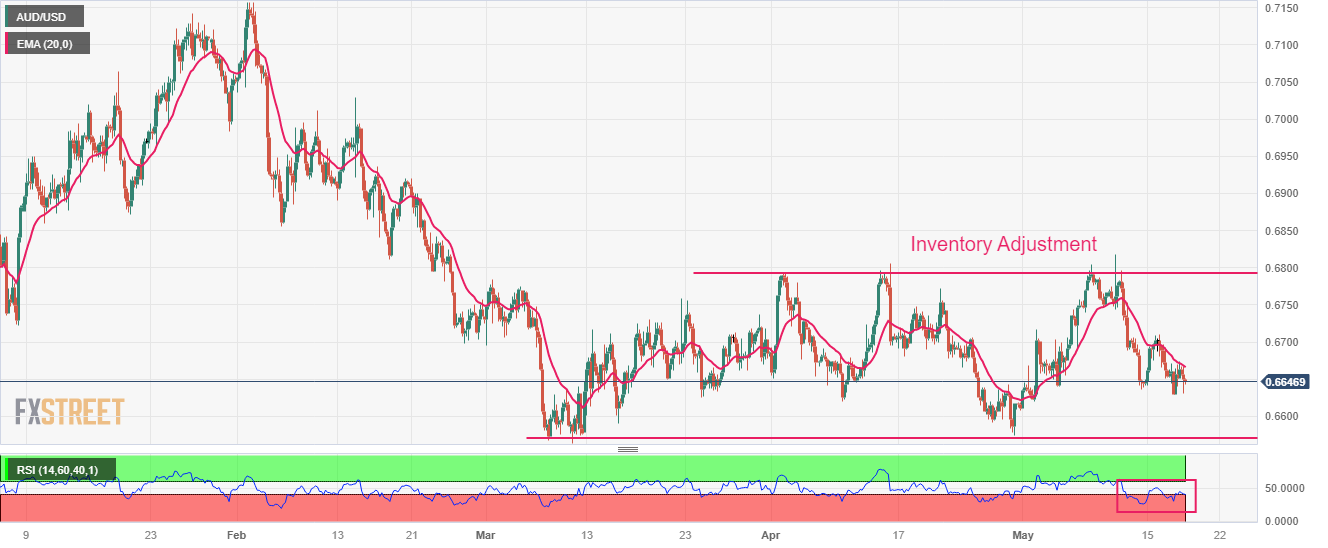
Scrutiny of AUD/USD’s four-hour scale indicates that the upside is capped from April 03 high around 0.6793 while the downside is restricted from March 07 low around 0.6580. The 20-period Exponential Moving Average (EMA) at 0.6666, indicating as a barricade for the Australian Dollar bulls.
A decisive breakdown of the Relative Strength Index (RSI) (14) into the 20.00-40.00 range will trigger the downside momentum.
- USD/CAD grinds near intraday high while paring weekly losses.
- Oil price retreats from weekly top after rising the most in a fortnight.
- Risk dwindles amid US debt ceiling concerns but US Dollar remains firmer.
- Second-tier US/Canada data, risk catalysts eyed for clear directions.
USD/CAD seesaws around the intraday top of near 1.3470-75 heading into Thursday’s European session. In doing so, the Loonie pair buyers cheer recently easy Oil price and the US Dollar’s sturdy moves at the multi-day high amid a sluggish performance of the market.
That said, the WTI crude Oil prints mild losses near $72.60 as it consolidates the biggest daily gains in two weeks amid slightly offbeat market conditions. Adding strength to the bearish bias surrounding the black gold is the US Dollar’s strength and expectations of slower energy demand, mainly due to softer China data and recession woes in the West.
With this, the US Dollar Index (DXY) buyers keep the reins at the highest levels in seven weeks, mildly bid near 102.90 by the press time.
It’s worth noting that the recent increase in the bullish bets surrounding the Fed’s 0.25% rate hike in June, around 20% at the latest versus previous expectations favoring no such actions in 2023, favor the US Dollar bulls. Also supporting the greenback buyers are comments from US President Joe Biden and House Speaker Kevin McCarthy managed to convince the markets that they can unite to avoid the ‘catastrophic’ default, which in turn underpinned the market’s risk-on mood and propelled the US Dollar.
Amid these plays, S&P500 Futures print mild losses despite the upbeat Wall Street close whereas the US Treasury bond yields remain sidelined at the multi-day top. That said, the US 10-year and two-year Treasury bond yields rose to the highest levels since May 01 and April 24 while portraying a four-day uptrend near 3.57% and 4.16% respectively, easing to 3.56% and 4.14% by the press time.
Looking forward, the weekly US Jobless Claims and Philadelphia Fed Manufacturing Survey will join the Canadian Employment Insurance Beneficiaries Change and New Housing Price Index to entertain intraday traders of the USD/CAD pair. Above all, risk catalysts are key for clear directions.
Technical analysis
USD/CAD rebound remains elusive unless crossing a three-week-old descending resistance line, around 1.3540 by the press time. That said, multiple bounces off the 200-day Exponential Moving Average (EMA), around 1.3400 by the press time, join bullish MACD signals to keep the Loonie pair buyers hopeful.
- EUR/USD fades bounce off six-week low as US Dollar grinds higher at nearly two-month top.
- Softer EU inflation, downbeat tone of ECB’s de Cos weigh on Euro price.
- Optimism surrounding US debt limit extension, recent increase in Fed bets supporting June rate hike favor US Dollar.
- Risk catalysts, ECB President Lagarde’s speech will be the key to watch for clear directions.
EUR/USD fades late Wednesday’s rebound from the lowest levels in six weeks as market sentiment dwindles heading into Thursday’s European session. Also exerting downside pressure on the Euro pair, down 0.05% intraday near 1.0840 by the press time, are the doubts about the European Central Bank’s (ECB) hawkish bias versus the recent pick-up in the odds favoring the Federal Reserve’s (Fed) rate hike in June.
As per the interest rate futures, market players have recently supported an increase in the Fed rate by 0.25% in June, with the 20% probabilities versus expectations favoring no such actions in 2023. The hawkish might have taken clues from the latest US statistics and the hawkish Fed talks.
US Housing Starts came out as unimpressive with 1.401M figures for April versus 1.4M expected and 1.371M prior (revised). Alternatively, the Building Permits for the said month eased to 1.416M from 1.437M edited previous readings and market forecasts. Before that, upbeat US Retail Sales and Industrial Production details for April allowed the Federal Reserve (Fed) officials to remain hawkish and prod the risk-on mood. The latest among them were Federal Reserve Bank of Chicago President Austan Goolsbee and Atlanta Fed President Raphael Bostic who reiterate inflation fears and favored the EUR/USD bears.
On the other hand, the final readings of the Eurozone inflation for April, per Harmonized Index of Consumer Prices (HICP), eased to 0.6% MoM versus 0.7% previous estimations while confirming a 7.0% YoY initially forecasted increase. following the inflation data, the European Central Bank (ECB) policymaker and Bank of Spain's Governor Pablo Hernandez de Cos said in an MNI interview on Wednesday, “The persistence of higher inflation would slow the recovery and would very likely lead to further tightening in the euro area.”
Apart from the Fed versus ECB play, comments from US President Joe Biden and House Speaker Kevin McCarthy managed to convince the markets that they can unite to avoid the ‘catastrophic’ default, which in turn underpinned the market’s risk-on mood and propelled the US Dollar. It should be noted that the US Dollar Index (DXY) buyers keep the reins at the highest levels in seven weeks, mildly bid near 102.90 by the press time.
It’s worth noting that anxiety ahead of today’s ECB President Christine Lagarde’s speech and US President Biden’s assurance to have a budget solution by Sunday’s end seem to prod the EUR/USD bears. While portraying the mood, S&P500 Futures print mild losses despite the upbeat Wall Street close whereas the US Treasury bond yields remain sidelined at the multi-day top. That said, the US 10-year and two-year Treasury bond yields rose to the highest levels since May 01 and April 24 while portraying a four-day uptrend near 3.57% and 4.16% respectively, easing to 3.56% and 4.14% by the press time.
Apart from ECB President Lagarde’s speech, the second-tier US data and talks about the US debt limit may also entertain EUR/USD traders.
Technical analysis
The downbeat RSI (14) conditions and the 100-DMA support of near 1.0800 triggered the Euro pair’s rebound on Wednesday. However, bearish MACD signals and the EUR/USD pair’s sustained trading below the 1.0900 resistance confluence, comprising a convergence of the 50-DMA and the support-turned-resistance line stretched from September 2022, keep the bears hopeful.
- USD/INR has faced stiff barricades above 82.50 as market sentiment has improved.
- The Indian Rupee is expected to remain under pressure as oil prices have recovered sharply.
- USD/INR is marching towards the downward-sloping trendline of the Symmetrical Triangle pattern plotted from 83.43.
The USD/INR pair has sensed some selling pressure around 82.40 in the Asian session. The asset has faced barricades as the US Dollar Index (DXY) has remained subdued in Tokyo. A lackluster performance is anticipated from the USD Index as expectations for the approval of the US debt-ceiling raise have improved sharply.
The Indian Rupee is expected to remain under pressure as oil prices have recovered sharply on optimism over solid demand recovery and the US meeting payment obligations before the deadline of June 01. It is worth noting that India is one of the leading importers of oil in the world higher oil prices will impact the Indian rupee.
USD/INR is marching towards the downward-sloping trendline of the Symmetrical Triangle chart pattern plotted from 19 October 2022 high at 83.43. The upward-sloping trendline of the aforementioned pattern is placed from 11 November 2022 low at 80.38.
The 50-period Exponential Moving Average (EMA) at 82.10 is supporting the US Dollar bulls.
A breach into the bullish range of 60.00-80.00 by the Relative Strength Index (RSI) (14) will strengthen US Dollar bulls further.
Going forward, a decisive break above March 22 high around 82.90 will drive the asset toward 23 December 2022 high at 83.17 followed by 19 October 2022 high at 83.43.
On the flip side, a downside move below May 16 low at 82.16 will drag the asset toward the round-level support at 82.00. A slippage below the latter will expose the asset to May 08 high at 81.67.
USD/INR daily chart
- GBP/USD is showing a lacklustre performance below 1.2500 amid the absence of a critical trigger.
- Market sentiment is positive as fears of catastrophic US default have trimmed sharply.
- UK Hunt’s promise of bringing down higher taxes to reduce pressure of higher inflation households could induce retail demand.
The GBP/USD pair is displaying a back-and-forth action below the psychological resistance of 1.2500 in the Tokyo session. The Cable is failing to deliver decisive action amid the absence of critical triggers. The USD Index is making efforts for defending its downside near 1.2480, however, the downside seems favoured as the White House has agreed to raise US borrowing cap as the cost of the President’s spending initiatives.
S&P500 futures are showing nominal losses in Asia after a bullish Wednesday. Market sentiment is positive as fears of catastrophic US default have trimmed sharply. The US Dollar Index (DXY) is juggling in a narrow range around 102.81. A further positive development for the approval of the US debt-ceiling raise would weigh more pressure on the USD Index as a higher flush of US Dollars in the economy would trim its appeal.
Also, rising expectations for a pause in the interest rate-hiking spell by the Federal Reserve (Fed) are exerting pressure on the USD index. However, the current interest rate at 5.00-5.25% will stay by the end of 2023, according to a poll by Reuters.
Meanwhile, Bank of England (BoE) policymakers are still under pressure of bringing down the stubborn United Kingdom’s inflation. BoE Governor Andre Bailey cited on Wednesday that the tightness in the UK labour market is easing at a slower pace than we expected in February. This would leak out some heat from the current UK’s double-digit inflation.
Contrary to that, UK Finance Minister Jeremy Hunt’s promise of bringing down higher taxes to reduce the pressure of higher inflation households could induce retail demand.
- USD/JPY prints the first daily loss in six around two-week high.
- Nearly overbought RSI conditions, key resistance line challenge Yen pair buyers.
- 200-DMA restricts immediate downside amid bullish MACD signals.
USD/JPY bulls take a breather around 137.50, the highest level in a fortnight, as market sentiment dwindles during early Thursday in Europe. In doing so, the Yen pair prints the first daily loss in six while easing from the downward-sloping resistance line from December 2022.
Not only the sluggish markets and the Yen pair’s inability to cross the key resistance line but the nearly overbought RSI (14) line also favors the quote’s latest pullback.
However, the 200-DMA puts a floor under the USD/JPY prices around the 137.00 round figure.
Following that, the 38.2% Fibonacci retracement level of the Yen pair’s fall from October 2022 to January 2023, near 136.65, may challenge the sellers.
In a case where the USD/JPY remains bearish past 136.65, an upward-sloping support line from March 24 and the 50-DMA, respectively near 134.50 and 133.80, will be in the spotlight.
On the contrary, the USD/JPY pair’s daily closing beyond the aforementioned resistance line, around 137.80 by the press time, needs validation from the 138.00 round figure and late 2022 peak of around 138.20.
Should the Yen pair buyers keep the reins above 138.20, the odds of witnessing a rally toward the 140.00 psychological magnet can’t be ruled out.
Overall, USD/JPY is likely to witness further pullback but the trend remains bullish.
USD/JPY: Daily chart

Trend: Bullish
- Gold price prints corrective bounce from three-week low to snap two-day losing streak.
- Retreat in yields, market’s cautious mood allows XAU/USD to lick its wounds.
- US Dollar’s struggle with 100-DMA amid Target Corp-linked markets fears prod Gold sellers.
- Convergence of 50-HMA, previous support line limited immediate upside with eyes on US debt limit, Fed news.
Gold price (XAU/USD) clings to mild gains around $1,985 as it licks its wounds near the lowest levels in three weeks, snapping a two-day downtrend amid early Thursday in Europe. In doing so, the yellow metal benefits from the US Dollar’s struggle to extend the latest run-up at the multi-day top amid mixed sentiment surrounding the default conditions and fears of easing retail sales in the US.
That said, US President Joe Biden and House Speaker Kevin McCarthy managed to convince the markets that they can unite to avoid the ‘catastrophic’ default, which in turn underpinned the market’s risk-on mood and propelled the US Dollar. The greenback’s run-up also took clues from mostly upbeat US data and hawkish Fed talks.
However, the cautious mood due to the nearness to the US debt ceiling expiry of early June and doubts about the US diplomats’ ability to strike a deal on multiple issues that can help solve the debt-limit problem seem to weigh on the sentiment and the US Dollar.
On the same line are fears of easing US statistics as Reuters said that US retail sales have remained resilient despite higher prices but consumers have been careful about their spending, hurting companies such as Target and Home Depot, whose merchandise largely consists of discretionary products. The same joins the Fed’s dovish hike to prod the US Dollar bulls.
Amid these plays, US Dollar Index (DXY) buyers struggle to keep the reins at the highest levels in seven weeks, sluggish near 102.85-80 by the press time. Elsewhere, S&P500 Futures print mild losses despite the upbeat Wall Street close whereas the US Treasury bond yields remain sidelined at the multi-day top. That said, the US 10-year and two-year Treasury bond yields rose to the highest levels since May 01 and April 24 while portraying a four-day uptrend near 3.57% and 4.16% respectively, easing to 3.55% and 4.13% by the press time.
Moving ahead, a lack of major data/events may allow the Gold price to cover but the risk catalysts are the key to watch for clear directions.
Gold price technical analysis
Although the oversold RSI (14) line allowed the Gold price to recover from a three-week low, backed by the bullish MACD signals, a convergence of the 50-Hour Moving Average (HMA) and the support-turned-resistance line from April 27, close to $1,995 by the press time, appears a tough nut to crack for the bulls.
Even if the XAU/USD manages to rise past $1,995, the $2,000 psychological magnet and the previous resistance line from May 03, close to $2,010 at the latest, could challenge the Gold buyers.
Meanwhile, the Gold Price pullback remains elusive unless it breaks the three-week-old horizontal support area surrounding $1,975-74.
It’s worth mentioning that the mid-April low of near $1,969 and the previous monthly bottom of around $1,950 are some extra filters toward the south.
To sum up, the Gold price recovery remains unimpressive below $2,010.
Gold price: Hourly chart

Trend: Pullback expected
| Raw materials | Closed | Change, % |
|---|---|---|
| Silver | 23.744 | 0.04 |
| Gold | 1981.86 | -0.32 |
| Palladium | 1480.82 | -0.08 |
- NZD/USD picks up bids to pare intraday losses, sluggish of late.
- New Zealand Treasury expects no recession, delays budget surplus by one year.
- US Dollar grinds higher amid cautious optimism surrounding US default.
- Light calendar restricts immediate Kiwi pair moves, may allow consolidation of weekly gains.
NZD/USD struggles to cheer New Zealand’s (NZ) no-frills budget as it stays defensive near 0.6250 during early Thursday, despite recently bouncing off intraday low. The reason could be linked to the US Dollar’s latest grinding towards the north, after refreshing the multi-day high the previous day.
New Zealand Treasury expects the economy to avoid recession while also anticipating a return to budget surplus delayed one year to 2026. While announcing the annual budget, NZ Finance Minister Grant Robertson also said, “Recent widening of current account deficit expected to reverse.”
Also read:
On the other hand, US Dollar Index (DXY) buyers struggle to keep the reins at the highest levels in seven weeks, sluggish near 102.85-80 by the press time. The US Dollar’s latest inaction could be linked to the cautious mood due to the nearness to the US debt ceiling expiry of early June and doubts about the US policymakers’ ability to strike a deal on multiple issues that can help solve the debt-limit problem.
However, the US policymakers’ ability to convince the markets that they can avoid the ‘catastrophic’ default joined upbeat US data and hawkish Fed talks to favor the US Dollar of late.
On Wednesday, US House Speaker Kevin McCarthy said in an interview on CNBC, "Now we have an opportunity to find common ground but only a few days to get the job done." Further, US President Joe Biden said that he is confident that they will be able to reach a budget agreement and noted that it would be catastrophic if the US failed to pay bills, per Reuters. "Will have a news conference on Sunday on the debt issue,” added US President Joe Biden.
Talking about the data, US Housing Starts came out as unimpressive with 1.401M figures for April versus 1.4M expected and 1.371M prior (revised). Alternatively, the Building Permits for the said month eased to 1.416M from 1.437M edited previous readings and market forecasts. Before that, upbeat US Retail Sales and Industrial Production details for April allowed the Federal Reserve (Fed) officials to remain hawkish and prod the risk-on mood. The latest among them were Federal Reserve Bank of Chicago President Austan Goolsbee and Atlanta Fed President Raphael Bostic who reiterate inflation fears and favored the NZD/USD bears.
At home, New Zealand’s first quarter (Q1) Producer Price Index Input and Output numbers ease to 0.2% and 0.3% respectively versus 0.5% and 0.9% priors in that order. It’s worth noting that these figures are way below the market forecasts of 1.5% and 1.3% for Input and Output respectively.
Against this backdrop, S&P 500 Futures print mild losses despite the upbeat Wall Street close whereas the US Treasury bond yields remain sidelined at the multi-day top. That said, the US 10-year and two-year Treasury bond yields rose to the highest levels since May 01 and April 24 while portraying a four-day uptrend near 3.57% and 4.16% respectively, easing to 3.55% and 4.13% by the press time.
Looking ahead, risk catalysts will be key to watch amid a light calendar.
Technical analysis
NZD/USD remains sidelined between the 100-DMA and 50-DMA, respectively near 0.6275 and 0.6230, amid downbeat oscillators.
New Zealand Finance Minister said while presenting the country’s Budget on Thursday, “the Treasury is no longer forecasting the country to move into recession.”
Additional takeaways
NZ sees 2023/24 GDP 1.0% (HYEFU -0.3%).
NZ unemployment rate seen at 5.0% in 2023/24 (HYEFU 5.5%).
NZ sees 2022/23 operating balance before gains, losses nz$-6.96 bln (HYEFU NZ$-3.63 bln).
NZ sees 2022/23 net debt 38.5% of GDP under old calculation method (HYEFU 39.2%).
NZ sees 2022/23 cash balance NZ$-22.43 bln (HYEFU NZ$-25.36 bln).
NZ Treasury is no longer forecasting the country to move into recession.
NZ government forecast to return to surplus in 2025-26, one year later than previous forecast.
Operating package slightly higher due to impact of weather events.
Recent widening of current account deficit expected to reverse.
Market reaction
At the time of writing, NZD/USD is holding lower ground, erasing gains to trade neutral at 0.6246.
- AUD/NZD flirts with weekly low as bears prod five-month-old ascending trend line.
- Australia Employment Change slumps, Unemployment Rate rise in April while NZ budget appears optimistic.
- Downbeat oscillators, failure to cross key DMAs favor AUD/NZD sellers.
- Six-week-old ascending support line, New Zealand budget may prod the bears.
AUD/NZD takes offers to refresh a one-week low around 1.0630 as it bears the burden of the downbeat Australian employment report and optimistic New Zealand annual budget release on early Thursday.
Australia’s headline Employment Change marked a surprise figure of -4.3K in April versus 25K expected and 53K prior whereas the Unemployment Rate jumps to 3.7% from 3.5% prior.
New Zealand Treasury expects economy to avoid recession while also anticipating return to budget surplus delayed one year to 2026.
Technically, bearish MACD signals and the AUD/NZD pair’s repeated failures to cross the 21-DMA and 50-DMA, currently marking a convergence around 1.0735, keep the AUD/NZD bears hopeful.
However, an upward-sloping trend line from early April, close to 1.0600 by the press time, and the below-50 RSI (14) line challenge the pair sellers.
Alternatively, recovery moves may aim for the multiple lows marked during the mid-March around 1.0680. Though, the aforementioned DMA confluence near 1.0735 appears a tough nut to crack for the AUD/NZD buyers afterward.
Even if the AUD/NZD pair manages to cross the 1.0735 hurdle, the weekly high of 1.0765 and the monthly peak surrounding 1.0835 may check the bulls before directing them to a downward-sloping resistance line from February 20, around 1.0865 as we write.
Overall, AUD/NZD bears are likely to keep the reins even if a short-term support line restricts downside.
AUD/NZD: Daily chart
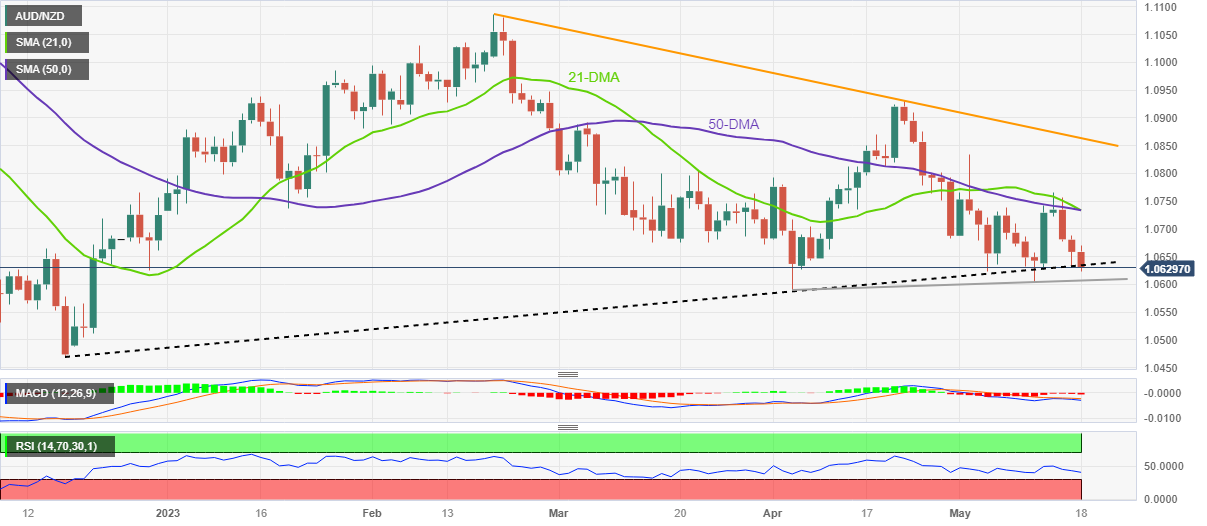
Trend: Limited downside expected
- USD/CAD bulls are on the approach to the 1.3470s.
- A break of 1.3480 would potentially pull in further demand.
The Canadian Dollar strengthened against its US counterpart on Wednesday as risk appetite rose and investors raised bets on another interest rate hike by the Bank of Canada. However, there are bullish tendencies on the charts as the following analysis will illustrate:
USD/CAD daily charts
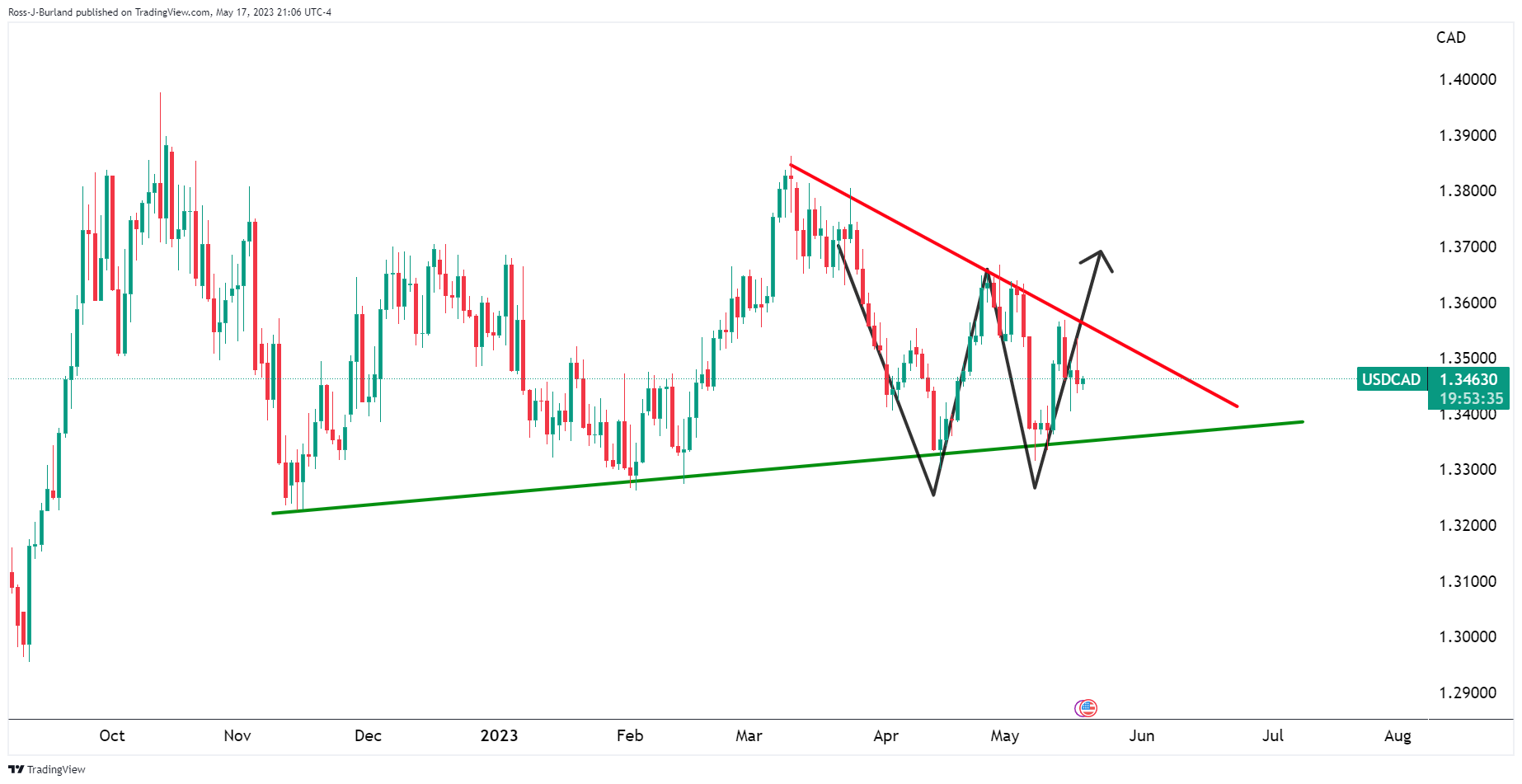
Firstly, the double bottom is a bullish scenario on the daily chart. While the market is coiling and the breakout of the triangle could go either way, there appears to be support as follows:

The correction of the prior bullish impulse into the 50% mean reversion area is decelerating and could lead to a bullish continuation.
USD/CAD H4 chart, the bullish scenario

On the 4-hour chart, we see that the price is on the approach to the 1.3470s and a break of 1.3480 would potentially pull in further demand.
- AUD/USD has witnessed a sharp decline to near 0.6630 as Australian Unemployment Jumped to 3.7%.
- The Australian labor market has recorded a decline in the number of payrolls by 4.3K in April vs. addition of 25K as estimated.
- Investors are anticipating a steady interest rate policy by the Fed in its June monetary policy meeting.
The AUD/USD pair as the Australian Bureau of Statistics has reported Employment (April) data. In April, the Australian labor market recorded a decline in the number of payrolls by 4.3K while the street was anticipating fresh additions of 25K jobs. The Unemployment Rate has jumped sharply to 3.7% vs. the consensus and the former release of 3.5%.
On Wednesday, the Australian Bureau of Statistics came with Q1 Wage Price Index data. The quarterly labor cost index remained steady at 0.8% but lower than the estimate of 0.9%. On an annual basis, the economic data accelerated to 3.7% vs. the consensus of 3.6% and the former release of 3.3%.
As the Australian labor market is releasing heat significantly, the Reserve Bank of Australia (RBA) might consider a pause in further rate hikes in June.
Meanwhile, S&P500 futures have witnessed some correction in early Asia after a significantly bullish Wednesday settlement. The overall market mood is quite cheerful as the deal of raising the US debt ceiling by the weekend seems promising. US President Joe Biden and other Democratic leaders have admitted that a raise in US borrowing cap and spending initiatives would be a disaster. Therefore, the proposal of default is off the table.
The US Dollar Index (DXY) has sensed selling pressure near 102.90 after a less-confident pullback as investors are anticipating a steady interest rate policy by the Federal Reserve (Fed) in its June monetary policy meeting.
- AUD/JPY remains pressured around intraday low after easing from eight-day top.
- Australia employment report, Japan trade numbers for April prod the cross-currency pair buyers.
- Qualitative catalysts will be the key for direction due to pair’s risk-barometer status, light calendar.
AUD/JPY takes offers to refresh intraday low near 91.20 while marking a nearly 50 pips of quick fall on the downbeat Aussie jobs report for April on early Thursday. Also weighing on the cross-currency pair are the downbeat yield and cautious mood in the market.
Australia’s headline Employment Change marked a surprise figure of -4.3K in April versus 25K expected and 53K prior whereas the Unemployment Rate jumps to 3.7% from 3.5% prior.
Also read: Breaking: Aussie Employment, -4.3K, below expectations (25K) in April
Earlier in the day, Japan’s Merchandise Trade Balance Total improved to ¥-432.4B for April versus ¥-613.8B expected and ¥-755.1B prior. However, the Imports and Exports for the said month eased to -2.3% and 2.6% YoY compared to -0.3% and 3.0% market forecasts, as well as 7.3% and 4.3% priors in that order.
On Wednesday, Australia’s Wage Price Index repeated 0.8% QoQ figures for the first quarter (Q1) of 2023, below the 0.9% market consensus, whereas the YoY numbers improved to 3.7% versus 3.6% expected and 3.3% previous readings. On the other hand, Japanese economic growth came in as 0.4% versus 0.1% expected and 0.0% prior, per the preliminary reading of the first quarter (Q1) 2023 Gross Domestic Product (GDP) figures.
It should be noted that the market’s risk-on mood, mainly inspired by the receding fears of the US default seemed to have fuelled the AUD/JPY run-up the previous day. Additionally, hopes of more investment from China also underpinned the cross-currency pair’s recovery as the state planner National Development and Reform Commission of the People's Republic of China (NDRC) mentioned on Wednesday that it'll take measures to unleash consumption potential and to make continuous efforts in stabilizing and expanding manufacturing investment.
However, a lack of incentive for further upside, as well as a cautious mood ahead of the key Aussie data and doubts on the Reserve Bank of Australia’s (RBA) hawkish bias, recently allowed the risk-barometer pair to consolidate the weekly gains.
Amid these plays, S&P 500 Futures print mild losses despite the upbeat Wall Street close whereas the US Treasury bond yields remain sidelined at the multi-day top. That said, the US 10-year and two-year Treasury bond yields rose to the highest levels since May 01 and April 24 while portraying a four-day uptrend near 3.57% and 4.16% respectively, easing to 3.55% and 4.13% by the press time.
Moving on, a light calendar might help the AUD/JPY to consolidate recent gains if the market sentiment deteriorates further.
Technical analysis
AUD/JPY retreat appears elusive unless the pair trades successfully below a one-week-old ascending support line, close to 90.55 by the press time. Meanwhile, the 50-DMA restricts immediate upside around the 92.00 round figure. Overall, MACD and RSI (14) conditions suggest further grinding of prices toward the north.
The Australian Employment report has been released as follows:
- Australia Employment Change s.a. came in at -4.3K, below expectations (25K) in April.
- Australia Unemployment Rate s.a. above expectations (3.5%) in April: Actual (3.7%).
- Australia Participation Rate in line with expectations (66.7%) in April.
- Australia Part-Time Employment: 22.8K (April) vs -19.2K.
- Australia Full-Time Employment down to -27.1K in April from previous 72.2K.
´´Australia Employment Unexpectedly dipped in April, following two months of outsized gains, while the jobless rate also ticked up, in a sign that the red-hot labour market might be cooling,´´ Reuters reported, adding:
´´Figures from the Australian Bureau of Statistics showed net employment fell 4,300 in April from March, when they rebounded by a revised 61,100. Market forecasts had been for a rise of 25,000.´´
This goes into the hands of the doves at the Reserve Bank of Australia and is a weight on AUD-USD as follows:
AUD/USD update
AUD/SD has dropped heavily on the release as follows:
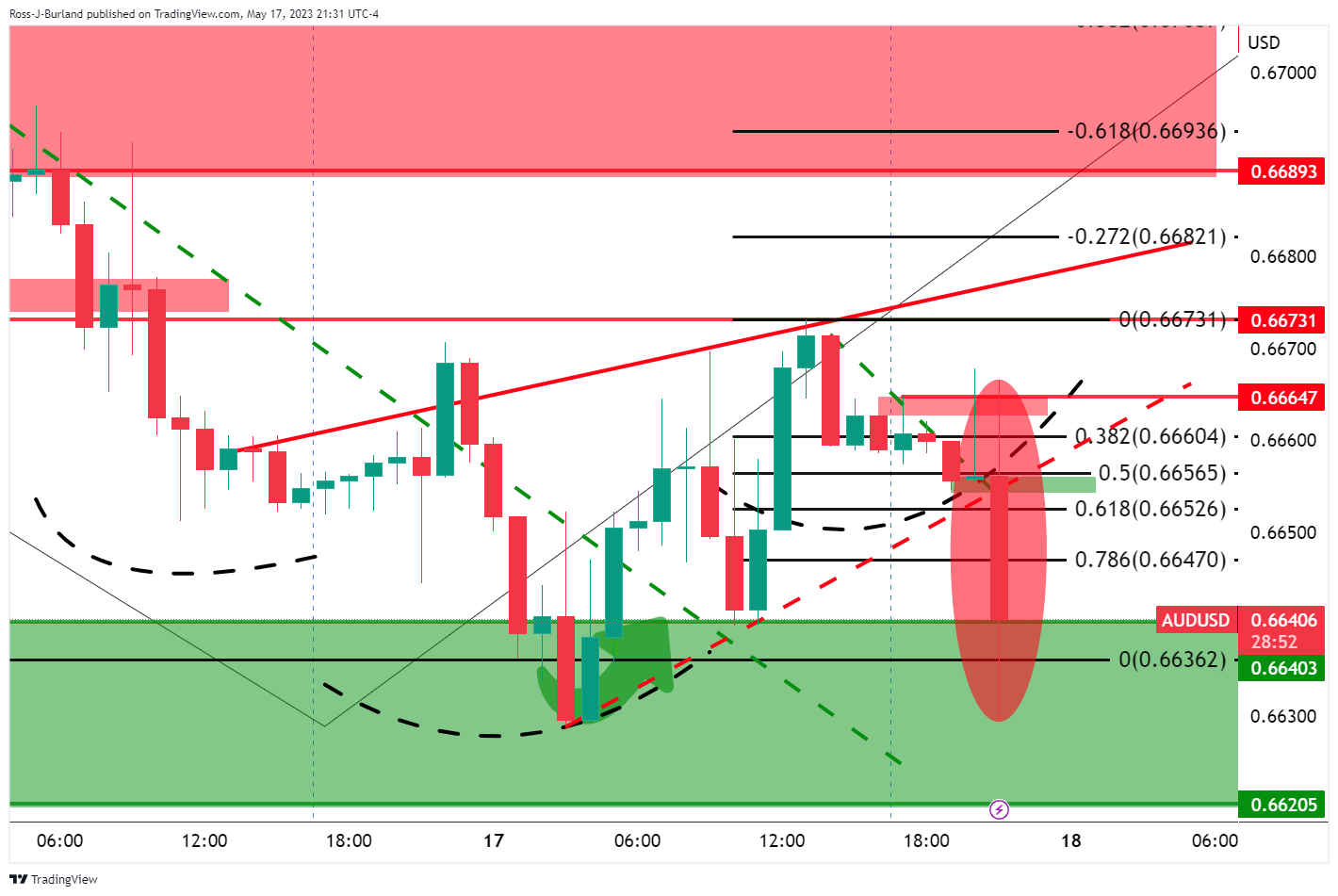
The data has nullified the bullish bias that had otherwise started to form on the charts:
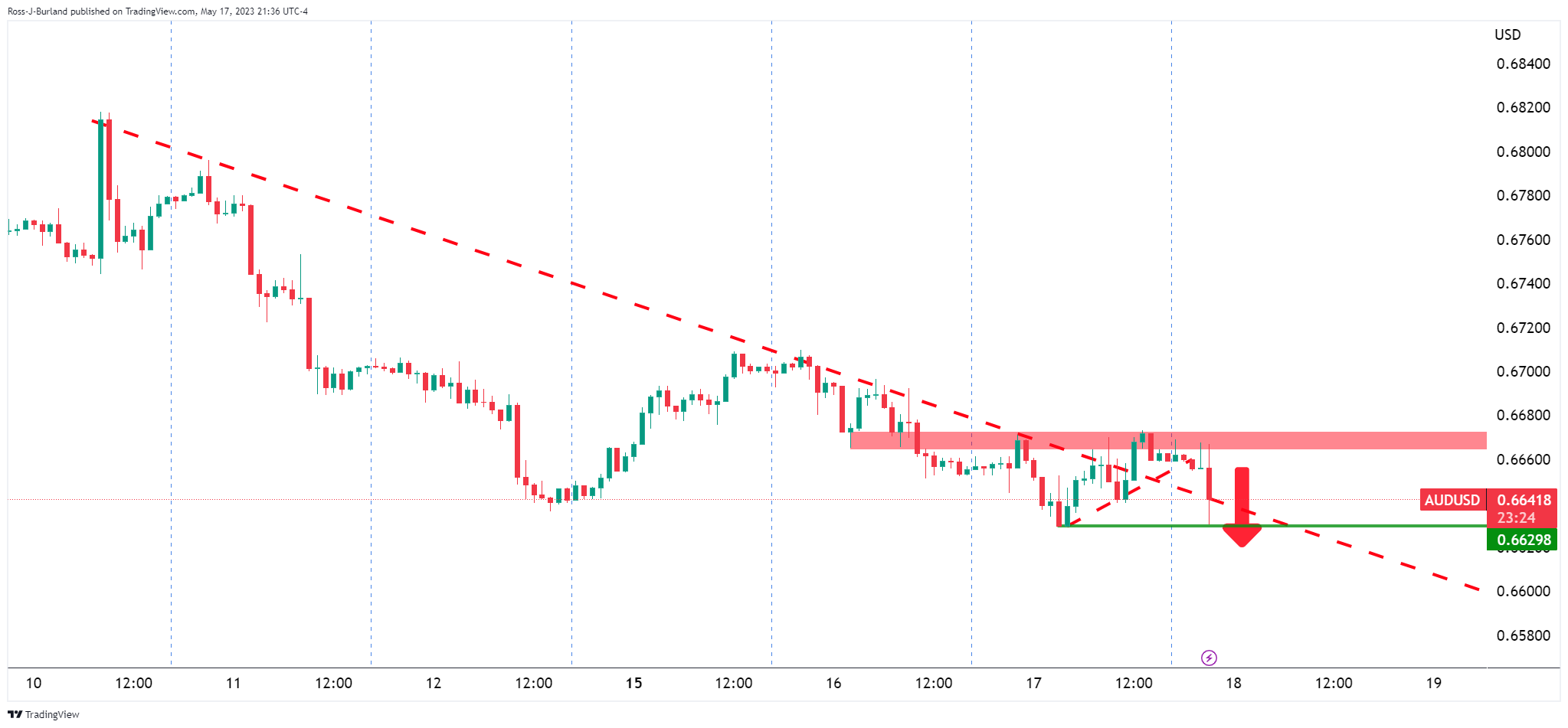
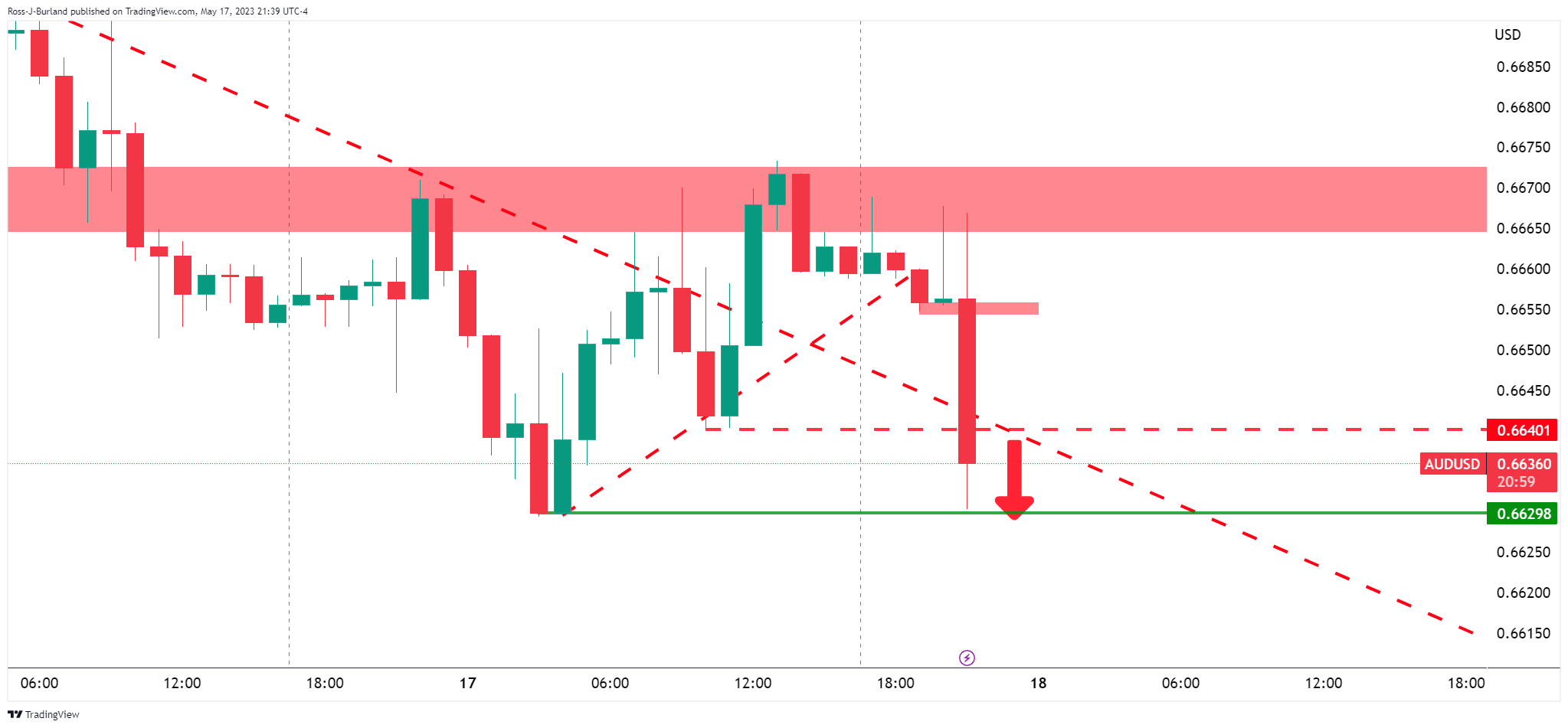
As illustrated, the price is now coming back inside of the bearish trend and a break of the 0.6620s could be on the cards.
About Aussie Employment Change
The Employment Change released by the Australian Bureau of Statistics is a measure of the change in the number of employed people in Australia. Generally speaking, a rise in this indicator has positive implications for consumer spending which stimulates economic growth. Therefore, a high reading is seen as positive (or bullish) for the AUD, while a low reading is seen as negative (or bearish).
In recent trade today, the People’s Bank of China (PBOC) set the yuan at 6.9967 vs. the last close of 6.9944 and vs. the estimate at 6.9985.
About the fix
China maintains strict control of the yuan’s rate on the mainland.
The onshore yuan (CNY) differs from the offshore one (CNH) in trading restrictions, this last one is not as tightly controlled.
Each morning, the People’s Bank of China (PBOC) sets a so-called daily midpoint fix, based on the yuan’s previous day's closing level and quotations taken from the inter-bank dealer.
- USD/CHF remains sidelined near five-week top, prods two-day uptrend.
- Sluggish markets allow Swiss Franc traders to recheck previous moves.
- Hopes of no US default allow buyers to keep the reins.
- Second-tier US data, risk catalysts can provide fresh impulse.
USD/CHF remains steady around 0.8980-85 as bulls take a breather amid early Thursday’s sluggish session, after refreshing the monthly high. In doing so, the Swiss Franc (CHF) pair portrays the market’s indecision amid a light calendar and lack of macros as the US default looms. However, the latest optimism about the debt limit extension puts a floor under the prices.
That said, the US policymakers’ ability to convince the markets that they can avoid the ‘catastrophic’ default favored the US Dollar of late, backed by upbeat comments from US President Joe Biden and House Speaker Kevin McCarthy.
On Wednesday, US House Speaker Kevin McCarthy said in an interview on CNBC, "Now we have an opportunity to find common ground but only a few days to get the job done." Further, US President Joe Biden said that he is confident that they will be able to reach a budget agreement and noted that it would be catastrophic if the US failed to pay bills, per Reuters. "Will have a news conference on Sunday on the debt issue,” added US President Joe Biden.
Even so, the cautious mood due to the nearness to the US debt ceiling expiry of early June and doubts about the US policymakers’ ability to strike a deal on multiple issues that can help solve the debt-limit problem prod the USD/CHF bulls.
Additionally, fears of easing US retail sales also weigh on the pair prices. On Wednesday, Reuters said that US retail sales have remained resilient despite higher prices but consumers have been careful about their spending, hurting companies such as Target and Home Depot, whose merchandise largely consists of discretionary products.
However, upbeat US data allowed the Federal Reserve (Fed) officials to reconfirm their hawkish bias about the monetary policy and hence keeps the USD/CHF buyers hopeful. On Wednesday, US Housing Starts came out as unimpressive with 1.401M figures for April versus 1.4M expected and 1.371M prior (revised). Alternatively, the Building Permits for the said month eased to 1.416M from 1.437M edited previous readings and market forecasts. Before that, upbeat US Retail Sales and Industrial Production details for April allowed the Federal Reserve (Fed) officials to remain hawkish and prod the risk-on mood. The latest among them were Federal Reserve Bank of Chicago President Austan Goolsbee and Atlanta Fed President Raphael Bostic who reiterate inflation fears and favored the USD/CHF bulls.
While portraying the mood, S&P 500 Futures print mild losses despite the upbeat Wall Street close whereas the US Treasury bond yields remain sidelined at the multi-day top.
Looking ahead, the USD/CHF may witness hardships in extending the latest run-up amid a light calendar and lack of statements to extend the previous optimism surrounding the US debt ceiling.
Technical analysis
USD/CHF pair’s failure to provide a daily closing beyond a one-month-old descending resistance line, around 0.8980 by the press time, teases USD/CHF sellers to aim for the 21-DMA support of 0.8925. That said, the 50-DMA surrounding 0.9040 acts as an extra filter towards the north.
- EUR/USD has shown recovery above 1.0840 amid expectations of a decline in Fed-ECB policy divergence.
- The Fed is expected to hold rates steady in June as tight credit conditions are effectively weighing on US inflation.
- ECB Lagarde has already made clear that more than one interest rate hike is appropriate.
The EUR/USD pair has shown some recovery from the immediate support of 1.0835 in the Asian session. The major currency pair is expected to accelerate further as the US Dollar Index (DXY) has retreated after failing to extend its short-lived pullback above 102.90.
S&P500 futures have recorded nominal losses in the Asian session, portraying a minor caution in the overall risk-on market mood. US equities witnessed significant buying interest on Wednesday after US President Joe Biden remained confident that the US debt-ceiling will be raised. However, the approval is coming with a compromise of the higher budget deficit.
The US Dollar Index (DXY) has faced selling pressure while attempting to recapture the 103.00 resistance as the Federal Reserve (Fed) is expected to hold interest rates steady in June as tight credit conditions are effectively weighing on United States inflation.
Investors are underpinning Euro against the US Dollar in anticipation that the continuation of interest rate hikes by the European Central Bank (ECB) and a pause in the policy tightening spell by the Fed will narrow the Fed-ECB policy divergence ahead.
ECB President Christine Lagarde has already made clear that more than one interest rate hike is appropriate in the battle against stubborn Eurozone inflation.
Economists at Commerzbank still expect a solid EUR/USD performance this year. They added “Our ECB watchers continue to expect the ECB to resist rate cuts next year. As long as this is the case, while the Fed is cutting, it still seems plausible to us to bet on well-supported EUR/USD levels towards the end of the year.”
- GBP/USD takes offers to refresh intraday low, fades the previous day’s corrective bounce off three-week low.
- Convergence of 200-SMA, one-week-old descending trend line guards Sterling Pound’s immediate upside.
- One-month-old rising support line can prod the Cable pair sellers.
GBP/USD prints three-day downtrend despite positing mild losses around 1.2480 during early Thursday, fading the previous day’s bounce off a three-week low.
In doing so, the Pound Sterling takes a U-turn from the convergence of the 200-SMA and a downward-sloping resistance line from May 10, close to 1.2490 at the latest. Adding strength to the pullback moves are the steady RSI (14) line and sluggish MACD signals.
As a result, the Cable pair appears all set to drop towards the 61.8% Fibonacci retracement level of its April-May upside, near 1.2430. However, a one-month-old ascending support line, close to 1.2425 by the press time, appears a tough nut to crack for the GBP/USD bears afterward.
In a case where the GBP/USD price drops below 1.2425, the odds of witnessing a quick fall toward a five-week-old horizontal support zone near 1.2355-45 can’t be ruled out.
On the flip side, the GBP/USD pair’s recovery needs to provide a successful break of the 1.2490 resistance confluence to convince buyers.
Following that, the tops marked during mid-April and 23.6% Fibonacci retracement, respectively near 1.2545 and 1.2585, may challenge the Cable pair buyers before directing them to the recently marked multi-day peak of 1.2680.
GBP/USD: Four-hour chart
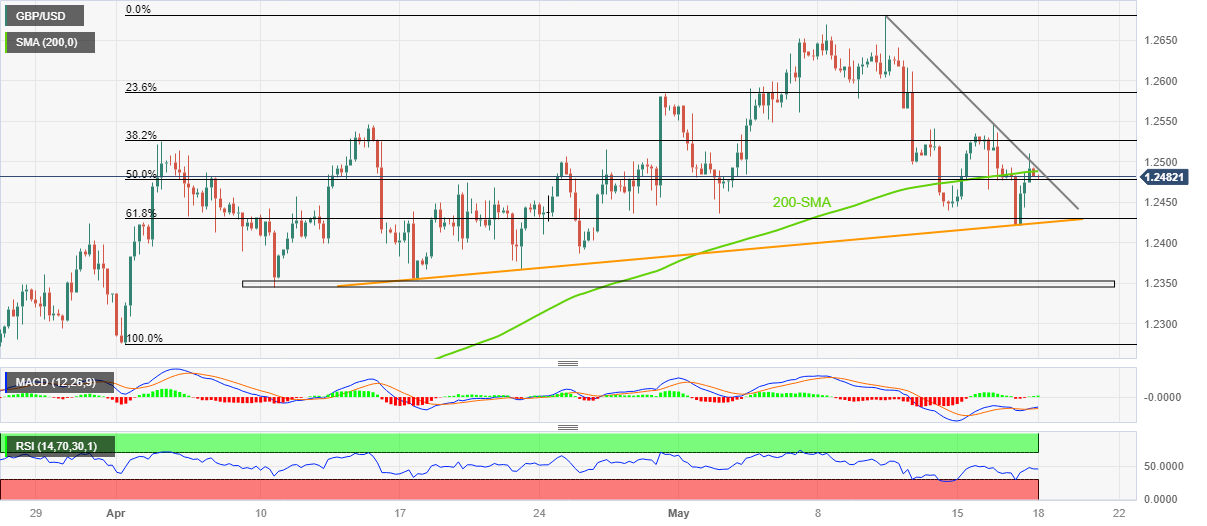
Trend: Limited downside expected
- USD/JPY is looking to refresh its five-month high above 138.00 as the BoJ would continue its ultra-dovish policy.
- The overall market sentiment has turned positive as a raise in the US borrowing cap seems promising.
- Japan’s inflation is expected to soften further due to declining oil prices.
The USD/JPY pair is gathering strength for printing a fresh five-month high above 138.00 in the Asian session. The asset has got immense strength as the Bank of Japan (BoJ) is expected to continue keeping its monetary policy loose enough to sustain inflationary pressures at elevated levels.
S&P500 futures have generated nominal losses in the Asian session. US equities had a ball on Wednesday as investors are confident that the White House and Republican leaders would agree to a deal of raising the US debt ceiling. This has faded fears of catastrophic effects of a default by the US Treasury in augmenting its obligated payments.
The overall market sentiment has turned positive amid a promising deal for raising the US borrowing cap. However, the approval is coming by compromising spending initiatives for the budget.
The US Dollar Index (DXY) has rebounded to near 102.90, however, the downside seems favored as the Federal Reserve (Fed) is expected to pause its rate-hiking spree.
Meanwhile, the Japanese Yen is expected to remain on the tenterhooks ahead of Japan’s inflation data, which is scheduled for Friday. Japan’s National Consumer Price Index (CPI) data (April) will be keenly watched. Headline CPI is seen softening to 2.5% from the former release of 3.2%. Also, the core inflation is expected to decelerate to 3.4% against the prior figure of 3.8%.
Softening of Japan’s inflation data is going to force the Bank of Japan to continue its ultra-dovish interest rate policy. BoJ Governor Kazuo Ueda is committed to keeping inflation steady above 2%, which needs expansionary monetary policy.
| Index | Change, points | Closed | Change, % |
|---|---|---|---|
| NIKKEI 225 | 250.6 | 30093.59 | 0.84 |
| Hang Seng | -417.68 | 19560.57 | -2.09 |
| KOSPI | 14.42 | 2494.66 | 0.58 |
| ASX 200 | -35.5 | 7199.2 | -0.49 |
| FTSE 100 | -27.87 | 7723.23 | -0.36 |
| DAX | 53.37 | 15951.3 | 0.34 |
| CAC 40 | -6.57 | 7399.44 | -0.09 |
| Dow Jones | 408.63 | 33420.77 | 1.24 |
| S&P 500 | 48.87 | 4158.77 | 1.19 |
| NASDAQ Composite | 157.52 | 12500.57 | 1.28 |
April month employment statistics from the Australian Bureau of Statistics, up for publishing at 01:30 GMT on Thursday, will be the immediate catalyst for the AUD/USD pair traders.
Market consensus suggests that the headline Unemployment Rate may remain unchanged at 3.5% on a seasonally adjusted whereas the Employment Change could ease by 25.0K versus the previous addition of 53.0K. Further, the Participation Rate is expected to remain unchanged at 66.7% during the stated month.
Considering the Reserve Bank of Australia’s (RBA) hawkish surprise and the recently mixed Australia Wage Price Index data, today’s Aussie inflation expectations and employment numbers appear more important for the AUD/USD pair.
Ahead of the event, FXStreet’s Matias Salord mentioned,
An upbeat jobs report could trigger a rally in AUD/USD, but its sustainability depends on other factors, mostly external ones. For the pair to break above 0.6800, it looks like a stronger Australian dollar alone is not enough. Positive data could bring the pair closer to the key area.
How could the data affect AUD/USD?
AUD/USD picks up bids to defend the previous day’s rebound from a two-week low even as the buyers appear to lack the strength of late, especially due to the pre-data anxiety. It’s worth noting that the US Dollar’s retreat amid a sluggish session and hopes of upbeat Aussie data seem to favor the risk barometer pair’s recent mildly positive performance.
That said, today’s Australian employment report for April is less likely to work as a positive catalyst for the AUD/USD unless posting an extremely upbeat outcome. The reason could be linked to the market’s favor for the US Dollar amid hopes of no US default and recently hawkish Federal Reserve (Fed) commentary. However, a knee-jerk reaction to the top-tier statistic can’t be ruled out.
Technically, a daily closing beyond convergence of the 21-DMA and 10-DMA, near 0.6685 at the latest, becomes necessary for the AUD/USD bulls to keep the reins. That said, repeated failures to cross 0.6700 keeps the pair sellers hopeful of visiting an upward-sloping support line from early March, close to 0.6610 at the latest.
Key Notes
AUD/USD rebound approaches 0.6700 as US default fears ease, Australia employment eyed
Australian Employment Change Preview: Another strong report?
AUD/USD Price Analysis: Bulls are shaping up a case for a move higher
About the Employment Change
The Employment Change released by the Australian Bureau of Statistics is a measure of the change in the number of employed people in Australia. Generally speaking, a rise in this indicator has positive implications for consumer spending which stimulates economic growth. Therefore, a high reading is seen as positive (or bullish) for the AUD, while a low reading is seen as negative (or bearish).
About the Unemployment Rate
The Unemployment Rate released by the Australian Bureau of Statistics is the number of unemployed workers divided by the total civilian labor force. If the rate hikes, indicates a lack of expansion within the Australian labor market. As a result, a rise leads to weaken the Australian economy. A decrease of the figure is seen as positive (or bullish) for the AUD, while an increase is seen as negative (or bearish).
- AUD/USD bulls are moving in and testing a key short-term resistance.
- An inverse head and shoulders are in the making.
AUD/USD bulls are moving in ahead of the Employment report today. At the time of writing, AUD/USD is trading around 0.6665, a key short-term resistance level as the following charts will illustrate.
AUD/USD daily chart

The M-formation is a reversion pattern that has been pulling the price back up into the bearish impulse on the daily chart as illustrated above. There could be more to come as the following thesis shows in a bullish bias.
AUD/USD H4 charts
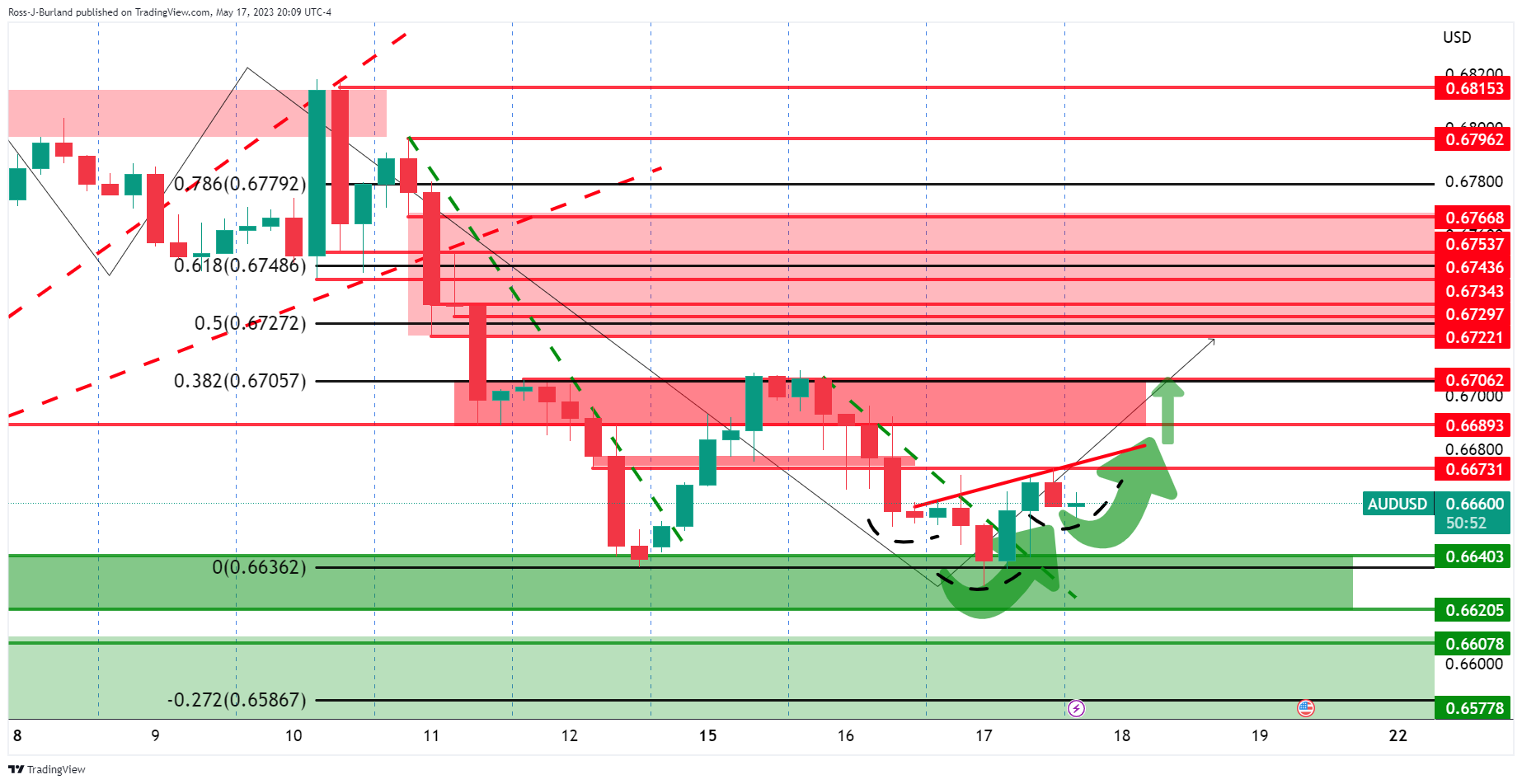
We have a four-hour inverse head and shoulders and a market that is trying to turn higher from support.
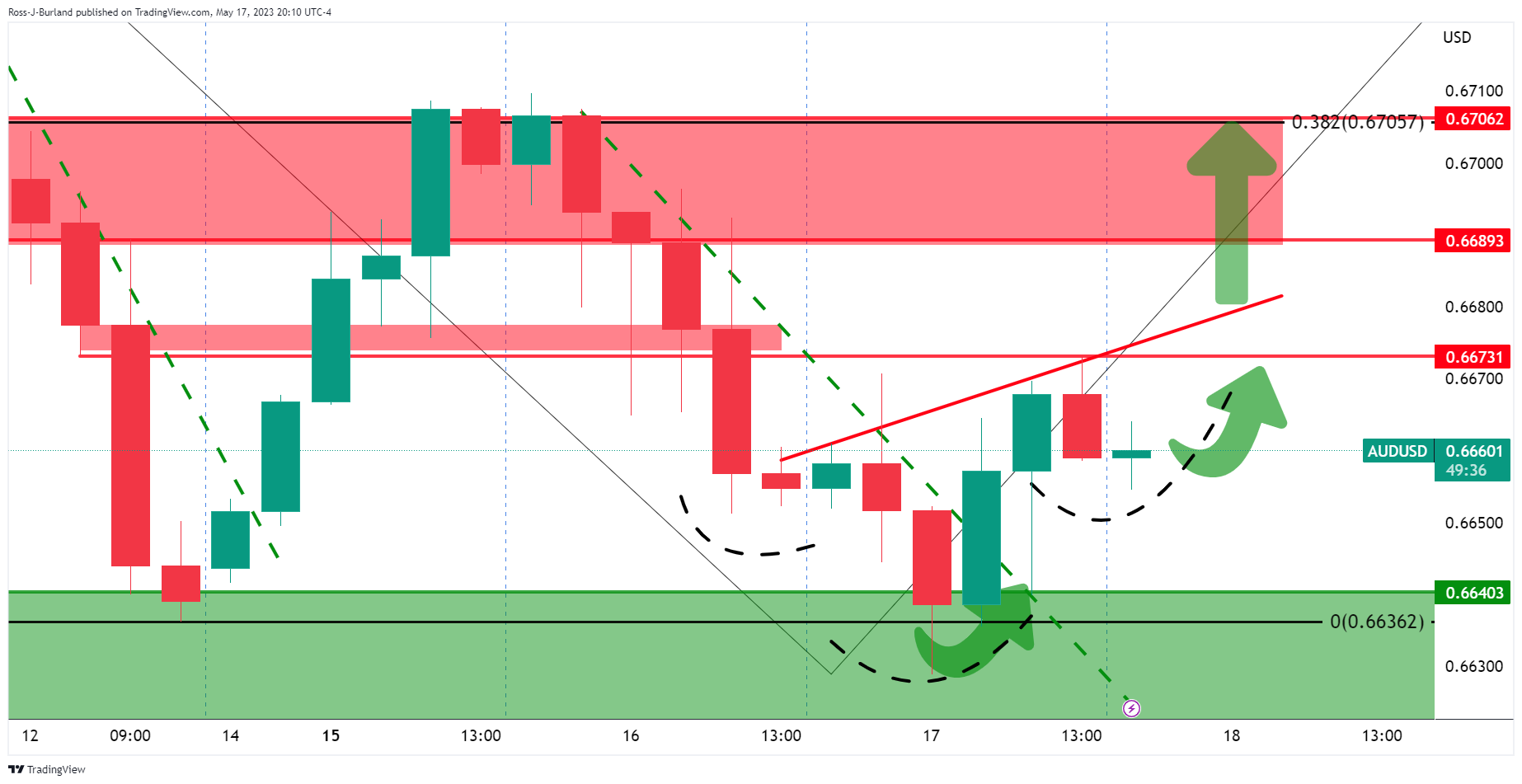
Bulls are on the back side of the prior micro bearish trend and the right-hand shoulder is forming.
AUD/USD H1 chart
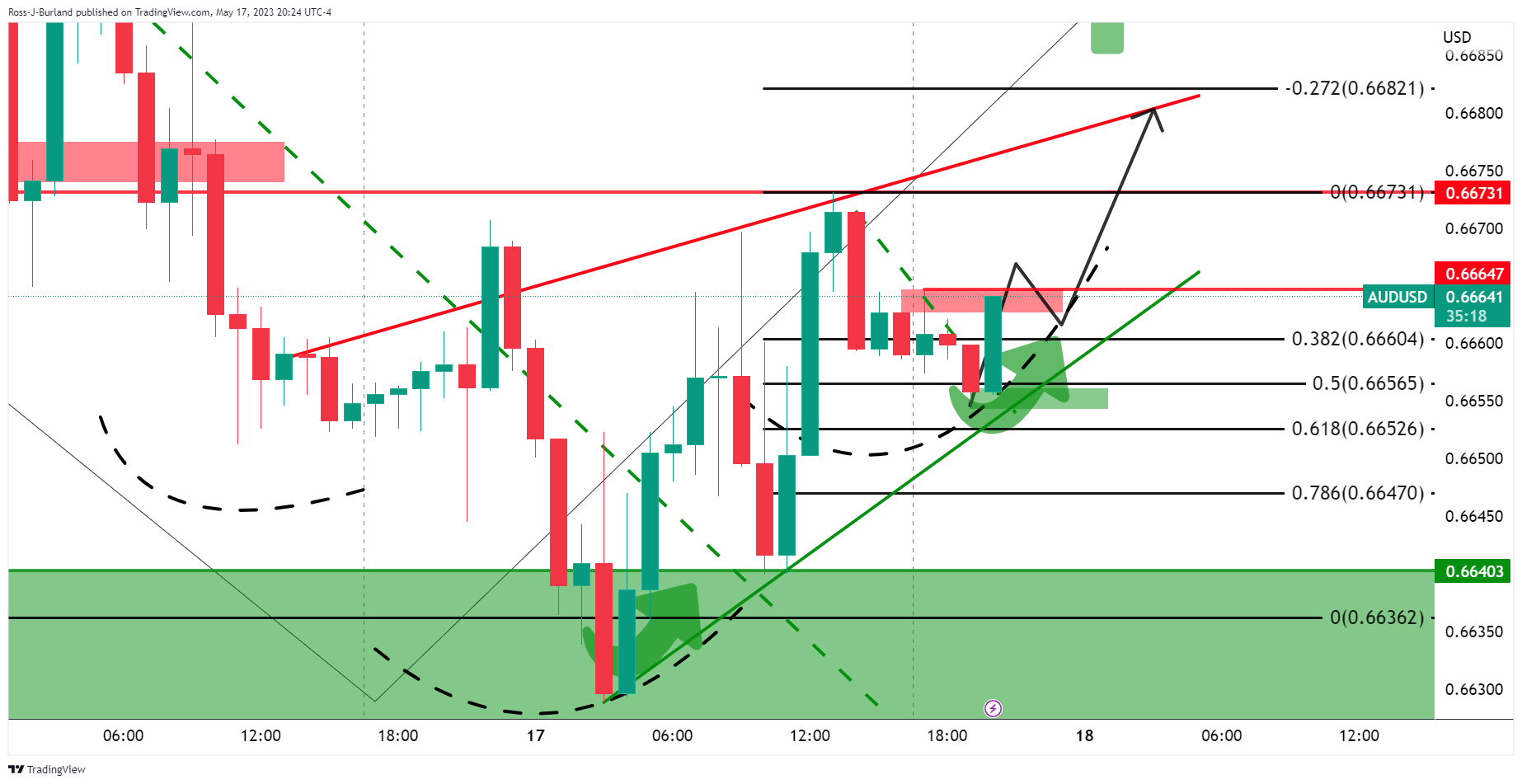
On the hourly chart, the correction into the bullish impulse has completed a 50% mean reversion, deep enough to attract bids from the 0.6650s. A break of the 0.6665 resistance could be the catalyst for firmer demand for the day ahead that will complete the right-hand shoulder.
- Silver price fades bounce off seven-week low, sidelined of late.
- Doji candlestick around 100-EMA support, nearly oversold RSI (14) line lure XAG/USD buyers.
- 50-EMA, bearish MACD signals cap Silver price recovery.
Silver price (XAG/USD) slips off the bear’s radar despite the latest inaction around $23.80-75 during early Thursday morning in Asia.
That said, the bright metal dropped to the lowest levels in seven weeks the previous day before bouncing off the 100-day Exponential Moving Average (EMA). In doing so, the XAG/USD portrayed a Doji candlestick on the daily time frame.
Apart from the reversal suggesting candlestick from the 100-EMA, the nearly oversold RSI (14) also allows the Silver bears to catch a breather.
The XAG/USD recovery, however, appears limited as the $24.00 round figure and the 50-EMA level of near $24.20 challenge the upside amid bearish MACD signals.
In a case where the Silver price rises past $24.20, a 1.5-month-old horizontal resistance area surrounding $24.50-55 could challenge the metal’s further advances.
On the flip side, a daily close below the 100-EMA level of $23.48 becomes necessary to recall the Silver sellers.
Even so, the 50% Fibonacci retracement level of the metal’s March-May upside, near $23.00, precedes the 200-EMA level of $22.80 to restrict the XAG/USD downside.
It’s worth noting that the Golden Fibonacci ratio, the 61.8% mark, around $22.30, appears the last defense of the Silver buyers.
Silver price: Daily chart
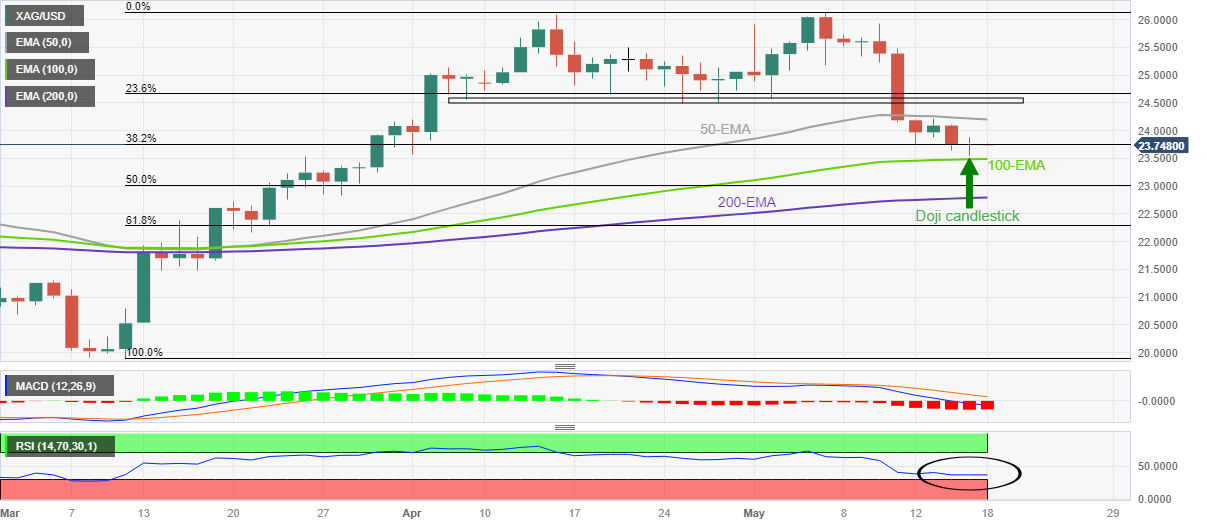
Trend: Limited recovery expected
| Pare | Closed | Change, % |
|---|---|---|
| AUDUSD | 0.66601 | 0.08 |
| EURJPY | 149.096 | 0.68 |
| EURUSD | 1.08395 | -0.21 |
| GBPJPY | 171.756 | 0.91 |
| GBPUSD | 1.24869 | 0.02 |
| NZDUSD | 0.62436 | 0.26 |
| USDCAD | 1.34533 | -0.17 |
| USDCHF | 0.89821 | 0.21 |
| USDJPY | 137.548 | 0.89 |
- The oil price has shown some correction after a surprise build-up of oil inventory data.
- WTI is expected to resume its upside journey amid optimism over the confirmation of the US debt-ceiling raise.
- Expectations of a rate-hike pause by the Fed have fuelled optimism in oil bulls.
West Texas Intermediate (WTI), futures on NYMEX, have shown a marginal correction to near $72.50 after a stellar recovery. The oil price is expected to resume its upside journey amid optimism over the confirmation of the US debt-ceiling raise.
US President Joe Biden has announced that the White House will have a news conference on Sunday. The White House has agreed not to approve the default in which Democrats wanted to raise US borrowing cap without compromising spending initiatives for the budget. Each member attending US debt-ceiling negotiations has admitted that the approval of default will be a disaster.
This has faded fears of a default by the US Treasury in addressing bills by early June, which would have a catastrophic effect on the leadership position and credibility of the American economy.
Apart from that, the catalyst which has fuelled optimism in oil bulls is the fact that the Federal Reserve (Fed) is expected to hold its interest rate policy in June. Fears of a recession are critically higher amid tight credit conditions by United States regional banks and labor market conditions have started easing due to the bleak economic outlook. Therefore, Fed chair Jerome Powell is required to pause the rate-hiking spell to avoid recession ahead.
Meanwhile, The International Energy Agency (IEA) revealed that demand would surpass supply by 2 million barrels per day (bpd) in the second half of the year, with China’s making up 60% of the oil demand increase in 2023, as reported by Reuters.
On Wednesday, the oil price witnessed some selling pressure after the release of a surprise build-up of oil inventories for the week ending May 12. The US Energy Information Administration (EIA) reported a build-up of 5.04 million barrels while the street was anticipating a drawdown of 0.92 million barrels.
© 2000-2025. All rights reserved.
This site is managed by Teletrade D.J. LLC 2351 LLC 2022 (Euro House, Richmond Hill Road, Kingstown, VC0100, St. Vincent and the Grenadines).
The information on this website is for informational purposes only and does not constitute any investment advice.
The company does not serve or provide services to customers who are residents of the US, Canada, Iran, The Democratic People's Republic of Korea, Yemen and FATF blacklisted countries.
Making transactions on financial markets with marginal financial instruments opens up wide possibilities and allows investors who are willing to take risks to earn high profits, carrying a potentially high risk of losses at the same time. Therefore you should responsibly approach the issue of choosing the appropriate investment strategy, taking the available resources into account, before starting trading.
Use of the information: full or partial use of materials from this website must always be referenced to TeleTrade as the source of information. Use of the materials on the Internet must be accompanied by a hyperlink to teletrade.org. Automatic import of materials and information from this website is prohibited.
Please contact our PR department if you have any questions or need assistance at pr@teletrade.global.
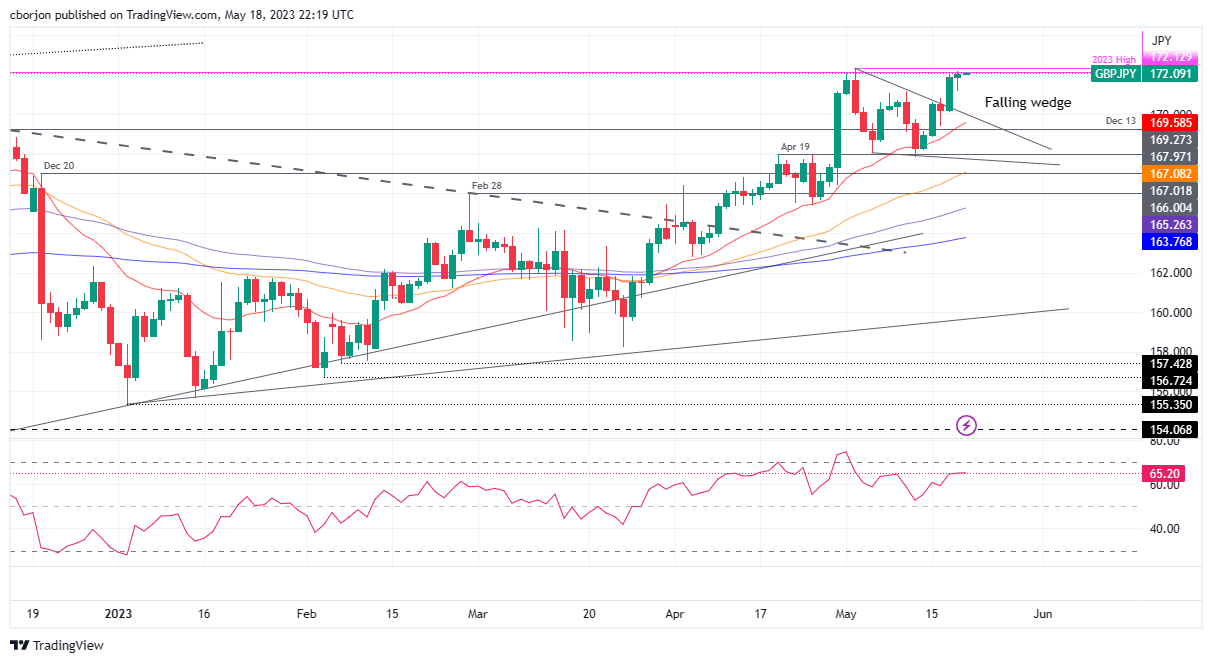
-638199789424693913.png)















